30 EUROPE
In this chapter
- Geography and History
- Religion and Philosophy
- Literature
- Architecture
- Performing Arts
- Visual Arts
GEOGRAPHY and HISTORY
The Crusades
The call to crusade had profound consequences for Islamic and Christian societies. The military fortunes of the crusaders were watched carefully by Muslims and Christians alike, and while the success of the First Crusade was shocking to everyone, to Christians it was also a clear sign of God’s favor. The flaws in the crusading movement grew or became better known over time, however. Fewer Christians joined later crusades, even though the legend and romance of the venture became more popular in the European imagination.
Jerusalem and the Holy Land
Judaism, Christianity, and Islam all have a concept of pilgrimage. Sacred journeys can be undertaken to enhance a person’s connection with God, as an act of penance, or in gratitude. In many ways, they are meant to be transformative.
Jerusalem drew pilgrims from the three monotheistic religions. Pilgrimage had been obligatory for Jewish people until the destruction of the Second Temple in 70 CE, but even after that time, the city continued to play a special role in Jewish life. In the earliest decades of the first century, it had also become the location for some of the most dramatic and important scenes in the life of Jesus and the early Christian community. In the time of Constantine, a church had been built over the site of what was believed to be Jesus’s tomb, called the Holy Sepulchre. As the place where it is believed Jesus was crucified and resurrected, Jerusalem was bound up with the most essential Christian beliefs. Even in the ancient world, Christians undertook pilgrimages to this holiest of cities (Figure 13.18).
In Christian Europe, the reforms of the church emphasized the earthly life of Jesus, and the idea of being able to see and touch the physical land where he walked filled the imagination of both the clergy and the laity. The image of heaven as a “heavenly Jerusalem” in the writing of monks and nuns heightened the common desire to see the earthly Jerusalem. The report that the Fatimid caliph al-Hakim had destroyed the Church of the Holy Sepulchre outraged Christians, even though his son permitted its rebuilding. It is no coincidence, then, that the term medieval people most often associated with the crusading movement (before the term “crusade” was coined) was pilgrimage, or more specifically, armed pilgrimage.
The bulk of the First Crusade was directed by powerful aristocrats whose armies were better organized and prepared to fight than Peter’s, even if most of its participants were not the most senior nobles of Western society. Alexios promised them aid in exchange for the return of Byzantine territory held by Muslims, which most initially agreed to. The crusaders crossed Anatolia and, after laying a bloody siege with little help from the Byzantines, took control of the port of Antioch, an ancient seat of Christianity in the Holy Land. After their victory, they felt Alexios was undeserving of either the city or their fidelity. The city was thus given to a Norman crusader who had no intention of delivering it to Alexios, straining the relationships between the crusaders and the Byzantine Empire.
The First Crusade finally reached Jerusalem in the summer of 1099. Before attacking the city, the crusaders fasted and walked around its walls as penitents, an act that shows the blending of pilgrimage with armed conflict. The crusaders then took the city, and in an act that shocked Muslims and Christians alike, they massacred the Muslim and Jewish inhabitants. The crusading armies then took other important cities in the area, and to secure their control they established the four Crusader States: the County of Edessa, the Principality of Antioch, the County of Tripoli, and the Kingdom of Jerusalem. These Crusader States were also called Outremer (literally “overseas”) by the French, and they claimed Jerusalem as their capital (Figure 13.20). Of all the Crusades, this was the only one that accomplished its objective.
Despite the surprising success of the First Crusade, Outremer suffered some critical problems from the beginning. The crusaders had alienated the Byzantine Empire by not returning to it important cities like Antioch or lands in the Middle East as they had promised. The European aristocrats and knights were eager to acquire lands for themselves, which meant they often fought with each other even when faced with a common enemy. And while there was always at least a trickle of warriors who made it to Outremer, the elite remained in desperate need of soldiers to defend their new territories.
The Muslims’ confusion about the nature and goals of the crusaders, as well as internal conflicts among them, initially dampened their political and military response. The Muslims adapted quickly, however, especially the Seljuks who prevented many of the newly arriving knights from ever reaching Outremer. A Turkic aristocrat named Imad al-Din Zengi began to cultivate the image of a holy warrior opposing the crusaders. While he spent most of his career ruthlessly scheming against other Muslim rulers, he managed to take the city of Edessa, in the northernmost of the Crusader States. He was praised as a defender of Islam, but he was assassinated before he could continue his campaign against the crusaders. The loss of Edessa posed a serious threat to the remaining Crusader States, however, and prompted the pope to call the Second Crusade.
The Second Crusade, from 1147 to 1149, was heralded by a new generation of preachers like Bernard of Clairvaux who inspired believers to “take up the cross.” Bernard also wrote the rules for the Knights Templar, one of the new crusading orders, religious orders of monks devoted to protecting Christian pilgrims and fighting to support Outremer. This crusade was led by powerful rulers, including King Louis VII of France and King Conrad III of Germany (Figure 13.21). The armies of the Second Crusade were defeated in Anatolia in separate battles, and few soldiers reached the Holy Land. The kings accomplished very little, and many blamed the Byzantine emperor, who had learned to be distrustful of European armies. Bernard of Clairvaux was humiliated and apologized to the pope, claiming the sins of the crusaders had caused the defeat. It was a disaster that seemed as complete as the First Crusade had looked miraculous.
After this loss, the situation for Outremer only became more dire. Imad al-Din Zengi’s successors were well liked, even by crusaders, and they strove to unite the Muslim princes in jihad. The most famous of these successors was Salah al-Din, or Saladin in the Christian world. He was known for being humane, fair-minded, and, in Christians terms, chivalrous. He expanded his territory from Syria into Egypt and founded a new dynasty called the Ayyubids from the ashes of the Shia Fatimid Caliphate. He also took up his religious calling to wage jihad against the crusaders. In 1187, after years of gathering allies and eroding the military power of Outremer, he destroyed the crusaders at the Battle of the Horns of Hattin (in today’s Israel). Within months, Jerusalem fell to Saladin.
The Christians’ response was the Third Crusade (1189–1192). This crusade was prompted both by the fear that Outremer was about to be wiped off the map and by the desire to retake Jerusalem. Kings from England, the Holy Roman Empire, and France as well as other powerful princes answered the call. When they arrived in the last remaining Christian outposts in the Middle East, they quickly fell to squabbling with each other and the aristocracy of Outremer. As a result, the Christians were able to conquer the island of Cyprus and the coastline of the Holy Land but were unable to move farther inland. Eventually, Richard I of England, known in popular stories as Richard the Lionhearted, negotiated a treaty with Saladin that left Jerusalem under Muslim control but allowed Christian pilgrims to freely visit the city. Both Saladin and Richard were praised as examples of chivalric virtue in Europe and heroes of their respective religions. But this was one of the last successes the crusaders were to have in the Holy Land.
Copyright: Kordas, A., Lynch, R., Nelson, B., & Tatlock, J. (2023). The Crusading Movement. In World History Volume 1, to 1500. OpenStax.
The Origins and Spread of the Bubonic Plague
The bubonic plague, the most common variant of the disease caused by the bacterium Yersinia pestis, raises egg-shaped swellings known as buboes near an afflicted person’s lymph nodes in the groin, underarm, and upper neck areas. Other symptoms include fever, nausea, vomiting, aching joints, and general malaise. For the vast majority in the Middle Ages, death generally occurred within three days. The bubonic plague pandemic, which had far-reaching economic, political, social, and cultural effects throughout Afro-Eurasia, came to be known as the Black Death. This name, inspired by the blackened tissue the disease caused on the body, also came to express the fear and awe brought by a disease with a mortality rate ranging from 30 to 80 percent. That is significantly higher than the deadliest smallpox, influenza, and polio pandemics of the modern era. Although in its bubonic form the plague could not be spread from human to human, the rat flea became a major plague vector, an organism that spreads plague from one organism to another.
The black rat was one of the most capable animal hosts for the plague-carrying fleas. It was highly susceptible to the disease itself and an especially inconspicuous stowaway on trade caravans and merchant ships. Cases of bubonic plague proliferated as rats spread through the international shipping and trades routes of the Silk Roads and the Mediterranean Sea, where they colonized crowded dwellings in towns and cities. The spread of the plague only increased owing to the increased movement of people. First it was the Mongol armies, traveling over enormous distances and unintentionally bringing small mammalian stowaways among their foodstuffs. Then, owing to the Mongols’ protection of merchants and others traveling great distances during the Pax Mongolica, the disease spread further and in new directions. Finally, those forced to leave their homes for survival amid famine and environmental change created yet another pathway for the disease to spread.
Plague-bearing fleas generally preferred to feed on small rodents such as rats and marmots, but when their rodent hosts succumbed to the plague, they secured their next meal from the nearest human. Two even deadlier variants of the disease eventually emerged during the fourteenth century: pneumonic and septicemic. The pneumonic form directly infected the lungs and was spread from person to person by coughing, with a mortality rate of 95 to 100 percent. The septicemic variant, which resulted from plague bacteria circulating directly into the bloodstream, was invariably fatal and, according to contemporary observers, seemed to kill within hours of the first onset of symptoms. While historians had surmised for many decades that the plague had spread in primarily one form (bubonic) and in one direction (east to west), new evidence increasingly suggests there was a far greater diversity of spread.
Although in many regions where it struck the plague was eventually understood to be contagious, at first the means of transmission were not recognized. Some saw the epidemic as a divine punishment from God, and others speculated that it was caused by a rare conjunction of planets creating noxious atmospheric conditions on Earth. Others blamed foreign travelers, minority religious communities, or vagrants. The desperation incited by the plague’s relentless assault often led to scapegoating of marginalized populations, particularly in Europe.
As the plague began wreaking havoc in the Mamluk Sultanate, it was also making its way to the ports of Europe via Silk Roads trade caravans and merchant ships sailing the Black Sea in 1346–1347. After striking the Mongol-controlled cities of Astrakhan and Sarai (in present-day Russia), when bales of flea-infested marmot fur were unloaded, the plague then traveled down the River Don, where it reached the city of Caffa (present-day Feodosiya, Ukraine), a center of trade on the Crimean Peninsula.
The plague’s entry point into Europe, Caffa was also the site of a Mongol siege targeting Genoese traders who had taken refuge in the city. Gabriele de Mussis, an Italian notary clerk who witnessed the siege, wrote a gruesome account of the Mongols’ efforts to launch plague-ridden corpses into the city. Although its reliability is difficult to establish, the story nevertheless demonstrates that even though the role of microbes was not yet known, dead bodies were believed to be sources of contagion. But the plague was most likely spread to Caffa by flea-infested rats independent of the Mongol siege. Caffa had long served as an important administrative center of Genoese trade, and its port was a major hub of merchant activity.
From Caffa, the plague made its way to Italy in the summer of 1347, when plague-bearing rats boarded ships headed across the Black Sea, through the Dardanelles, and onward to the ports of Messina and Genoa. From there, the disease was carried to the port of Marseilles and spread into the European interior along rivers, paths, and roads, leaving perhaps as many as twenty-four million dead, roughly 30 percent of the continent’s population at the time.
The plague’s arrival in Europe occurred after a period of economic contraction following a series of famines and crop failures earlier in the fourteenth century. In the early 1300s, a rising population and a relative decline in agricultural productivity had created an economic crisis and falling standards of living for all but the most privileged elites. For the vast majority of people living at the lower end of the economic spectrum, falling wages led to limited resources, poorer diets, and widespread malnourishment. Well before the plague’s arrival in the 1340s, the European population was reeling from years of economic decline and poor nutrition, which may have weakened immune systems and made some people more vulnerable to attacks of infectious disease.
In addition to the demographic and economic impacts of the Black Death era, modes of artistic and literary expression were significantly transformed in response to the plague’s devastation. In the visual arts, the fears engendered by the omnipresence of death and decay initiated a new emphasis on realism that grappled with themes of salvation and mortality. Macabre representations of deathbed scenes and dancing skeletons became especially prominent reminders of the inevitability of death and fears of hell and damnation (Figure 16.14). Although the visual iconography of death reflected the collective cultural trauma associated with the plague, it also served as a potent reminder to celebrate life in the face of it.
The desperation and zealotry that inspired some responses to the plague in medieval Europe are perhaps best seen in the appearance of flagellants, people who believed that by publicly flogging themselves, they could atone for the sins of humanity and mitigate divine retribution. After this idea originated in Eastern Europe and took root in Germany, the flagellants traveled from town to town, reciting penitential verses and lashing themselves with leather whips until they drew blood. They were usually welcomed by townspeople who hoped they could bring an end to the plague epidemic. Occasionally, their rhetoric took an anti-Semitic turn, accusing the Jewish people of causing the plague to annihilate Christendom. The flagellants were active through much of Europe in the early years of the plague pandemic and may have even spread the disease through their contaminated blood. As a result of their increasingly radical orientation, however, by 1349 flagellants had been officially condemned by Pope Clement VI, and they ultimately faded into oblivion in the fifteenth century.
The plague left each region it affected with long-term economic and demographic consequences, including widespread depopulation and cyclic outbreaks of the disease in the fourteenth and fifteenth centuries. Old systems of belief came into question, and ancient social hierarchies shifted to accommodate the significant population losses that followed the plague. Peasants, laborers, and those at the lower end of the socioeconomic hierarchy tended to experience the greatest mortality, but for those who survived, pronounced labor shortages led to the demise of some industries and more favorable working conditions in others. The disadvantaged began to question whether social elites really did enjoy God’s privilege, as the social hierarchy generally preached, since they too succumbed to the plague and failed to care for those to whom they bore responsibility.
Copyright: Kordas, A., Lynch, R., Nelson, B., & Tatlock, J. (2023). The Crusading Movement. In World History Volume 1, to 1500. OpenStax.
RELIGION and PHILOSOPHY
Thomas Aquinas
Thomas Aquinas (1225–1274) is the quintessential Scholastic philosopher, whose many works determined the course of European philosophy for generations. Somewhat like Immanuel Kant (1724–1804) several centuries later, philosophers after Aquinas knew that they would have to contend with his writings, either by extending his project or critiquing it. Aquinas saw that Scholastic philosophy needed to be reinvigorated, and he introduced the work of Jewish and Islamic philosophers to medieval Christian thought, bringing new ideas and approaches to philosophy (Van Norden 2017).
Aquinas is probably best known for his five ways to demonstrate the existence of God. The five ways are considered natural theology because Aquinas does not depend upon the authority of the church to justify the existence of God. Instead, he writes that we can define God in five ways: as an unmoved mover, first cause, necessary being, absolute being, and grand designer. In order to avoid an infinite regress, we must assume an unmoved mover who put all the entities into motion. Similarly, God is the first cause of everything that exists, or else we face an infinite causal regress. Everything that exists has contingent existence, save for God. God is the necessary being upon which every contingent being depends. Contingent beings have qualities that are relative to one another (bigger and smaller, etc.), which entails an absolute being to whom all these are relative. Finally, the evidence of design in the world implies a grand designer. All natural bodies act to achieve an end. For example, an acorn gives rise to a tree. However, not all natural bodies are aware of and able to direct themselves to achieve this end. Therefore, an intelligent being must exist to guide these natural beings toward their end.
We can see Aristotle’s influence in the metaphysics and epistemology of Aquinas as well as in his ethics and political philosophy. Aristotle defined God as the prime mover and “thought thinking itself.” We can discern the influence of this idea in Aquinas’s Five Ways. Aquinas also adopted Aristotle’s virtue ethics and adapted them to his Christian context.
Copyright: Smith, N. (2022). Thomas Aquinas. In Introduction to Philosophy. OpenStax.
LITERATURE
Song of Roland
Anonymous or possibly composed by a poet named Turold 1075-1100
Composed ca. eleventh century CE
French
The Song of Roland is actually founded upon an historical event, the Battle of Roncevaux Pass (778 CE), in which Roland, commander of the rear guard of Charlemagne’s army, was defeated by the Basques. This chanson de geste (“song of mighty deeds”) provides a powerful fusion of Germanic warrior and Christian cultures. The Song briskly moves its source material into a mythic dimension, with a 200 year old, semi-divine Charlemagne assigning his twelve peers and their troops to guard a high mountain pass in the Pyrenees against attack by 400,000 Saracen Muslims (an obvious epic inflation). In the figure of Ganelon, stepfather of Roland who betrays him, the epic depicts the qualities most abhorred by a warrior culture, deceit and disloyalty. In the figure of the martyred and brave—even to a point of rashness—Roland, the epic creates an ideal of the masculine fighting hero, despite the fact that he would have done well to listen to the advice of his wise friend Oliver. Composed of various threads from the oral tradition and written down sometime in the eleventh century, the Song of Roland served as an inspiration for the Crusaders. As such, it offers a particularly scurrilous portrait of Muslim warriors as cowards and villains who worship pagan deities. One of the first works in the French literary tradition, the Song of Roland memorializes its militant Christian culture through vivid description and dramatic action, especially in its set-pieces of hand-to hand combat. In proclaiming that “pagans are wrong and the Christians are right,” the epic offers a world of moral absolutes with little room for shadings.
Written by Doug Thomson from World Literature I: Beginnings to 1650 is licensed under a Creative Commons Attribution-ShareAlike 4.0
International License.
Song of Roland
LXXX
Oliver mounts upon a lofty peak,
Looks to his right along the valley green,
The pagan tribes approaching there appear;
He calls Roland, his companion, to see:
“What sound is this, come out of Spain, we hear,
What hauberks** bright, what helmets these that gleam? (**long coat of chail mail)
They’ll smite our Franks with fury past belief,
He knew it, Guenes, the traitor and the thief,
Who chose us out before the King our chief.”
Answers the count Roland: “Olivier, cease.
That man is my good-father; hold thy peace.”
LXXXI
Upon a peak is Oliver mounted,
Kingdom of Spain he sees before him spread,
And Saracens, so many gathered.
Their helmets gleam, with gold are jewelled,
Also their shields, their hauberks orfreyed,
Also their swords, ensigns on spears fixed.
Rank beyond rank could not be numbered,
So many there, no measure could he set.
In his own heart he’s sore astonished,
Fast as he could, down from the peak hath sped
Comes to the Franks, to them his tale hath said.
LXXXII
Says Oliver: “Pagans from there I saw;
Never on earth did any man see more.
Gainst us their shields an hundred thousand bore,
That laced helms and shining hauberks wore;
And, bolt upright, their bright brown spearheads shone.
Battle we’ll have as never was before.
Lords of the Franks, God keep you in valour!
So hold your ground, we be not overborne!”
Then say the Franks “Shame take him that goes off:
If we must die, then perish one and all.”
LXXXIII
Says Oliver: “Pagans in force abound,
While of us Franks but very few I count;
Comrade Roland, your horn I pray you sound!
If Charlemagne hear, he’ll turn his armies round.”
Answers Roland: “A fool I should be found;
In France the France would perish my renown.
With Durendal** I’ll lay on thick and stout, (**Roland’s sword)
In blood the blade, to its golden hilt, I’ll drown.
Felon pagans to th’ pass shall not come down;
I pledge you now, to death they all are bound.
LXXXIV
“Comrade Roland, sound the olifant**, I pray; (**Roland’s horn, made from elephant tusk)
If Charlemagne hear, the host he’ll turn again;
Will succour us our King and baronage.”
Answers Roland: “Never, by God, I say,
For my misdeed shall kinsmen hear the blame,
Nor France the France fall into evil fame!
Rather stout blows with Durendal I’ll lay,
With my good sword that by my side doth sway;
Till bloodied o’er you shall behold the blade.
Felon pagans are gathered to their shame;
I pledge you now, to death they’re doomed to-day.”
LXXXV
“Comrade Roland, once sound your olifant!
If Charlemagne hear, where in the pass he stands,
I pledge you now, they’ll turn again, the Franks.”
“Never, by God,” then answers him Roland,
“Shall it be said by any living man,
That for pagans I took my horn in hand!
Never by me shall men reproach my clan.
When I am come into the battle grand,
And blows lay on, by hundred, by thousand,
Of Durendal bloodied you’ll see the brand.
Franks are good men; like vassals brave they’ll stand;
Nay, Spanish men from death have no warrant.”
LXXXVI
Says Oliver: “In this I see no blame;
I have beheld the Saracens of Spain;
Covered with them, the mountains and the vales,
The wastes I saw, and all the farthest plains.
A muster great they’ve made, this people strange;
We have of men a very little tale.”
Answers Roland: “My anger is inflamed.
Never, please God His Angels and His Saints,
Never by me shall Frankish valour fail!
Rather I’ll die than shame shall me attain.
Therefore strike on, the Emperour’s love to gain.”
LXXXVII
Pride hath Roland, wisdom Olivier hath;
And both of them shew marvellous courage;
Once they are horsed, once they have donned their arms,
Rather they’d die than from the battle pass.
Good are the counts, and lofty their language.
Felon pagans come cantering in their wrath.
Says Oliver: “Behold and see, Roland,
These are right near, but Charlemagne is very far.
On the olifant deign now to sound a blast;
Were the King here, we should not fear damage.
Only look up towards the Pass of Aspre,
In sorrow there you’ll see the whole rereward.
Who does this deed, does no more afterward.”
Answers Roland: “Utter not such outrage!
Evil his heart that is in thought coward!
We shall remain firm in our place installed;
From us the blows shall come, from us the assault.”
LXXXVIII
When Roland sees that now must be combat,
More fierce he’s found than lion or leopard;
The Franks he calls, and Oliver commands:
“Now say no more, my friends, nor thou, comrade.
That Emperour, who left us Franks on guard,
A thousand score stout men he set apart,
And well he knows, not one will prove coward.
Man for his lord should suffer with good heart,
Of bitter cold and great heat bear the smart,
His blood let drain, and all his flesh be scarred.
Strike with thy lance, and I with Durendal,
With my good sword that was the King’s reward.
So, if I die, who has it afterward
Noble vassal’s he well may say it was.”
LXXXIX
From the other part is the Archbishop Turpin,
He pricks his horse and mounts upon a hill;
Calling the Franks, sermon to them begins:
“My lords barons, Charlemagne left us here for this;
He is our King, well may we die for him:
To Christendom good service offering.
Battle you’ll have, you all are bound to it,
For with your eyes you see the Saracens.
Pray for God’s grace, confessing Him your sins!
For your souls’ health, I’ll absolution give
So, though you die, blest martyrs shall you live,
Thrones you shall win in the great Paradis.”
The Franks dismount, upon the ground are lit.
That Archbishop God’s Benediction gives,
For their penance, good blows to strike he bids.
XC
The Franks arise, and stand upon their feet,
They’re well absolved, and from their sins made clean,
And the Archbishop has signed them with God’s seal;
And next they mount upon their chargers keen;
By rule of knights they have put on their gear,
For battle all apparelled as is meet.
The count Roland calls Oliver, and speaks
“Comrade and friend, now clearly have you seen
That Guenelun hath got us by deceit;
Gold hath he ta’en; much wealth is his to keep;
That Emperour vengeance for us must wreak.
King Marsilies hath bargained for us cheap;
At the sword’s point he yet shall pay our meed.”
XCI
To Spanish pass is Roland now going
On Veillantif, his good steed, galloping;
He is well armed, pride is in his bearing,
He goes, so brave, his spear in hand holding,
He goes, its point against the sky turning;
A gonfalon all white thereon he’s pinned,
Down to his hand flutters the golden fringe:
Noble his limbs, his face clear and smiling.
His companion goes after, following,
The men of France their warrant find in him.
Proudly he looks towards the Saracens,
And to the Franks sweetly, himself humbling;
And courteously has said to them this thing:
“My lords barons, go now your pace holding!
Pagans are come great martyrdom seeking;
Noble and fair reward this day shall bring,
Was never won by any Frankish King.”
Upon these words the hosts are come touching.
XCII
Speaks Oliver: “No more now will I say.
Your olifant, to sound it do not deign,
Since from Carlun you’ll never more have aid.
He has not heard; no fault of his, so brave.
Those with him there are never to be blamed.
So canter on, with what prowess you may!
Lords and barons, firmly your ground maintain!
Be minded well, I pray you in God’s Name,
Stout blows to strike, to give as you shall take.
Forget the cry of Charlemagne we never may.”
Upon this word the Franks cry out amain.
Who then had heard them all “Monjoie**!” acclaim (**my joy)
Of vassalage might well recall the tale.
They canter forth, God! with what proud parade,
Pricking their spurs, the better speed to gain;
They go to strike,—what other thing could they?—
But Saracens are not at all afraid.
Pagans and Franks, you’d see them now engaged.
Sir Gawain and the Green Knight
Arthurian romances were a popular genre of the High and Late Middle Ages. Arthur was considered to the be the ideal king, serving unerringly God and Country. The Arthurian tales include stories about the knights that stood by Arthur’s side and served him gallantly. Gawain was often touted as the most chivalric and honorable of all of the knights at the round table. There are many English poems that bear his name, even if he might only play a minor role in the story (i.e., Ywain and Gawain). Even in Marie de France’s Lanval, Gawain makes a brief, albeit important appearance. So, while there are many stories that were circulating about the great knight Gawain, probably the most well-known and most beautifully written of the Gawain tales is Sir Gawain and the Green Knight. This is a stunningly wonderful poem utilizing a variety of poetic elements, ornate language and at the same time, “just a cracking good read!” We do not know who wrote this text, so he is often just referred to as “The Gawain Poet.” The text is thought to be written in c. 1375-1400—which is contemporaneous with Chaucer. SGGKsurvives in a single manuscript—three other texts, presumably written by the same author, are found the same manuscript (MS): Pearl, Patience, and Purity. As you will note as you finish the tale, the role of the girdle/garter places an important role.
Take special note of the Middle French phrase that ends the tale: Honi Soit Qui Mal Pense (“Shame be to the man who has evil in his mind”). This is the motto of the Order of the Garter, a chivalric order founded in 1348 by Edward III. The scribe who transcribed Sir Gawain and the Green Knightmight have been associated with the Order, but at the very least knew of the Order and its motto. The Order and the inscription make for an interesting, if not mythological and legendary connection between life and fiction. The Order of the Garter still exists today as the oldest order of knighthood in continuous existence and remains one of the highest, most exclusionary orders in the UK—admittance is only granted by the monarch at her/his discretion. As you read, consider how Gawain, the most celebrated and chivalric of knights is treated. What elements of chivalry are at work and how does this compare to the contemporary image of the questing knight? What makes Gawain so chivalrous and does he live up to these expectations—think about how he is positioned in the trading game he plays with his host, Bertilak. As one of the most famous Gawain tales, if not of all English Arthurian legends, what does this text tell us about medieval culture and ideal knights? Why does this text endure so long and receive so much attention?
Sir Gawain and the Green Knight. Trans. Jessie Weston. London: David Nutt, 1898.
King Arthur lay at Camelot upon a Christmas-tide, with many a gallant lord and lovely lady, and all the noble brotherhood of the Round Table. There they held rich revels with gay talk and jest; one while they would ride forth to joust and tourney, and again back to the court to make carols; 2 for there was the feast holden fifteen days with all the mirth that men could devise, song and glee, glorious to hear, in the daytime, and dancing at night. Halls and chambers were crowded with noble guests, the bravest of knights and the loveliest of ladies, and Arthur himself was the comeliest king that ever held a court. For all this fair folk were in their youth, the fairest and most fortunate under heaven, and the king himself of such fame that it were hard now to name so valiant a hero.
Now the New Year had but newly come in, and on that day a double portion was served on the high table to all the noble guests, and thither came the king with all his knights, when the service in the chapel had been sung to an end. And they greeted each other for the New Year, and gave rich gifts, the one to the other (and they that received them were not wroth, that may ye well believe!), and the maidens laughed and made mirth till it was time to get them to meat. Then they washed and sat them down to the feast in fitting rank and order, and Guinevere the queen, gaily clad, sat on the high daïs. Silken was her seat, with a fair canopy over her head, of rich tapestries of Tars, embroidered, and studded with costly gems; fair she was to look upon, with her shining grey eyes, a fairer woman might no man boast himself of having seen.
But Arthur would not eat till all were served, so full of joy and gladness was he, even as a child; he liked not either to lie long, or to sit long at meat, so worked upon him his young blood and his wild brain. And another custom he had also, that came of his nobility, that he would never eat upon an high day till he had been advised of some knightly deed, or some strange and marvellous tale, of his ancestors, or of arms, or of other ventures. Or till some stranger knight should seek of him leave to joust with one of the Round Table, that they might set their lives in jeopardy, one against another, as fortune might favour them. Such was the king’s custom when he sat in hall at each high feast with his noble knights, therefore on that New Year tide, he abode, fair of face, on the throne, and made much mirth withal.
Thus the king sat before the high tables, and spake of many things; and there good Sir Gawain was seated by Guinevere the queen, and on her other side sat Agravain, à la dure main; 3 both were the king’s sister’s sons and full gallant knights. And at the end of the table was Bishop Bawdewyn, and Ywain, King Urien’s son, sat at the other side alone. These were worthily served on the daïs, and at the lower tables sat many valiant knights. Then they bare the first course with the blast of trumpets and waving of banners, with the sound of drums and pipes, of song and lute, that many a heart was uplifted at the melody. Many were the dainties, and rare the meats, so great was the plenty they might scarce find room on the board to set on the dishes. Each helped himself as he liked best, and to each two were twelve dishes, with great plenty of beer and wine.
Now I will say no more of the service, but that ye may know there was no lack, for there drew near a venture that the folk might well have left their labour to gaze upon. As the sound of the music ceased, and the first course had been fitly served, there came in at the hall door one terrible to behold, of stature greater than any on earth; from neck to loin so strong and thickly made, and with limbs so long and so great that he seemed even as a giant. And yet he was but a man, only the mightiest that might mount a steed; broad of chest and shoulders and slender of waist, and all his features of like fashion; but men marvelled much at his colour, for he rode even as a knight, yet was green all over.
For he was clad all in green, with a straight coat, and a mantle above; all decked and lined with fur was the cloth and the hood that was thrown back from his locks and lay on his shoulders. Hose had he of the same green, and spurs of bright gold with silken fastenings richly worked; and all his vesture was verily green. Around his waist and his saddle were bands with fair stones set upon silken work, ’twere too long to tell of all the trifles that were embroidered thereon–birds and insects in gay gauds of green and gold. All the trappings of his steed were of metal of like enamel, even the stirrups that he stood in stained of the same, and stirrups and saddle-bow alike gleamed and shone with green stones. Even the steed on which he rode was of the same hue, a green horse, great and strong, and hard to hold, with broidered bridle, meet for the rider.
The knight was thus gaily dressed in green, his hair falling around his shoulders; on his breast hung a beard, as thick and green as a bush, and the beard and the hair of his head were clipped all round above his elbows. The lower part of his sleeves were fastened with clasps in the same wise as a king’s mantle. The horse’s mane was crisp and plaited with many a knot folded in with gold thread about the fair green, here a twist of the hair, here another of gold. The tail was twined in like manner, and both were bound about with a band of bright green set with many a precious stone; then they were tied aloft in a cunning knot, whereon rang many bells of burnished gold. Such a steed might no other ride, nor had such ever been looked upon in that hall ere that time; and all who saw that knight spake and said that a man might scarce abide his stroke.
The knight bore no helm nor hauberk, neither gorget nor breast-plate, neither shaft nor buckler to smite nor to shield, but in one hand he had a holly-bough, that is greenest when the groves are bare, and in his other an axe, huge and uncomely, a cruel weapon in fashion, if one would picture it. The head was an ell-yard long, the metal all of green steel and gold, the blade burnished bright, with a broad edge, as well shapen to shear as a sharp razor. The steel was set into a strong staff, all bound round with iron, even to the end, and engraved with green in cunning work. A lace was twined about it, that looped at the head, and all adown the handle it was clasped with tassels on buttons of bright green richly broidered.
The knight rideth through the entrance of the hall, driving straight to the high daïs, and greeted no man, but looked ever upwards; and the first words he spake were, “Where is the ruler of this folk? I would gladly look upon that hero, and have speech with him.” He cast his eyes on the knights, and mustered them up and down, striving ever to see who of them was of most renown.
Then was there great gazing to behold that chief, for each man marvelled what it might mean that a knight and his steed should have even such a hue as the green grass; and that seemed even greener than green enamel on bright gold. All looked on him as he stood, and drew near unto him wondering greatly what he might be; for many marvels had they seen, but none such as this, and phantasm and faërie did the folk deem it. Therefore were the gallant knights slow to answer, and gazed astounded, and sat stone still in a deep silence through that goodly hall, as if a slumber were fallen upon them. I deem it was not all for doubt, but some for courtesy that they might give ear unto his errand.
Then Arthur beheld this adventurer before his high daïs, and knightly he greeted him, for fearful was he never. “Sir,” he said, “thou art welcome to this place–lord of this hall am I, and men call me Arthur. Light thee down, and tarry awhile, and what thy will is, that shall we learn after.”
“Nay,” quoth the stranger, “so help me He that sitteth on high, ’twas not mine errand to tarry any while in this dwelling; but the praise of this thy folk and thy city is lifted up on high, and thy warriors are holden for the best and the most valiant of those who ride mail-clad to the fight. The wisest and the worthiest of this world are they, and well proven in all knightly sports. And here, as I have heard tell, is fairest courtesy, therefore have I come hither as at this time. Ye may be sure by the branch that I bear here that I come in peace, seeking no strife. For had I willed to journey in warlike guise I have at home both hauberk and helm, shield and shining spear, and other weapons to mine hand, but since I seek no war my raiment is that of peace. But if thou be as bold as all men tell thou wilt freely grant me the boon I ask.”
And Arth
ur answered, “Sir Knight, if thou cravest battle here thou shalt not fail for lack of a foe.”
And the knight answered, “Nay, I ask no fight, in faith here on the benches are but beardless children, were I clad in armour on my steed there is no man here might match me. Therefore I ask in this court but a Christmas jest, for that it is Yule-tide, and New Year, and there are here many fain for sport. If any one in this hall holds himself so hardy, 4 so bold both of blood and brain, as to dare strike me one stroke for another, I will give him as a gift this axe, which is heavy enough, in sooth, to handle as he may list, and I will abide the first blow, unarmed as I sit. If any knight be so bold as to prove my words let him come swiftly to me here, and take this weapon, I quit claim to it, he may keep it as his own, and I will abide his stroke, firm on the floor. Then shalt thou give me the right to deal him another, the respite of a year and a day shall he have. Now haste, and let see whether any here dare say aught.”
Now if the knights had been astounded at the first, yet stiller were they all, high and low, when they had heard his words. The knight on his steed straightened himself in the saddle, and rolled his eyes fiercely round the hall, red they gleamed under his green and bushy brows. He frowned and twisted his beard, waiting to see who should rise, and when none answered he cried aloud in mockery, “What, is this Arthur’s hall, and these the knights whose renown hath run through many realms? Where are now your pride and your conquests, your wrath, and anger, and mighty words? Now are the praise and the renown of the Round Table overthrown by one man’s speech, since all keep silence for dread ere ever they have seen a blow!”
With that he laughed so loudly that the blood rushed to the king’s fair face for very shame; he waxed wroth, as did all his knights, and sprang to his feet, and drew near to the stranger and said, “Now by heaven foolish is thy asking, and thy folly shall find its fitting answer. I know no man aghast at thy great words. Give me here thine axe and I shall grant thee the boon thou hast asked.” Lightly he sprang to him and caught at his hand, and the knight, fierce of aspect, lighted down from his charger.
Then Arthur took the axe and gripped the haft, and swung it round, ready to strike. And the knight stood before him, taller by the head than any in the hall; he stood, and stroked his beard, and drew down his coat, no more dismayed for the king’s threats than if one had brought him a drink of wine.
Then Gawain, who sat by the queen, leaned forward to the king and spake, “I beseech ye, my lord, let this venture be mine. Would ye but bid me rise from this seat, and stand by your side, so that my liege lady thought it not ill, then would I come to your counsel before this goodly court. For I think it not seemly when such challenges be made in your hall that ye yourself should undertake it, while there are many bold knights who sit beside ye, none are there, methinks, of readier will under heaven, or more valiant in open field. I am the weakest, I wot, and the feeblest of wit, and it will be the less loss of my life if ye seek sooth. For save that ye are mine uncle naught is there in me to praise, no virtue is there in my body save your blood, and since this challenge is such folly that it beseems ye not to take it, and I have asked it from ye first, let it fall to me, and if I bear myself ungallantly then let all this court blame me.”
Then they all spake with one voice that the king should leave this venture and grant it to Gawain.
Then Arthur commanded the knight to rise, and he rose up quickly and knelt down before the king, and caught hold of the weapon; and the king loosed his hold of it, and lifted up his hand, and gave him his blessing, and bade him be strong both of heart and hand. “Keep thee well, nephew,” quoth Arthur, “that thou give him but the one blow, and if thou redest him rightly I trow thou shalt well abide the stroke he may give thee after.”
Gawain stepped to the stranger, axe in hand, and he, never fearing, awaited his coming. Then the Green Knight spake to Sir Gawain, “Make we our covenant ere we go further. First, I ask thee, knight, what is thy name? Tell me truly, that I may know thee.”
“In faith,” quoth the good knight, “Gawain am I, who give thee this buffet, let what may come of it; and at this time twelvemonth will I take another at thine hand with whatsoever weapon thou wilt, and none other.”
Then the other answered again, “Sir Gawain, so may I thrive as I am fain to take this buffet at thine hand,” and he quoth further, “Sir Gawain, it liketh me well that I shall take at thy fist that which I have asked here, and thou hast readily and truly rehearsed all the covenant that I asked of the king, save that thou shalt swear me, by thy troth, to seek me thyself wherever thou hopest that I may be found, and win thee such reward as thou dealest me to-day, before this folk.”
“Where shall I seek thee?” quoth Gawain. “Where is thy place? By Him that made me, I wot never where thou dwellest, nor know I thee, knight, thy court, nor thy name. But teach me truly all that pertaineth thereto, and tell me thy name, and I shall use all my wit to win my way thither, and that I swear thee for sooth, and by my sure troth.”
“That is enough in the New Year, it needs no more,” quoth the Green Knight to the gallant Gawain, “if I tell thee truly when I have taken the blow, and thou hast smitten me; then will I teach thee of my house and home, and mine own name, then mayest thou ask thy road and keep covenant. And if I waste no words then farest thou the better, for thou canst dwell in thy land, and seek no further. But take now thy toll, and let see how thy strikest.”
“Gladly will I,” quoth Gawain, handling his axe.
Then the Green Knight swiftly made him ready, he bowed down his head, and laid his long locks on the crown that his bare neck might be seen. Gawain gripped his axe and raised it on high, the left foot he set forward on the floor, and let the blow fall lightly on the bare neck. The sharp edge of the blade sundered the bones, smote through the neck, and clave it in two, so that the edge of the steel bit on the ground, and the fair head fell to the earth that many struck it with their feet as it rolled forth. The blood spurted forth, and glistened on the green raiment, but the knight neither faltered nor fell; he started forward with out-stretched hand, and caught the head, and lifted it up; then he turned to his steed, and took hold of the bride, set his foot in the stirrup, and mounted. His head he held by the hair, in his hand. Then he seated himself in his saddle as if naught ailed him, and he were not headless. He turned his steed about, the grim corpse bleeding freely the while, and they who looked upon him doubted them much for the covenant.
For he held up the head in his hand, and turned the face towards them that sat on the high daïs, and it lifted up the eyelids and looked upon them and spake as ye shall hear. “Look, Gawain, that thou art ready to go as thou hast promised, and seek leally till thou find me, even as thou hast sworn in this hall in the hearing of these knights. Come thou, I charge thee, to the Green Chapel, such a stroke as thou hast dealt thou hast deserved, and it shall be promptly paid thee on New Year’s morn. Many men know me as the knight of the Green Chapel, and if thou askest, thou shalt not fail to find me. Therefore it behoves thee to come, or to yield thee as recreant.”
With that he turned his bridle, and galloped out at the hall door, his head in his hands, so that the sparks flew from beneath his horse’s hoofs. Whither he went none knew, no more than they wist whence he had come; and the king and Gawain they gazed and laughed, for in sooth this had proved a greater marvel than any they had known aforetime.
Though Arthur the king was astonished at his heart, yet he let no sign of it be seen, but spake in courteous wise to the fair queen: “Dear lady, be not dismayed, such craft is well suited to Christmas-tide when we seek jesting, laughter and song, and fair carols of knights and ladies. But now I may well get me to meat, for I have seen a marvel I may not forget.” Then he looked on Sir Gawain, and said gaily, “Now, fair nephew, hang up thine axe, since it has hewn enough,” and they hung it on the dossal above the daïs, where all men might look on it for a marvel, and by its true token tell of the wonder. Then the twain sat them down together, the king and the good knight, and men served them with a double portion, as was the share of the noblest, with all manner of meat and of minstrelsy. And they spent that day in gladness, but Sir Gawain must well bethink him of the heavy venture to which he had set his hand.
The Lays of Marie de France
Very little is known of the first female French poet, Marie de France. In fact, her true given name is unknown and biographical details scant. One of her works is signed “Marie” and it is noted that she was from France which leads to the authorial identity she carries today (Longard). What is widely recognized now is the crucial role she played in the development of French and Anglo-Norman literature; she is credited for the creation (or popularization) of the genre we now call Breton lays (lais), a type of French fable dealing with subjects of Celtic origin along with a medieval theme (Barban) and usually told in eight-syllable lines.
As with other writers of her time, she was an adept translator; during the Medieval period all of the great authors and writers were called upon to translate between languages as a means of cultural exchange and through this, stories drawing from the rich mythologies of Europe were created. It is assumed that Marie lived in England and historians have collectively agreed on her connection with the Anglo-Norman court of King Henry II. Her first work involves the lays, twelve in total, that draw on Welsh and Celtic folktale. When writing these stories, she changed them into octosyllabic French verse (8 syllable lines) which became popular for lais and would later influence many English poets. Writing in this form is not easy and suggests that Marie had an extensive linguistic ability as well as a very creative and capable mind. For this reason, many have concluded that she was either a nun or a noblewoman as these were among the only literate women in medieval society.
PROLOGUE (BY WAY OF DEDICATION)
Those to whom God has given the gift of comely speech, should not hide their light beneath a bushel, but should willingly show it abroad. If a great truth is proclaimed in the ears of men, it brings forth fruit a hundred-fold; but when the sweetness of the telling is praised of many, flowers mingle with the fruit upon the branch.
According to the witness of Priscian, it was the custom of ancient writers to express obscurely some portions of their books, so that those who came after might study with greater diligence to find the thought within their words. The philosophers knew this well, and were the more unwearied in labour, the more subtle in distinctions, so that the truth might make them free. They were persuaded that he who would keep himself unspotted from the world should search for knowledge, that he might understand. To set evil from me, and to put away my grief, I purposed to commence a book. I considered within myself what fair story in the Latin or Romance I could turn into the common tongue. But I found that all the stories had been written, and scarcely it seemed the worth my doing, what so many had already done. Then I called to mind those Lays I had so often heard. I doubted nothing—for well I know—that our fathers fashioned them, that men should bear in remembrance the deeds of those who have gone before. Many a one, on many a day, the minstrel has chanted to my ear. I would not that they should perish, forgotten, by the roadside. In my turn, therefore, I have made of them a song, rhymed as well as I am able, and often has their shaping kept me sleepless in my bed.
In your honour, most noble and courteous King, to whom joy is a handmaid, and in whose heart all gracious things are rooted, I have brought together these Lays, and told my tales in seemly rhyme. Ere they speak for me, let me speak with my own mouth, and say, “Sire, I offer you these verses. If you are pleased to receive them, the fairer happiness will be mine, and the more lightly I shall go all the days of my life. Do not deem that I think more highly of myself than I ought to think, since I presume to proffer this, my gift.” Hearken now to the commencement of the matter.
THE LAY OF THE WEREWOLF (ALSO CALLED BISCLAVRET)
Amongst the tales I tell you once again, I would not forget the Lay of the Were-Wolf. Such beasts as he are known in every land. Bisclavaret he is named in Brittany; whilst the Norman calls him Garwal.
It is a certain thing, and within the knowledge of all, that many a christened man has suffered this change, and ran wild in woods, as a Were-Wolf. The Were-Wolf is a fearsome beast. He lurks within the thick forest, mad and horrible to see. All the evil that he may, he does. He goeth to and fro, about the solitary place, seeking man, in order to devour him. Hearken, now, to the adventure of the Were-Wolf, that I have to tell.
In Brittany there dwelt a baron who was marvellously esteemed of all his fellows. He was a stout knight, and a comely, and a man of office and repute. Right private was he to the mind of his lord, and dear to the counsel of his neighbours. This baron was wedded to a very worthy dame, right fair to see, and sweet of semblance. All his love was set on her, and all her love was given again to him. One only grief had this lady. For three whole days in every week her lord was absent from her side. She knew not where he went, nor on what errand. Neither did any of his house know the business which called him forth.
On a day when this lord was come again to his house, altogether joyous and content, the lady took him to task, right sweetly, in this fashion, “Husband,” said she, “and fair, sweet friend, I have a certain thing to pray of you. Right willingly would I receive this gift, but I fear to anger you in the asking. It is better for me to have an empty hand, than to gain hard words.”
When the lord heard this matter, he took the lady in his arms, very tenderly, and kissed her.
“Wife,” he answered, “ask what you will. What would you have, for it is yours already?”
“By my faith,” said the lady, “soon shall I be whole. Husband, right long and wearisome are the days that you spend away from your home. I rise from my bed in the morning, sick at heart, I know not why. So fearful am I, lest you do aught to your loss, that I may not find any comfort. Very quickly shall I die for reason of my dread. Tell me now, where you go, and on what business! How may the knowledge of one who loves so closely, bring you to harm?”
“Wife,” made answer the lord, “nothing but evil can come if I tell you this secret. For the mercy of God do not require it of me. If you but knew, you would withdraw yourself from my love, and I should be lost indeed.”
When the lady heard this, she was persuaded that her baron sought to put her by with jesting words. Therefore she prayed and required him the more urgently, with tender looks and speech, till he was overborne, and told her all the story, hiding naught.
“Wife, I become Bisclavaret. I enter in the forest, and live on prey and roots, within the thickest of the wood.”
After she had learned his secret, she prayed and entreated the more as to whether he ran in his raiment, or went spoiled of vesture.
“Wife,” said he, “I go naked as a beast.”
“Tell me, for hope of grace, what you do with your clothing?”
“Fair wife, that will I never. If I should lose my raiment, or even be marked as I quit my vesture, then a Were-Wolf I must go for all the days of my life. Never again should I become man, save in that hour my clothing were given back to me. For this reason never will I show my lair.”
“Husband,” replied the lady to him, “I love you better than all the world. The less cause have you for doubting my faith, or hiding any tittle from me. What savour is here of friendship? How have I made forfeit of your love; for what sin do you mistrust my honour? Open now your heart, and tell what is good to be known.”
So at the end, outwearied and overborne by her importunity, he could no longer refrain, but told her all.
“Wife,” said he, “within this wood, a little from the path, there is a hidden way, and at the end thereof an ancient chapel, where oftentimes I have bewailed my lot. Near by is a great hollow stone, concealed by a bush, and there is the secret place where I hide my raiment, till I would return to my own home.”
On hearing this marvel the lady became sanguine of visage, because of her exceeding fear. She dared no longer to lie at his side, and turned over in her mind, this way and that, how best she could get her from him. Now there was a certain knight of those parts, who, for a great while, had sought and required this lady for her love. This knight had spent long years in her service, but little enough had he got thereby, not even fair words, or a promise. To him the dame wrote a letter, and meeting, made her purpose plain.
“Fair friend,” said she, “be happy. That which you have coveted so long a time, I will grant without delay. Never again will I deny your suit. My heart, and all I have to give, are yours, so take me now as love and dame.”
Right sweetly the knight thanked her for her grace, and pledged her faith and fealty. When she had confirmed him by an oath, then she told him all this business of her lord—why he went, and what he became, and of his ravening within the wood. So she showed him of the chapel, and of the hollow stone, and of how to spoil the Were-Wolf of his vesture. Thus, by the kiss of his wife, was Bisclavaret betrayed. Often enough had he ravished his prey in desolate places, but from this journey he never returned. His kinsfolk and acquaintance came together to ask of his tidings, when this absence was noised abroad. Many a man, on many a day, searched the woodland, but none might find him, nor learn where Bisclavaret was gone.
The lady was wedded to the knight who had cherished her for so long a space. More than a year had passed since Bisclavaret disappeared. Then it chanced that the King would hunt in that self-same wood where the Were-Wolf lurked. When the hounds were unleashed they ran this way and that, and swiftly came upon his scent. At the view the huntsman winded on his horn, and the whole pack were at his heels. They followed him from morn to eve, till he was torn and bleeding, and was all adread lest they should pull him down. Now the King was very close to the quarry, and when Bisclavaret looked upon his master, he ran to him for pity and for grace. He took the stirrup within his paws, and fawned upon the prince’s foot. The King was very fearful at this sight, but presently he called his courtiers to his aid.
“Lords,” cried he, “hasten hither, and see this marvellous thing. Here is a beast who has the sense of man. He abases himself before his foe, and cries for mercy, although he cannot speak. Beat off the hounds, and let no man do him harm. We will hunt no more to-day, but return to our own place, with the wonderful quarry we have taken.”
The King turned him about, and rode to his hall, Bisclavaret following at his side. Very near to his master the Were-Wolf went, like any dog, and had no care to seek again the wood. When the King had brought him safely to his own castle, he rejoiced greatly, for the beast was fair and strong, no mightier had any man seen. Much pride had the King in his marvellous beast. He held him so dear, that he bade all those who wished for his love, to cross the Wolf in naught, neither to strike him with a rod, but ever to see that he was richly fed and kennelled warm. This commandment the Court observed willingly. So all the day the Wolf sported with the lords, and at night he lay within the chamber of the King. There was not a man who did not make much of the beast, so frank was he and debonair. None had reason to do him wrong, for ever was he about his master, and for his part did evil to none. Every day were these two companions together, and all perceived that the King loved him as his friend.
Hearken now to that which chanced.
The King held a high Court, and bade his great vassals and barons, and all the lords of his venery to the feast. Never was there a goodlier feast, nor one set forth with sweeter show and pomp. Amongst those who were bidden, came that same knight who had the wife of Bisclavaret for dame. He came to the castle, richly gowned, with a fair company, but little he deemed whom he would find so near. Bisclavaret marked his foe the moment he stood within the hall. He ran towards him, and seized him with his fangs, in the King’s very presence, and to the view of all. Doubtless he would have done him much mischief, had not the King called and chidden him, and threatened him with a rod. Once, and twice, again, the Wolf set upon the knight in the very light of day. All men marvelled at his malice, for sweet and serviceable was the beast, and to that hour had shown hatred of none. With one consent the household deemed that this deed was done with full reason, and that the Wolf had suffered at the knight’s hand some bitter wrong. Right wary of his foe was the knight until the feast had ended, and all the barons had taken farewell of their lord, and departed, each to his own house. With these, amongst the very first, went that lord whom Bisclavaret so fiercely had assailed. Small was the wonder that he was glad to go.
No long while after this adventure it came to pass that the courteous King would hunt in that forest where Bisclavaret was found. With the prince came his wolf, and a fair company. Now at nightfall the King abode within a certain lodge of that country, and this was known of that dame who before was the wife of Bisclavaret. In the morning the lady clothed her in her most dainty apparel, and hastened to the lodge, since she desired to speak with the King, and to offer him a rich present. When the lady entered in the chamber, neither man nor leash might restrain the fury of the Wolf. He became as a mad dog in his hatred and malice. Breaking from his bonds he sprang at the lady’s face, and bit the nose from her visage. From every side men ran to the succour of the dame. They beat off the wolf from his prey, and for a little would have cut him in pieces with their swords. But a certain wise counsellor said to the King,
“Sire, hearken now to me. This beast is always with you, and there is not one of us all who has not known him for long. He goes in and out amongst us, nor has molested any man, neither done wrong or felony to any, save only to this dame, one only time as we have seen. He has done evil to this lady, and to that knight, who is now the husband of the dame. Sire, she was once the wife of that lord who was so close and private to your heart, but who went, and none might find where he had gone. Now, therefore, put the dame in a sure place, and question her straitly, so that she may tell—if perchance she knows thereof—for what reason this Beast holds her in such mortal hate. For many a strange deed has chanced, as well we know, in this marvellous land of Brittany.”
The King listened to these words, and deemed the counsel good. He laid hands upon the knight, and put the dame in surety in another place. He caused them to be questioned right straitly, so that their torment was very grievous. At the end, partly because of her distress, and partly by reason of her exceeding fear, the lady’s lips were loosed, and she told her tale. She showed them of the betrayal of her lord, and how his raiment was stolen from the hollow stone. Since then she knew not where he went, nor what had befallen him, for he had never come again to his own land. Only, in her heart, well she deemed and was persuaded, that Bisclavaret was he.
Straightway the King demanded the vesture of his baron, whether this were to the wish of the lady, or whether it were against her wish. When the raiment was brought him, he caused it to be spread before Bisclavaret, but the Wolf made as though he had not seen. Then that cunning and crafty counsellor took the King apart, that he might give him a fresh rede.
“Sire,” said he, “you do not wisely, nor well, to set this raiment before Bisclavaret, in the sight of all. In shame and much tribulation must he lay aside the beast, and again become man. Carry your wolf within your most secret chamber, and put his vestment therein. Then close the door upon him, and leave him alone for a space. So we shall see presently whether the ravening beast may indeed return to human shape.”
The King carried the Wolf to his chamber, and shut the doors upon him fast. He delayed for a brief while, and taking two lords of his fellowship with him, came again to the room. Entering therein, all three, softly together, they found the knight sleeping in the King’s bed, like a little child. The King ran swiftly to the bed and taking his friend in his arms, embraced and kissed him fondly, above a hundred times. When man’s speech returned once more, he told him of his adventure. Then the King restored to his friend the fief that was stolen from him, and gave such rich gifts, moreover, as I cannot tell. As for the wife who had betrayed Bisclavaret, he bade her avoid his country, and chased her from the realm. So she went forth, she and her second lord together, to seek a more abiding city, and were no more seen.
The adventure that you have heard is no vain fable. Verily and indeed it chanced as I have said. The Lay of the Were-Wolf, truly, was written that it should ever be borne in mind.
Mason, Eugene, trans. French Mediaeval Romances: From the Lays of Marie de France, 1911, is licensed under no known copyright.
Copyright: An Open Companion to Early British Literature Copyright © 2019 by Allegra Villarreal is licensed under a Creative Commons Attribution-NonCommercial-NoDerivatives 4.0 International License, except where otherwise noted.
Canterbury Tales
The Canterbury Tales, written by Geoffrey Chaucer, is a collection of stories told by a group of pilgrims as they travel from London to Canterbury to visit the shrine of Saint Thomas Becket. Written almost entirely in verse (though there are shorter prose sections as well), each pilgrim was planned to tell four stories, two for the trip to the shrine and two for the trip back, totaling about 120 stories. Sadly, The Canterbury Tales remained unfinished at Chaucer’s death in 1400. Due to this, only 24 of the pilgrims’ stories were completed and the return journey from Canterbury is not included in the work (“The Canterbury Tales”).
Written in 14th-century England, The Canterbury Tales strongly reflects the political instability of the country in that period. The Black Death (bubonic plague) swept through the country in the 1340s and increasing tax prices, combined with a growing wealth gap, culminated in the Peasants’ Revolt in 1381 (Sinead, et al). Both these events are reflected in Chaucer’s writing, as many of the pilgrims come from different social classes and occupations, highlighting their varying perspectives on English society at the time. Although writing in French or Latin was the norm at the time (as it was the language of the court and the church), Chaucer wrote The Canterbury Tales in Middle English, the vernacular of the time period (“Chaucer, The Canterbury Tales” ). Many credit him with popularizing Middle English as a literary language, due to the popularity of the story. The poem is written in iambic pentameter; five sets of unstressed and stressed syllable pairs per line (“The Canterbury Tales: Meter”). This delicate pattern may have been lost in translation but it can be observed in the Middle English version included below – and is best understood if read aloud. Iambic pentameter aided the legitimization of writing this work in English because similar meters were used for Romance language poetry.
The “General Prologue” introduces the format for the stories presented within The Canterbury Tales. Characters from all walks of life come together for a pilgrimage in which they must compete to tell the best stories, both in substance and in delivery (“The Canterbury Tales: Background”). It gives brief insight to the many travelers partaking in the pilgrimage to Canterbury Cathedral in England; some characters receiving more detail or background than others. While some of the pilgrims follow the stereotypical image their titles evoke, others completely diverge from what would be expected. In a time when social classes and roles were more rigid, this tale may have had the purpose of making numerous types of people more transparent, allowing readers to humanize their peers. Furthermore, Chaucer also has many members of the church in the set of storytellers (the Friar, the Summoner, the Nun, the Pardoner). It seems that a main objective of these figures was to highlight corruption within the church. While the characters are not strictly based on real people, they reflect numerous social flaws present at the time or simply shed light on common human foibles. While the stories are discrete, unrelated tales, the storytellers are basing their choice in tales on what was told previously. They may have the goal of cheering the group up after a very sad story or vice versa. They may also exaggerate aspects of their story in order to make it more entertaining but, nevertheless, these distortions can give insight to qualities people valued at the time; what it meant to be liked and to be a good person. Portraying such a wide range of personalities and social classes, The Canterbury Tales is a perfect representation of the fact that, despite the passing of half a millennium, people maintain the same values and struggle with the same temptations.
General Prologue
When in April the sweet showers fall
That pierce March’s drought to the root and all
And bathed every vein in liquor that has power
To generate therein and sire the flower;
When Zephyr also has with his sweet breath,
Filled again, in every holt and heath,
The tender shoots and leaves, and the young sun
His half-course in the sign of the Ram has run,
And many little birds make melody
That sleep through all the night with open eye
(So Nature pricks them on to ramp and rage)
Then folk do long to go on pilgrimage,
And palmers to go seeking out strange strands,
To distant shrines well known in distant lands.
And specially from every shire’s end
Of England they to Canterbury went,
The holy blessed martyr there to seek
Who helped them when they lay so ill and weak
It happened that, in that season, on a day
In Southwark, at the Tabard, as I lay
Ready to go on pilgrimage and start
To Canterbury, full devout at heart,
There came at nightfall to that hostelry
Some nine and twenty in a company
Of sundry persons who had chanced to fall
In fellowship, and pilgrims were they all
That toward Canterbury town would ride.
The rooms and stables spacious were and wide,
And well we there were eased, and of the best.
And briefly, when the sun had gone to rest,
So had I spoken with them, every one,
That I was of their fellowship anon,
And made agreement that we’d early rise
To take the road, as I will to you apprise.
But none the less, whilst I have time and space,
Before yet further in this tale I pace,
It seems to me in accord with reason
To describe to you the state of every one
Of each of them, as it appeared to me,
And who they were, and what was their degree,
And even what clothes they were dressed in;
And with a knight thus will I first begin.
The Knight
A KNIGHT there was, and what a gentleman,
Who, from the moment that he first began
To ride about the world, loved chivalry,
Truth, honour, freedom and all courtesy.
Full worthy was he in his sovereign’s war,
And therein had he ridden, no man more,
As well in Christendom as heathenesse,
And honoured everywhere for worthiness.
At Alexandria, in the winning battle he was there;
Often put in the place of honour, a chair.
Above all nations’ knights in Prussia.
In Latvia raided he, and Russia,
No christened man so oft of his degree.
In far Granada at the siege was he
Of Algeciras, and in Belmarie.
At Ayas was he and at Satalye
When they were won; and on the Middle Sea
At many a noble meeting chanced to be.
Of mortal battles he had fought fifteen,
And he’d fought for our faith at Tramissene
Three times in duels, always killed his foe.
This self-same worthy knight had been also
At one time with the lord of Palatye
Against another heathen in Turkey:
And always won he widespread fame for prize.
Though so strong and brave, he was very wise
And of temper as meekly as a maid.
He never yet had any vileness said,
In all his life, to whatsoever wight.
He was a truly perfect, noble knight.
But now, to tell you all of his array,
His steeds were good, but he was not gaily dressed.
A tunic of simple cloth he possesed
Discoloured and stained by his habergeon;
For he had lately returned from his voyage
And now was going on this pilgrimage.
The Wife of Bath
There was a WIFE of BATH, or a near city,
Who was somewhat deaf, it is a pity.
At making clothes she had a skillful hand
She bettered those of Ypres and of Ghent.
In all the parish there was no wife to go
And proceed her in offering, it is so;
And if one did, indeed, so angry was she
It put her out of all her charity.
Her head-dresses were of finest weave and ground;
I dare swear that they weighed about ten pound
Which, on a Sunday, she wore on her head.
Her stockings were of the finest scarlet red,
Tightly fastened, and her shoes were soft and new.
Bold was her face, and fair, and red of hue.
She’d been respectable throughout her life,
Married in church, husbands she had five,
Not counting other company in youth;
But thereof there’s no need to speak, in truth.
Three times she’d travelled to Jerusalem;
And many a foreign stream she’d had to stem;
At Rome she’d been, and she’d been in Boulogne,
In Spain at Santiago, and at Cologne.
She could tell much of wandering by the way:
Gap-toothed was she, it is the truth I say.
Upon a pacing horse easily she sat,
Wearing a large wimple, and over all a hat
As broad as is a buckler or a targe;
An overskirt was tucked around her buttocks large,
And her feet spurred sharply under that.
In company well could she laugh and chat.
The remedies of love she knew, perchance,
For of that art she’d learned the old, old dance.
The Country Parson
A good man was there of religion,
He was a poor COUNTRY PARSON,
But rich he was in holy thought and work.
He was a learned man also, a clerk,
Who Christ’s own gospel truly sought to preach;
Devoutly his parishioners would he teach.
Gracious he was and wondrously diligent,
Patient in adversity and well content,
Many times thus proven had he
He excommunicated not to force a fee,
But rather would he give, there is no doubt,
Unto his poor parishioners about,
Some of his income, even of his property.
He could in little find sufficiency.
Wide was his parish, houses far asunder,
But never did he fail, for rain or thunder,
In sickness, or in sin, or any state,
To visit the farthest, regardless their financial state,
Going by foot, and in his hand, a stave.
This fine example to his flock he gave,
That first he wrought and afterwards he taught;
Out of the gospel then that text he caught,
And this metaphor he added thereunto –
That, if gold would rust, what shall iron do?
For if the priest be foul, in whom we trust,
No wonder that a layman thinks of lust?
And shame it is, if priest take thought for keep,
A shitty shepherd, looking after clean sheep.
A trully good example a priest should give,
Is his own chastity, how his flock should live.
He never let his benefice for hire,
And leave his sheep encumbered in the mire,
And ran to London, up to old Saint Paul’s
To get himself a chantry there for souls,
Nor in some fraternity did he withhold;
But dwelt at home and kept so well the fold
That never wolf could make his plans miscarry;
He was a shepherd and not mercenary.
And holy though he was, and virtuous,
To sinners he was not impiteous,
Nor haughty in his speech, nor too divine,
But in all teaching courteous and benign.
To lead folk into Heaven by means of gentleness
By good example was his business.
But if some sinful one proved obstinate,
Whoever, of high or low financial state,
He put to sharp rebuke, to say the least.
I think there never was a better priest.
He had no thirst for pomp or ceremony,
Nor spiced his conscience and morality,
But Christ’s own law, and His apostles’ twelve
He taught, but first he followed it himselve.
Read the entire Canterbury Tales from Project Gutenberg
Copyright: An Open Companion to Early British Literature Copyright © 2019 by Allegra Villarreal is licensed under a Canterbury Tales, except where otherwise noted.
The Decameron
Giovanni Boccaccio ( 1313- 1375 C.E.) Begun ca. 1349 and finished by 1353 C.E.,, Italy; translated by John Payne
Boccaccio began writing his Decameron shortly after an outbreak of the plague in Florence, Italy, in 1348 that killed about three quarters of the population. The introduction to this frame tale depicts the horrors of the plague, with vivid descriptions of the dying and laments about the lack of a cure. In his story, seven women and three men leave Florence to take refuge in the countryside. They justify their decision in several ways: the right to self-preservation; the bad morals and lewd behavior of many of their neighbors (who are convinced that they are going to die anyway); and their own feelings of abandonment by their families. They decide to tell stories to pass the time: one story each for ten days (the Greek for “ten” is “deka” and for “day” is “hemera,” from which Boccaccio derives his title). Each day, one of them chooses a theme for the stories. As entertaining as the stories are, the discussions between the stories are what make the collection special; the speakers carry on a battle of the sexes as they debate the meaning and relative value of each story. The same dynamic can be found in two other frame tales in this anthology,
one of which was influenced by the Decameron: the Thousand and One Nights (written before the Decameron) with its gripping frame story of Shahrazad; and Chaucer’s Canterbury Tales, with the conversations (and arguments) among the pilgrims who are telling the tales.
The Decameron
Introduction: To the Ladies
When I reflect how disposed you are by nature to compassion, I cannot help being apprehensive lest what I now offer to your acceptance should seem to have but a harsh and offensive beginning; for it presents at the very outset the mournful remembrance of that most fatal plague, so terrible yet in the memories of us all. But let not this dismay you from reading further, as though every page were to cost you sighs and tears. Rather let this beginning, disagreeable as it is, seem to you but as a rugged and steep mountain placed before a delightful valley, which appears more beautiful and pleasant, as the way to it was more difficult: for as joy usually ends in sorrow, so again the end of sorrow is joy. To this short fatigue (I call it short, because contained in few words,) immediately succeeds the mirth and pleasure I had before promised you; and which, but for that promise, you would scarcely expect to find. And in truth could I have brought you by any other way than this, I would gladly have done it: but as the occasion of the occurrences, of which I am going to treat, could not well be made out without such a relation, I am forced to use this Introduction.
In the year then of our Lord 1348, there happened at Florence, the finest city in all Italy, a most terrible plague; which, whether owing to the influence of the planets, or that it was sent from God as a just punishment for our sins, had broken out some years before in the Levant, and after passing from place to place, and making incredible havoc all the way, had now reached the west. There, spite of all the means that art and human foresight could suggest, such as keeping the city clear from filth, the exclusion of all suspected persons, and the publication of copious instructions for the preservation of health; and notwithstanding manifold humble supplications offered to God in processions and otherwise; it began to show itself in the spring of the aforesaid year, in a sad and wonderful manner. Unlike what had been seen in the east, where bleeding from the nose is the fatal prognostic, here there appeared certain tumours in the groin or under the arm-pits, some as big as a small apple, others as an egg; and afterwards purple spots in most parts of the body; in some cases large and but few in number, in others smaller and more numerous—
both sorts the usual messengers of death. To the cure of this malady, neither medical knowledge nor the power of drugs was of any effect; whether because the disease was in its own nature mortal, or that the physicians (the number of whom, taking quacks and women pretenders into the account, was grown very great,) could form no just idea of the cause, nor consequently devise a true method of cure; whichever was the reason, few escaped; but nearly all died the third day from the first appearance of the symptoms, some sooner, some later, without any fever or other accessory symptoms. What gave the more virulence to this plague, was that, by being communicated from the sick to the hale, it spread daily, like fire when it comes in contact with large masses of combustibles. Nor was it caught only by conversing with, or coming near the sick, but even by touching their clothes, or anything that they had before touched. It is wonderful, what I am going to mention; and had I not seen it with my own eyes, and were there not many witnesses to attest it besides myself, I should never venture to relate it, however worthy it were of belief. Such, I say, was the quality of the pestilential matter, as to pass not only from man to man, but, what is more strange, it has been often known, that anything belonging to the infected, if touched by any other creature, would certainly infect, and even kill that creature in a short space of time. One instance of this kind I took particular notice of: the rags of a poor man just dead had been thrown into the street; two hogs came up, and after rooting amongst the rags, and shaking them about in their mouths, in less than an hour they both turned round, and died on the spot.
These facts, and others of the like sort, occasioned various fears and devices amongst those who survived, all tending to the same uncharitable and cruel end; which was, to avoid the sick, and everything that had been near them, expecting by that means to save themselves. And some holding it best to live temperately, and to avoid excesses of all kinds, made parties, and shut themselves up from the rest of the world; eating and drinking moderately of the best, and diverting themselves with music, and such other entertainments as they might have within door; never listening to anything from without, to make them uneasy. Others maintained free living to be a better preservative, and would baulk no passion or appetite they wished to gratify, drinking and reveling incessantly from tavern to tavern, or in private houses (which were frequently found deserted by the owners, and therefore common to every one), yet strenuously avoiding, with all this brutal indulgence, to come near the infected. And such, at that time, was the public distress, that the laws, human and divine, were no more regarded; for the officers, to put them in force, being either dead, sick, or in want of persons to assist them, every one did just as he pleased. A third sort of people chose a method between these two: not confining themselves to rules of diet like the former, and yet avoiding the intemperance of the latter ; but eating and drinking what their appetites required, they walked everywhere with odours and nose gays to smell to ; as holding it best to corroborate the brain: for the whole atmosphere seemed to them tainted with the stench of dead bodies, arising partly from the distemper itself, and partly from the fermenting of the medicines within them. Others with less humanity, but perchance, as they supposed, with more security from danger, decided that the only remedy for the pestilence was to avoid it: persuaded, therefore, of this, and taking care for themselves only, men and women in great numbers left the city, their houses, relations, and effects, and fled into the country: as if the wrath of God had been restrained to visit those only within the walls of the city; or else concluding, that none ought to stay in a place thus doomed to destruction.
Thus divided as they were in their views, neither did all die, nor all escape; but falling sick indifferently, as well those of one as of another opinion; they who first set the example by forsaking others, now languished themselves without pity. I pass over the little regard that citizens and relations showed to each other; for their terror was such, that a brother even fled from his brother, a wife from her husband, and, what is more uncommon, a parent from his own child. Hence numbers that fell sick could have no help but what the charity of friends, who were very few, or the avarice of servants supplied; and even these were scarce and at extravagant wages, and so little used to the business that they were fit only to reach what was called for, and observe when their employer died; and this desire of getting money often cost them their lives. From this desertion of friends, and scarcity of servants, an unheard-of custom prevailed; no lady, however young or handsome, would scruple to be attended by a man-servant, whether young or old it mattered not, and to expose herself naked to him, the necessity of the distemper requiring it, as though it was
to a woman; which might make those who recovered, less modest for the time to come. And many lost their lives, who might have escaped, had they been looked after at all. So that, between the scarcity of servants, and the violence of the distemper, such numbers were continually dying, as made it terrible to hear as well as to behold. Whence, from mere necessity, many customs were introduced different from what had been before known in the city.
It had been usual, as it now is, for the women who were friends and neighbours to the deceased, to meet together at his house, and to lament with his relations; at the same time the men would get together at the door, with a number of clergy, according to the person’s circumstances; and the corpse was carried by people of his own rank, with the solemnity of tapers and singing, to that church where the deceased had desired to be buried. This custom was now laid aside, and, so far from having a crowd of women to lament over them, great numbers passed out of the world without a witness. Few were they who had the tears of their friends at their departure; those friends were laughing and making themselves merry the while; for even the women had learned to postpone every other concern to that of their own lives. Nor was a corpse attended by more than ten or a dozen, nor those citizens of credit, but fellows hired for the purpose; who would put themselves under the bier, and carry it with all possible haste to the nearest church; and the corpse was interred, without any great ceremony, where they could find room. With regard to the lower sort, and many of a middling rank, the scene was still more affecting; for they staying at home either through poverty or hopes of succour in distress, fell sick daily by thousands, and, having nobody to attend them, generally died: some breathed their last in the streets, and others shut up in their own houses, where
the stench that came from them made the first discovery of their deaths to the neighbourhood. And, indeed, every place was filled with the dead. Hence it became a general practice, as well out of regard for the living as pity for the dead, for the neighbours, assisted by what porters they could meet with, to clear all the houses, and lay the bodies at the doors; and every morning great numbers might be seen brought out in this manner, to be carried away on biers, or tables, two or three at a time; and sometimes it has happened that a wife and her husband, two or three brothers, and a father and son, have been laid on together. It has been observed also, whilst two or three priests have walked before a corpse with their crucifix, that two or three sets of porters have fallen in with them; and where they knew but of one dead body, they have buried six, eight, or more : nor was there any to follow, and shed a few tears over them ; for things were come to that pass, that men’s lives were no more regarded than the lives of so many beasts. Thus it plainly appeared, that what the wisest in the ordinary course of things, and by a common train of calamities, could never be taught, namely, to bear them patiently, this, by the excess of calamity, was now grown a familiar lesson to the most simple and unthinking. The consecrated ground no longer containing the numbers which were continually brought thither, especially as they were desirous of laying every one in the parts allotted to their families, they were forced to dig trenches, and to put them in by hundreds, piling them up in rows, as goods are stowed in a ship, and throwing in a little earth till they were filled to the top.
Not to dwell upon every particular of our misery, I shall observe, that it fared no better with the adjacent country; for, to omit the different boroughs about us, which presented the same view in miniature with the city, you might see the poor distressed labourers, with their families, without either the aid of physicians, or help of servants, languishing on the highways, in the fields, and in their own houses, and dying rather like cattle than human creatures. The consequence was that, growing dissolute in their manners like the citizens, and careless of everything, as supposing every day to be their last, their thoughts were not so much employed how to improve, as how to use their substance for their present support. The oxen, asses, sheep, goats, swine, and the dogs themselves, ever faithful to their masters, being driven from their own homes, were left to roam at will about the fields, and among the standing corn, which no one cared to gather, or even to reap ; and many times, after they had filled themselves in the day, the animals would return of their own accord like rational creatures at night.
What can I say more, if I return to the city? Unless that such was the cruelty of Heaven, and perhaps of men, that between March and July following, according to authentic reckonings, upwards of a hundred thousand souls perished in the city only; whereas, before that calamity, it was not supposed to have contained so many inhabitants. What magnificent dwellings, what noble palaces were then depopulated to the last inhabitant! What families became extinct! What riches and vast possessions were left, and no known heir to inherit them! What numbers of both sexes, in the prime and vigour of youth, whom in the morning neither Galen, Hippocrates, nor Æsculapius himself, would have denied to be in perfect health, breakfasted in the morning with their living friends, and supped at night with their departed friends in the other world or else to show by our habits the greatness of our distress. And if we go hence, it is either to see multitudes of the dead and sick carried along the streets; or persons who had been outlawed for their villanies, now facing it out publicly, in safe defiance of the laws; or the scum of the city,
enriched with the public calamity, and insulting us with ribald ballads. Nor is anything now talked of, but that such a one is dead, or dying; and, were any left to mourn, we should hear nothing but lamentations. Or if we go home — I know not whether it fares with you as with myself—when I find out of a numerous family not one left besides a -maidservant, I am frightened out of my senses; and go where I will, the ghosts of the departed seem always before me; not like the persons whilst they were living, but assuming a ghastly and dreadful aspect. Therefore the case is the same, whether we stay here, depart hence, or go home; especially as there are few left but ourselves who are able to go, and have a place to go to. Those few too, I am told, fall into all sorts of debauchery; and even cloistered ladies, supposing themselves entitled to equal liberties with others, are as bad as the worst. Now if this be so (as you see plainly it is), what do we here? What are we dreaming of? Why are we less regardful of our lives than other people of theirs? Are we of less value to ourselves, or are our souls and bodies more firmly united, and so in less danger of dissolution? It is monstrous to think in such a manner; so many of both sexes dying of this distemper in the very prime of their youth afford us an undeniable argument to the contrary. Wherefore, lest through our own willfulness or neglect, this calamity, which might have been prevented, should befall us, I should think it best (and I hope you will join with me,) for us to quit the town, and avoiding, as we would death itself, the bad example of others, to choose some place of retirement, of which every one of us has more than one, where we may make ourselves innocently merry, without offering the least violence to the dictates of reason and our own consciences. There will our ears be entertained with the warbling of the birds, and our eyes with the verdure of the hills and valleys; with the waving of cornfields like the sea itself; with trees of a thousand different kinds, and a more open and serene sky; which, however overcast, yet affords a far more agreeable prospect than these desolate walls. The air also is pleasanter, and there is greater plenty of everything, attended with few inconveniences: for, though people die there as well as here, yet we shall have fewer such objects before us, as the inhabitants are less in number; and on the other part, if I judge right, we desert nobody, but are rather ourselves forsaken. For all our friends, either by death, or endeavouring to avoid it, have left us, as if we in no way belonged to them. As no blame then can ensue from following this advice, and perhaps sickness and death from not doing so, I would have us take our maids, and everything we may be supposed to want, and enjoy all the diversions which the season will permit, to-day in one place, to-morrow in another; and so continue to do, unless death should interpose, until we see what end Providence designs for these things. And of this too let me remind you, that our characters will stand as fair by our going away reputably, as those of others will do who stay at home with discredit.”
The ladies having heard what Pampinea had to offer, not only approved of it, but had actually began to concert measures for their instant departure, when Filomena, who was a most discreet person, remarked: “Though Pampinea has spoken well, yet there is no occasion to run headlong into the affair, as you are about to do. We are but women, nor is any of us so ignorant as not to know how little able we shall be to conduct such an affair, without some man to help us. We are naturally fickle, obstinate, suspicious, and fearful; and I doubt much, unless we take somebody into our scheme to manage it for us, lest it soon be at an end; and perhaps, little to our reputation. Let us provide against this, therefore, before we begin.” Eliza then replied: “It is true, man is our sex’s chief or head, and without his management, it seldom happens that any undertaking of ours succeeds well. But how are these men to be come at? We all know that the greater part of our male acquaintance are dead, and the rest all dispersed abroad, avoiding what we seek to avoid, and without our knowing where to find them. To take strangers with us, would not be altogether so proper: for, whilst we have regard to our health, we should so contrive matters, that, wherever we go to repose and divert ourselves, no scandal may ensue from it.”
Whilst this matter was in debate, behold, three gentlemen came into the church, the youngest not less than twenty-five years of age, and in whom neither the adversity of the times, the loss of relations and friends, nor even fear for themselves, could stifle, or indeed cool, the passion of love. One was called Pamfilo, the second Filostrato, and the third Dioneo, all of them well bred, and pleasant companions; and who, to divert themselves in this time of affliction, were then in pursuit of their mistresses, who as it chanced were three of these seven ladies, the other four being all related to one or other of them. These gentlemen were no sooner within view, than the ladies had immediately their eyes upon them, and Pampinea said, with a smile, “See, fortune is with us, and has thrown in our way three prudent and worthy gentlemen, who will conduct and wait upon us, if we think fit to accept of their service.” Neifile, with a blush, because she was one that had an admirer, answered: “Take care what you say, I know them all indeed to be persons of character, and fit to be trusted, even in affairs of more consequence, and in better company; but, as some of them are enamoured of certain ladies here, I am only concerned lest we be drawn into some scrape or scandal, without either our fault or theirs.” Filomena replied: “Never tell me what other people may think, so long as I know myself to be virtuous; God and the truth will be my defence; and if they be willing to go, we will say with Pampinea, that fortune is with us.”
The rest hearing her speak in this manner, gave consent that the gentlemen should be invited to partake in this expedition. Without more words, Pampinea, who was related to one of the three rose up, and made towards them, as they stood watching at a distance. Then, after a cheerful salutation, she acquainted them with the design in hand, and entreated that they would, out of pure friendship, oblige them with their company. The gentlemen at first took it all for a jest, but, being assured to the contrary, immediately answered that they were ready; and, to lose no time, gave the necessary orders for what they wished to have done. Everything being thus prepared, and a messenger dispatched before, whither they intended to go, the next morning, which was Wednesday, by break of day, the ladies, with some of their women, and the gentlemen, with every one his servant, set out from the city, and, after they had travelled two short miles, came to the place appointed. It was a little eminence, remote from any great road, covered with trees and shrubs of an agreeable verdure; and on the top was a stately palace, with a grand and beautiful court in the middle: within were galleries, and fine apartments elegantly fitted up, and adorned with most curious paintings; around it were fine meadows, and most delightful gardens, with fountains of the purest and best water. The vaults also were stored with the richest wines, suited rather to the taste of copious topers, than of modest and virtuous ladies. This palace they found cleared out, and everything set in order for their reception, with the rooms all graced with the flowers of the season, to their great satisfaction. The party being seated, Dioneo, who was the pleasantest of them all, and full of words, began “Your wisdom it is, ladies, rather than any foresight of ours, which has brought us hither. I know not how you have disposed of your cares; as for mine, I left them all behind me when I came from home. Either prepare, then, to be as merry as myself (I mean with decency), or give me leave to go back again, and resume my cares where I left them.” Pampinea made answer, as if she had disposed of hers in like manner: “You say right, sir, we will be merry; we fled from our troubles for no other reason. But, as extremes are never likely to last, I, who first proposed the means by which such an agreeable company is now met together, being desirous to make our mirth of some continuance, do
find there is a necessity for our appointing a principal, whom we shall honour and obey in all things as our head; and whose province it shall be to regulate our diversions. And that every one may make trial of the burthen which attends care, as well as the pleasure which there is in superiority, nor therefore envy what he has not yet tried, I hold it best that every one should experience both the trouble and the honour for one day. The first, I propose, shall be elected by us all, and, on the approach of evening, hall name a person to succeed for the following day: and each one, during the time of his or her government, shall give orders concerning the place where, and the manner how, we are to live.”
These words were received with the highest satisfaction, and the speaker was, with one consent, appointed president for the first day: whilst Filomena, running to a laurel-tree, (for she had often heard how much that tree has always been esteemed, and what honour was conferred on those who were deservedly crowned with it,) made a garland, and put it upon Pampinea’s head. That garland, whilst the company continued together, was ever after to be the ensign of sovereignty.
Pampinea, being thus elected queen, enjoined silence, and having summoned to her presence the gentlemen’s servants, and their own women, who were four in number: “To give you the first example,” said she, “how, by proceeding from good to better, we may live orderly and pleasantly, and continue together, without the least reproach, as long as we please, in the first place I declare Parmeno, Dioneo’s servant, master of my household, and to him I commit the care of my family, and everything relating to my hall. Sirisco, Pamfilo’s servant, I appoint my treasurer, and to be under the direction of Parmeno; and Tindaro I command to wait on Filostrato and the other two gentlemen, whilst their servants are thus employed. Mysia, my woman, and Licisca, Filomena’s, I order into the kitchen, there to get ready what shall be provided by Parmeno. To Lauretta’s Chimera, and Fiammetta’s Stratilia, I give the care of the ladies’ chambers, and to keep the room clean where we sit. And I will and command you all, on pain of my displeasure, that wherever you go, or whatever you hear and see, you bring no news here but what is good.” These orders were approved by all; and the queen, rising from her seat, with a good deal of gaiety, added: “Here are gardens and meadows, where you may divert yourselves till nine o’clock, when I shall expect you back, that we may dine in the cool of the day.”
The company were now at liberty, and the gentlemen and ladies took a pleasant walk in the garden, talking over a thousand merry things by the way, and diverting themselves by singing love songs, and weaving garlands of flowers. Returning at the time appointed, they found Parmeno busy in the execution of his office: for in a saloon below was the table set forth, covered with the neatest linen, with glasses reflecting a lustre like silver: and water having been presented to them to wash their hands, by the queen’s order, Parmeno desired them to sit down. The dishes were now served up in the most elegant manner, and the best wines brought in, the servants waiting all the time with the most profound silence; and being well pleased with their entertainment, they dined with all the facetiousness and mirth imaginable. When dinner was over, as they could all dance, and some both play and sing well, the queen ordered in the musical instruments. Dioneo took a lute, and Fiammetta a viol, in obedience to the royal command; a dance was struck up, and the queen, with the rest of the company, took an agreeable turn or two, whilst the servants were sent to dinner; and when the dance was ended, they began to sing, and continued till the queen thought it time to break up. Her permission being given, the gentlemen retired to their chambers, remote from the ladies’ lodging rooms, and the ladies did the same, and undressed themselves for bed.
It was little more than three, when the queen rose, and ordered all to be called, alleging that much sleep in the daytime was unwholesome. Then they went into a meadow of deep grass, where the sun had little power; and having the benefit of a pleasant breeze, they sat down in a circle, as the queen had commanded, and she addressed them in this manner:—“As the sun is high, and the heat excessive, and nothing is to be heard but the chirping of the cicalas among the olives, it would be madness for us to think of moving yet: this is an airy place, and here are chess-boards and backgammon tables to divert yourselves with; but if you will be ruled by me, you will not play at all, since it often makes the one party uneasy, without any great pleasure to the other, or to the lookers-on; but let us begin and tell stories, and in this manner one person will entertain the whole company ; and by the time it has gone round, the worst part of the day will be over, and then we can divert ourselves as we like best. If this be agreeable to you, then (for I wait to know your pleasure) let us begin; if not, you are at your own disposal till the evening.” This motion being approved by all, the queen continued, “Let every one for this first day take what subject he fancies most:” and turning to Pamfilo, who sat on her right hand, she bade him begin. He readily obeyed, and spoke to this effect, so as to be distinctly heard by the whole company.
Read the entire Decameron from Project Gutenberg
Copyright: World Literature I: Beginnings to 1650 is licensed under a Creative Commons Attribution-ShareAlike 4.0 International License.
The Divine Comedy, Dante Alighieri
The Divine Comedy (1307-1321) is one of the most intriguing and politically driven texts in the 14th Century. Who wouldn’t want to write an amazing poem and put all of your political enemies in hell and force them to suffer unspeakable acts of torture and pain! Indeed, Dante also put friends and people he respected in hell because he believed that all people needed to repent and care for their souls. The importance of this text lies not in its content necessarily (though that is important as well), but rather that it is written in Italian. This might seem trivial to us now, but that Dante chose to write in the vernacular language and not Latin significantly changes the course of literary history in the West. Up to this point in the Western Middle Ages, “literature” was only written in Latin, and anything written in a vernacular language was not worthy of a proper audience—i.e., educated people. The vernacular language was the language spoken by the people, the uneducated masses. So with this in mind, you can begin to see precisely who Dante was attempting to write for, who he wanted his work to touch and speak to, who needed to hear what he had to say.
Dante writes himself into the poem, referred to as Dante-pilgrim, and constructs a scenario in which Vigil, the author of The Aeneid, is his guide through hell. Dante meets Vigil just outside the gates of hell. As the two writers enter limbo, they meet other important authors such as Homer, Ovid, Lucan, and Horace. By placing himself in the company of these authors, Dante not so subtly posits his own literary genius. This becomes a standard practice for many medieval authors that follow Dante’s lead and begin writing in a vernacular language. (A brief note on time periods and dating: Dante is writing at the very end of the Middle Ages and the very beginning of the Italian Renaissance in the 14th Century—typically scholars date the beginning of the Renaissance when Petrarch is crowned poet laureate in 1341, which comes after Dante’s death. In England, however, the 14th through the 15th century are still very much considered medieval. The “progress” that the Renaissance makes in Italy does not fully reach and affect other parts of Europe for some time.) As you read, consider the ways in which Dante-pilgrim’s journey has shaped our understanding of hell, punishment, and retribution. What kind of world does Dante create not through the creation of hell, but through writing and presenting new images in a language of the people?
The Divine Comedy of Dante Alighieri: The Inferno by Dante Alighieri is produced by Project Gutenberg and released under a public domain license. (Canto I-IV found below)
Canto I
In middle of the journey of our days
I found that I was in a darksome wood—
The right road lost and vanished in the maze.
Ah me! how hard to make it understood
How rough that wood was, wild, and terrible:
By the mere thought my terror is renewed.
More bitter scarce were death. But ere I tell
At large of good which there by me was found,
I will relate what other things befell.
Scarce know I how I entered on that ground,
So deeply, at the moment when I passed
From the right way, was I in slumber drowned.
But when beneath a hill arrived at last,
Which for the boundary of the valley stood,
That with such terror had my heart harassed,
I upwards looked and saw its shoulders glowed,
Radiant already with that planet’s light
Which guideth surely upon every road.
A little then was quieted by the sight
The fear which deep within my heart had lain
Through all my sore experience of the night.
And as the man, who, breathing short in pain,
Hath ’scaped the sea and struggled to the shore,
Turns back to gaze upon the perilous main;
Even so my soul which fear still forward bore
Turned to review the pass whence I egressed,
And which none, living, ever left before.
My wearied frame refreshed with scanty rest,
I to ascend the lonely hill essayed;
The lower foot still that on which I pressed.
And lo! ere I had well beginning made,
A nimble leopard, light upon her feet,
And in a skin all spotted o’er arrayed:
Nor ceased she e’er me full in the face to meet,
And to me in my path such hindrance threw
That many a time I wheeled me to retreat.
It was the hour of dawn; with retinue
Of stars that were with him when Love Divine
In the beginning into motion drew
Those beauteous things, the sun began to shine;
And I took heart to be of better cheer
Touching the creature with the gaudy skin,
Seeing ’twas morn, and spring-tide of the year;
Yet not so much but that when into sight
A lion came, I was disturbed with fear.
Towards me he seemed advancing in his might,
Rabid with hunger and with head high thrown:
The very air was tremulous with fright.
A she-wolf, too, beheld I further on;
All kinds of lust seemed in her leanness pent:
Through her, ere now, much folk have misery known.
By her oppressed, and altogether spent
By the terror breathing from her aspect fell,
I lost all hope of making the ascent.
And as the man who joys while thriving well,
When comes the time to lose what he has won
In all his thoughts weeps inconsolable,
So mourned I through the brute which rest knows none:
She barred my way again and yet again,
And thrust me back where silent is the sun.
And as I downward rushed to reach the plain,
Before mine eyes appeared there one aghast,
And dumb like those that silence long maintain.
When I beheld him in the desert vast,
‘Whate’er thou art, or ghost or man,’ I cried,
‘I pray thee show such pity as thou hast.’
‘No man, though once I was; on either side
Lombard my parents were, and both of them
For native place had Mantua,’ he replied.
‘Though late, sub Julio, to the world I came,
And lived at Rome in good Augustus’ day,
While yet false gods and lying were supreme.
Poet I was, renowning in my lay
Anchises’ righteous son, who fled from Troy
What time proud Ilion was to flames a prey.
But thou, why going back to such annoy?
The hill delectable why fear to mount,
The origin and ground of every joy?’
‘And thou in sooth art Virgil, and the fount
Whence in a stream so full doth language flow?’
Abashed, I answered him with humble front.
‘Of other poets light and honour thou!
Let the long study and great zeal I’ve shown
In searching well thy book, avail me now!
My master thou, and author thou, alone!
From thee alone I, borrowing, could attain
The style consummate which has made me known.
Behold the beast which makes me turn again:
Deliver me from her, illustrious Sage;
Because of her I tremble, pulse and vein.’
‘Thou must attempt another pilgrimage,’
Observing that I wept, he made reply,
‘If from this waste thyself thou ’dst disengage.
Because the beast thou art afflicted by
Will suffer none along her way to pass,
But, hindering them, harasses till they die.
So vile a nature and corrupt she has,
Her raging lust is still insatiate,
And food but makes it fiercer than it was.
Many a creature hath she ta’en for mate,
And more she’ll wed until the hound comes forth
To slay her and afflict with torment great.
He will not batten upon pelf or earth;
But he shall feed on valour, love, and lore;
Feltro and Feltro ’tween shall be his birth.
He will save humbled Italy, and restore,
For which of old virgin Camilla died;
Turnus, Euryalus, Nisus, died of yore.
Her through all cities chasing far and wide,
He at the last to Hell will thrust her down,
Whence envy first unloosed her. I decide
Therefore and judge that thou hadst best come on
With me for guide; and hence I’ll lead thee where
A place eternal shall to thee be shown.
There shalt thou hear the howlings of despair
In which the ancient spirits make lament,
All of them fain the second death to share.
Next shalt thou them behold who are content,
Because they hope some time, though now in fire,
To join the blessed they will win consent.
And if to these thou later wouldst aspire,
A soul shall guide thee, worthier far than I;
When I depart thee will I leave with her.
Because the Emperor who reigns on high
Wills not, since ’gainst His laws I did rebel,
That to His city I bring any nigh.
O’er all the world He rules, there reigns as well;
There is His city and exalted seat:
O happy whom He chooses there to dwell!’
And I to him: ‘Poet, I thee entreat,
Even by that God who was to thee unknown,
That I may ’scape this present ill, nor meet
With worse, conduct me whither thou hast shown,
That I may see Saint Peter’s gate, and those
Whom thou reportest in such misery thrown.’
He moved away; behind him held I close.
Canto II
It was the close of day; the twilight brown
All living things on earth was setting free
From toil, while I preparing was alone
To face the battle which awaited me,
As well of ruth as of the perilous quest,
Now to be limned by faultless memory.
Help, lofty genius! Muses, manifest
Goodwill to me! Recording what befell,
Do thou, O mind, now show thee at thy best!
I thus began: ‘Poet, and Guide as well,
Ere trusting me on this adventure wide,
Judge if my strength of it be capable.
Thou say’st that Silvius’ father, ere he died,
Still mortal to the world immortal went,
There in the body some time to abide.
Yet that the Foe of evil was content
That he should come, seeing what high effect,
And who and what should from him claim descent,
No room for doubt can thoughtful man detect:
For he of noble Rome, and of her sway
Imperial, in high Heaven grew sire elect.
And both of these, the very truth to say,
Were founded for the holy seat, whereon
The Greater Peter’s follower sits to-day.
Upon this journey, praised by thee, were known
And heard things by him, to the which he owed
His triumph, whence derives the Papal gown.
That path the Chosen Vessel later trod
So of the faith assurance to receive,
Which is beginning of salvation’s road.
But why should I go? Who will sanction give?
For I am no Æneas and no Paul;
Me worthy of it no one can believe,
Nor I myself. Hence venturing at thy call,
I dread the journey may prove rash. But vain
For me to reason; wise, thou know’st it all.’
Like one no more for what he wished for fain,
Whose purpose shares mutation with his thought
Till from the thing begun he turns again;
On that dim slope so grew I all distraught,
Because, by brooding on it, the design
I shrank from, which before I warmly sought.
‘If well I understand these words of thine,’
The shade of him magnanimous made reply,
‘Thy soul ’neath cowardice hath sunk supine,
Which a man often is so burdened by,
It makes him falter from a noble aim,
As beasts at objects ill-distinguished shy.
To loose thee from this terror, why I came,
And what the speech I heard, I will relate,
When first of all I pitied thee. A dame
Hailed me where I ’mongst those in dubious state
Had my abode: so blest was she and fair,
Her to command me I petitioned straight.
Her eyes were shining brighter than the star;
And she began to say in accents sweet
And tuneable as angel’s voices are:
“O Mantuan Shade, in courtesy complete,
Whose fame survives on earth, nor less shall grow
Through all the ages, while the world hath seat;
A friend of mine, with fortune for his foe,
Has met with hindrance on his desert way,
And, terror-smitten, can no further go,
But turns; and that he is too far astray,
And that I rose too late for help, I dread,
From what in Heaven concerning him they say.
Go, with thy speech persuasive him bestead,
And with all needful help his guardian prove,
That touching him I may be comforted.
Know, it is Beatrice seeks thee thus to move.
Thence come I where I to return am fain:
My coming and my plea are ruled by love.
When I shall stand before my Lord again,
Often to Him I will renew thy praise.”
And here she ceased, nor did I dumb remain:
“O virtuous Lady, thou alone the race
Of man exaltest ’bove all else that dwell
Beneath the heaven which wheels in narrowest space.
To do thy bidding pleases me so well,
Though ’twere already done ’twere all too slow;
Thy wish at greater length no need to tell.
But say, what tempted thee to come thus low,
Even to this centre, from the region vast,
Whither again thou art on fire to go?”
“This much to learn since a desire thou hast,”
She answered, “briefly thee I’ll satisfy,
How, coming here, I through no terrors passed.
We are, of right, such things alarmèd by,
As have the power to hurt us; all beside
Are harmless, and not fearful. Wherefore I—
Thus formed by God, His bounty is so wide—
Am left untouched by all your miseries,
And through this burning unmolested glide.
A noble lady is in Heaven, who sighs
O’er the obstruction where I’d have thee go,
And breaks the rigid edict of the skies.
Calling on Lucia, thus she made her know
What she desired: ‘Thy vassal now hath need
Of help from thee; do thou then helpful show.’
Lucia, who hates all cruelty, in speed
Rose, and approaching where I sat at rest,
To venerable Rachel giving heed,
Me: ‘Beatrice, true praise of God,’ addressed;
‘Why not help him who had such love for thee,
And from the vulgar throng to win thee pressed?
Dost thou not hear him weeping pitiably,
Nor mark the death now threatening him upon
A flood than which less awful is the sea?’
Never on earth did any ever run,
Allured by profit or impelled by fear,
Swifter than I, when speaking she had done,
From sitting ’mong the blest descended here,
My trust upon thy comely rhetoric cast,
Which honours thee and those who lend it ear.”
When of these words she spoken had the last,
She turned aside bright eyes which tears did fill,
And I by this was urged to greater haste.
And so it was I joined thee by her will,
And from that raging beast delivered thee,
Which barred the near way up the beauteous hill.
What ails thee then? Why thus a laggard be?
Why cherish in thy heart a craven fear?
Where is thy franchise, where thy bravery,
When three such blessed ladies have a care
For thee in Heaven’s court, and these words of mine
Thee for such wealth of blessedness prepare?’
As flowers, by chills nocturnal made to pine
And shut themselves, when touched by morning bright
Upon their stems arise, full-blown and fine;
So of my faltering courage changed the plight,
And such good cheer ran through my heart, it spurred
Me to declare, like free-born generous wight:
‘O pitiful, who for my succour stirred!
And thou how full of courtesy to run,
Alert in service, hearkening her true word!
Thou with thine eloquence my heart hast won
To keen desire to go, and the intent
Which first I held I now no longer shun.
Therefore proceed; my will with thine is blent:
Thou art my Guide, Lord, Master; thou alone!’
Thus I; and with him, as he forward went,
The steep and rugged road I entered on.
Canto III
Through me to the city dolorous lies the way,
Who pass through me shall pains eternal prove,
Through me are reached the people lost for aye.
’Twas Justice did my Glorious Maker move;
I was created by the Power Divine,
The Highest Wisdom, and the Primal Love.
No thing’s creation earlier was than mine,
If not eternal; I for aye endure:
Ye who make entrance, every hope resign!
These words beheld I writ in hue obscure
On summit of a gateway; wherefore I:
‘Hard is their meaning, Master.’ Like one sure
Beforehand of my thought, he made reply:
‘Here it behoves to leave all fears behind;
All cowardice behoveth here to die.
For now the place I told thee of we find,
Where thou the miserable folk shouldst see
Who the true good of reason have resigned.’
Then, with a glance of glad serenity,
He took my hand in his, which made me bold,
And brought me in where secret things there be.
There sighs and plaints and wailings uncontrolled
The dim and starless air resounded through;
Nor at the first could I from tears withhold.
The various languages and words of woe,
The uncouth accents, mixed with angry cries
And smiting palms and voices loud and low,
Composed a tumult which doth circling rise
For ever in that air obscured for aye;
As when the sand upon the whirlwind flies.
And, horror-stricken, I began to say:
‘Master, what sound can this be that I hear,
And who the folk thus whelmed in misery?’
And he replied: ‘In this condition drear
Are held the souls of that inglorious crew
Who lived unhonoured, but from guilt kept clear.
Mingled they are with caitiff angels, who,
Though from avowed rebellion they refrained,
Disloyal to God, did selfish ends pursue.
Heaven hurled them forth, lest they her beauty stained;
Received they are not by the nether hell,
Else triumph thence were by the guilty gained.’
And I: ‘What bear they, Master, to compel
Their lamentations in such grievous tone?’
He answered: ‘In few words I will thee tell.
No hope of death is to the wretches known;
So dim the life and abject where they sigh
They count all sufferings easier than their own.
Of them the world endures no memory;
Mercy and justice them alike disdain.
Speak we not of them: glance, and pass them by.’
I saw a banner when I looked again,
Which, always whirling round, advanced in haste
As if despising steadfast to remain.
And after it so many people chased
In long procession, I should not have said
That death had ever wrought such countless waste.
Some first I recognised, and then the shade
I saw and knew of him, the search to close,
Whose dastard soul the great refusal made.
Straightway I knew and was assured that those
Were of the tribe of caitiffs, even the race
Despised of God and hated of His foes.
The wretches, who when living showed no trace
Of life, went naked, and were fiercely stung
By wasps and hornets swarming in that place.
Blood drawn by these out of their faces sprung
And, mingled with their tears, was at their feet
Sucked up by loathsome worms it fell among.
Casting mine eyes beyond, of these replete,
People I saw beside an ample stream,
Whereon I said: ‘O Master, I entreat,
Tell who these are, and by what law they seem
Impatient till across the river gone;
As I distinguish by this feeble gleam.’
And he: ‘These things shall unto thee be known
What time our footsteps shall at rest be found
Upon the woful shores of Acheron.’
Then with ashamèd eyes cast on the ground,
Fearing my words were irksome in his ear,
Until we reached the stream I made no sound.
And toward us, lo, within a bark drew near
A veteran who with ancient hair was white,
Shouting: ‘Ye souls depraved, be filled with fear.
Hope never more of Heaven to win the sight;
I come to take you to the other strand,
To frost and fire and everlasting night.
And thou, O living soul, who there dost stand,
From ’mong the dead withdraw thee.’ Then, aware
That not at all I stirred at his command,
‘By other ways, from other ports thou’lt fare;
But they will lead thee to another shore,
And ’tis a skiff more buoyant must thee bear.’
And then my leader: ‘Charon, be not sore,
For thus it has been willed where power ne’er came
Short of the will; thou therefore ask no more.’
And hereupon his shaggy cheeks grew tame
Who is the pilot of the livid pool,
And round about whose eyes glowed wheels of flame.
But all the shades, naked and spent with dool,
Stood chattering with their teeth, and changing hue
Soon as they heard the words unmerciful.
God they blasphemed, and families whence they grew;
Mankind, the time, place, seed in which began
Their lives, and seed whence they were born. Then drew
They crowding all together, as they ran,
Bitterly weeping, to the accursed shore
Predestinate for every godless man.
The demon Charon, with eyes evermore
Aglow, makes signals, gathering them all;
And whoso lingers smiteth with his oar.
And as the faded leaves of autumn fall
One after the other, till at last the bough
Sees on the ground spread all its coronal;
With Adam’s evil seed so haps it now:
At signs each falls in turn from off the coast,
As fowls into the ambush fluttering go.
The gloomy waters thus by them are crossed,
And ere upon the further side they land,
On this, anew, is gathering a host.
‘Son,’ said the courteous Master, ‘understand,
All such as in the wrath of God expire,
From every country muster on this strand.
To cross the river they are all on fire;
Their wills by Heavenly justice goaded on
Until their terror merges in desire.
This way no righteous soul has ever gone;
Wherefore of thee if Charon should complain,
Now art thou sure what by his words is shown.’
When he had uttered this the dismal plain
Trembled so violently, my terror past
Recalling now, I’m bathed in sweat again.
Out of the tearful ground there moaned a blast
Whence lightning flashed forth red and terrible,
Which vanquished all my senses; and, as cast
In sudden slumber, to the ground I fell.
Canto IV
Resounding thunder broke the slumber deep
That drowsed my senses, and myself I shook
Like one by force awakened out of sleep.
Then rising up I cast a steady look,
With eyes refreshed, on all that lay around,
And cognisance of where I found me took.
In sooth, me on the valley’s brink I found
Of the dolorous abyss, where infinite
Despairing cries converge with thundering sound.
Cloudy it was, and deep, and dark as night;
So dark that, peering eagerly to find
What its depths held, no object met my sight.
‘Descend we now into this region blind,’
Began the Poet with a face all pale;
‘I will go first, and do thou come behind.’
Marking the wanness on his cheek prevail,
I asked, ‘How can I, seeing thou hast dread,
My wonted comforter when doubts assail?’
‘The anguish of the people,’ then he said,
‘Who are below, has painted on my face
Pity, by thee for fear interpreted.
Come! The long journey bids us move apace.’
Then entered he and made me enter too
The topmost circle girding the abyss.
Therein, as far as I by listening knew,
There was no lamentation save of sighs,
Whence throbbed the air eternal through and through.
This, sorrow without suffering made arise
From infants and from women and from men,
Gathered in great and many companies.
And the good Master: ‘Wouldst thou nothing then
Of who those spirits are have me relate?
Yet know, ere passing further, although when
On earth they sinned not, worth however great
Availed them not, they being unbaptized—
Part of the faith thou holdest. If their fate
Was to be born ere man was Christianised,
God, as behoved, they never could adore:
And I myself am with this folk comprised.
For such defects—our guilt is nothing more—
We are thus lost, suffering from this alone
That, hopeless, we our want of bliss deplore.’
Greatly I sorrowed when he made this known,
Because I knew that some who did excel
In worthiness were to that limbo gone.
‘Tell me, O Sir,’ I prayed him, ‘Master, tell,’
—That I of the belief might surety win,
Victorious every error to dispel—
‘Did ever any hence to bliss attain
By merit of another or his own?’
And he, to whom my hidden drift was plain:
‘I to this place but lately had come down,
When I beheld one hither make descent;
A Potentate who wore a victor’s crown.
The shade of our first sire forth with him went,
And his son Abel’s, Noah’s forth he drew,
Moses’ who gave the laws, the obedient
Patriarch Abram’s, and King David’s too;
And, with his sire and children, Israel,
And Rachel, winning whom such toils he knew;
And many more, in blessedness to dwell.
And I would have thee know, earlier than these
No human soul was ever saved from Hell.’
While thus he spake our progress did not cease,
But we continued through the wood to stray;
The wood, I mean, with crowded ghosts for trees.
Ere from the summit far upon our way
We yet had gone, I saw a flame which glowed,
Holding a hemisphere of dark at bay.
’Twas still a little further on our road,
Yet not so far but that in part I guessed
That honourable people there abode.
‘Of art and science Ornament confessed!
Who are these honoured in such high degree,
And in their lot distinguished from the rest?’
He said: ‘For them their glorious memory,
Still in thy world the subject of renown,
Wins grace by Heaven distinguished thus to be.’
Meanwhile I heard a voice: ‘Be honour shown
To the illustrious poet, for his shade
Is now returning which a while was gone. ’
When the voice paused nor further utterance made,
Four mighty shades drew near with one accord,
In aspect neither sorrowful nor glad.
‘Consider that one, armèd with a sword,’
Began my worthy Master in my ear,
‘Before the three advancing like their lord;
For he is Homer, poet with no peer:
Horace the satirist is next in line,
Ovid comes third, and Lucan in the rear.
And ’tis because their claim agrees with mine
Upon the name they with one voice did cry,
They to their honour in my praise combine.’
Thus I beheld their goodly company—
The lords of song in that exalted style
Which o’er all others, eagle-like, soars high.
Having conferred among themselves a while
They turned toward me and salutation made,
And, this beholding, did my Master smile.
And honour higher still to me was paid,
For of their company they made me one;
So I the sixth part ’mong such genius played.
Thus journeyed we to where the brightness shone,
Holding discourse which now ’tis well to hide,
As, where I was, to hold it was well done.
At length we reached a noble castle’s side
Which lofty sevenfold walls encompassed round,
And it was moated by a sparkling tide.
This we traversed as if it were dry ground;
I through seven gates did with those sages go;
Then in a verdant mead people we found
Whose glances were deliberate and slow.
Authority was stamped on every face;
Seldom they spake, in tuneful voices low.
We drew apart to a high open space
Upon one side which, luminously serene,
Did of them all a perfect view embrace.
Thence, opposite, on the enamel green
Were shown me mighty spirits; with delight
I still am stirred them only to have seen.
With many more, Electra was in sight;
’Mong them I Hector and Æneas spied,
Cæsar in arms, his eyes, like falcon’s, bright.
And, opposite, Camilla I descried;
Penthesilea too; the Latian King
Sat with his child Lavinia by his side.
Brutus I saw, who Tarquin forth did fling;
Cornelia, Marcia, Julia, and Lucrece.
Saladin sat alone. Considering
What lay beyond with somewhat lifted eyes,
The Master I beheld of those that know,
’Mong such as in philosophy were wise.
All gazed on him as if toward him to show
Becoming honour; Plato in advance
With Socrates: the others stood below.
Democritus who set the world on chance;
Thales, Diogenes, Empedocles,
Zeno, and Anaxagoras met my glance;
Heraclitus, and Dioscorides,
Wise judge of nature. Tully, Orpheus, were
With ethic Seneca and Linus. These,
And Ptolemy, too, and Euclid, geometer,
Galen, Hippocrates, and Avicen,
Averroes, the same who did prepare
The Comment, saw I; nor can tell again
The names of all I saw; the subject wide
So urgent is, time often fails me. Then
Into two bands the six of us divide;
Me by another way my Leader wise
Doth from the calm to air which trembles, guide.
I reach a part which all benighted lies.
Copyright: Introduction to World Literature Anthology Copyright © 2021 by Christian Beck is licensed under a Creative Commons Attribution 4.0 International License, except where otherwise noted.
ARCHITECTURE
Castles
The traditional view of a medieval English castle is that it was designed for warfare, suggesting that medieval lords were perpetually either at war or preparing for it. Until recently castles were mostly studied by military men or at least by men with a military background who had fought in one of the two world wars. Their work on castles extended their interest in warfare back to an earlier period and into an area which had been little studied in comparison with religious architecture. For these men, castles were defined as strongly fortified residences, and both elements, fortification and accommodation, must be present if a building is to be a castle. More recently many scholars have argued that castles had more to do with factors other than warfare, such as dominating the landscape, and that they are best seen as an architectural expression of the social status of their owners.
It is accepted by the archaeologists who have excavated them that castles were introduced to England by the Normans (who came from Normandy in Northern France, and conquered England in 1066). The typical form was a wooden keep (a fortified tower) built on top of a motte (a mound of earth), the whole surrounded by a ditch.
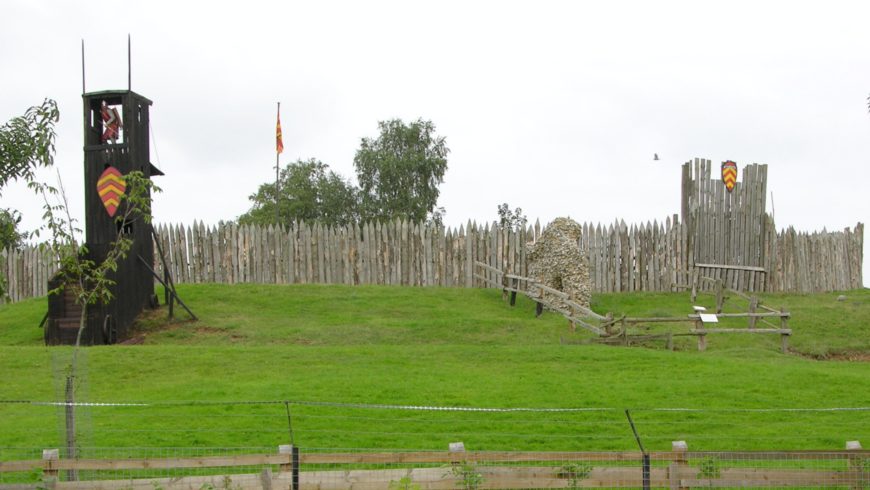
A reconstruction of a Castle has been created at Stansted Mountfitchet (in Essex), by building a fence made of chestnut wood palings around the top of a motte which dates to the time of the Normans, and calling it a “Medieval Experience.” Only a few Norman mottes ever became fully fledged stone castles (the earliest Norman castles were built of timber and earth).
Hedingham Castle
Hedingham Castle in Essex is one of the strongest and most impressive castles in Eastern England, and it was built by one of the richest and most powerful families, the de Veres, Earls of Oxford, most probably in the 1140s. It was an expensive project: there is no suitable local stone, and the high-quality limestone used to build it had to be carted eighty miles from the quarries at Barnack in Northamptonshire. Its tall keep rises to a height of almost 100 feet and dominates the flat surrounding landscape for miles in every direction. This business of height is important. The taller a building, the less stable it is. A genuinely defensive building should be low and squat. But at Hedingham visual prominence is the important factor.
A close examination of the keep shows that a lot of the height is fake.
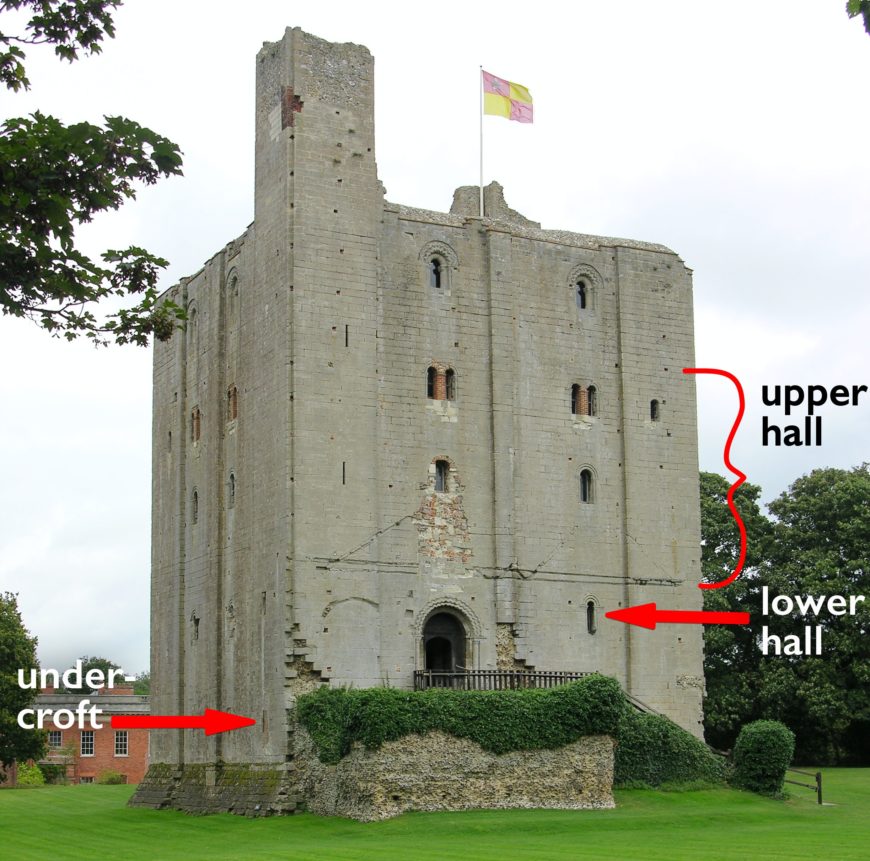
There is an undercroft (a lower hall at the level of the main doorway), and a double-height upper hall with two rows of windows, and that is all. The row of windows at the top were originally above the roof so that this whole upper storey was open to the sky. It was later roofed in and called the dormitory, but the roof is modern, and the inner walls were never plastered because they were outside.
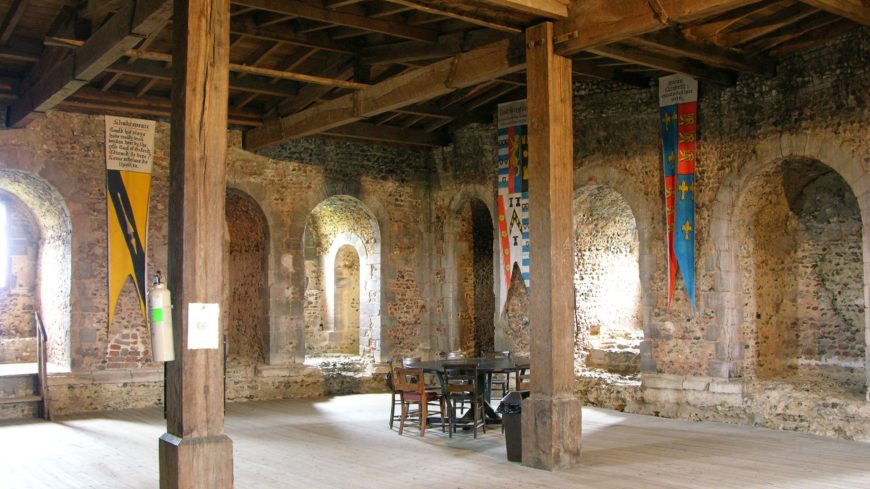
The false upper storey was not unusual in the Norman period—the White Tower, William the Conqueror’s keep at the Tower of London, was just the same.
This is not the whole story, of course. Castles were luxurious residences too. The luxury is not usually obvious because most castles are ruined nowadays, but the evidence is there to be found. At Hedingham there are richly chevron-decorated arches, fireplaces with carved capitals. and plastered walls, sometimes with traces of painted decoration still surviving.
Castles could also be genuinely defensible, but not without preparation and a special effort. During the Barons’ War against King John in the early thirteenth century Rochester Castle in Kent was held by a large garrison of about 100 of the barons’ men.
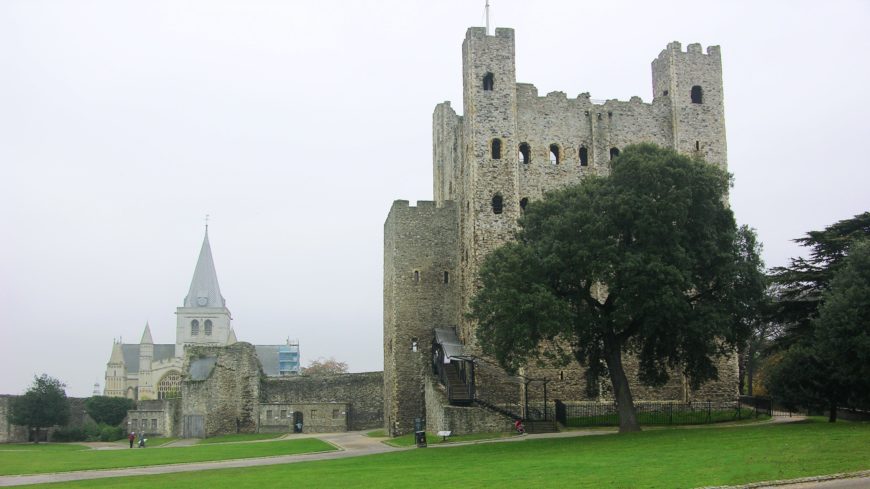
Rochester Castle was reputed to be the strongest castle in the kingdom—a coastal castle genuinely built for defense. It was besieged by the king for almost fifty days by a large force with engines, battering rams and crossbows, but held out.
Eventually the king employed miners with picks to dig underneath the foundations, propping up the tunnels with timbers, and then setting fire to them using pig-fat to feed the flames. The tunnels collapsed and the tower above them fell, but the defenders continued to hold out in the ruin until they were starved out. Later, however, the barons called on the help of Prince Louis of France, who landed in Kent and proceeded to take all the chief castles of south-east England in rapid succession: Berkhamsted, Cambridge, Colchester, Hertford, Norwich, Orford, Winchester, Hedingham and Pleshey.
This suggests that castles could resist a siege, but only under special circumstances, and those include siting—Rochester is at the mouth of the River Medway, which limits the attackers’ means of approach—and it had a large garrison as well as defensive architectural features. These features could include ditches or moats crossed by bridges with removable central sections, or gatehouses with drawbridges and portcullises, battlements with walkways and machicolations (an opening through which stones or burning objects could be dropped on attackers), and plans designed to make would-be invaders into sitting targets by ensuring that the only access route to the castle was exposed to archers on the battlements. This could be done by building the castle on a man-made or natural hill, and using a moat to slow their progress.
The traditional definition of a castle is that it is a fortified residence, and both elements—fortification and residence—are essential before something can be called a castle. The work of recent writers like Robert Liddiard, Oliver Creighton, and Matthew Johnson presents a very different and more complex idea of how castles worked. First there has been a tendency to downplay the military aspect, not least by pointing out that most castles were never under siege. The rules of medieval warfare were designed to avoid genuine sieges. A full-scale siege required enormous resources of men and horses, siege engines had to be constructed and dragged into position, and men committed for weeks or months to operating them and finding suitable ammunition. If the defenders surrendered, they should be allowed to march away unharmed, while the attackers gained only a ruined castle. In practice a siege was usually unnecessary because castles could simply be bypassed by invading forces wishing to advance.
John Goodall has suggested a new definition of a castle as “the residence of a lord made imposing through the architectural trappings of fortification, be they functional or decorative” (Goodall, 2011, p.6). This introduces the idea of fortification as an architectural style, which has much to commend it.
Goodrich Castle
Goodrich Castle in Herefordshire is strategically placed on a sandstone outcrop overlooking the river Wye, near the border between England and Wales. Goodrich reached its full medieval development in the fifteenth century. It was never under siege or serious attack until the English Civil War of the seventeenth century.
To properly understand the way castles worked it is important to try to see them as their users saw them, which can be difficult because there are always additions and losses and, most importantly, there are no longer any inhabitants.
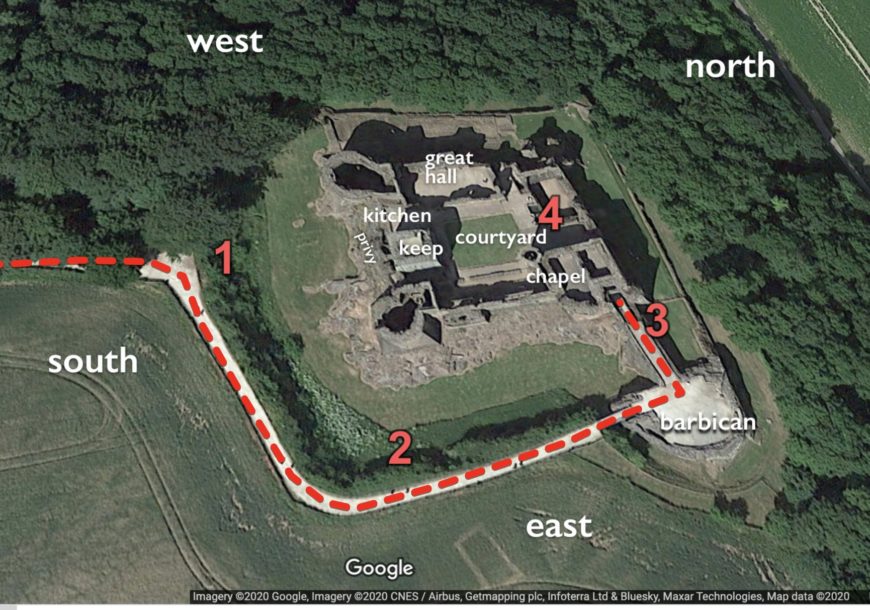
A knight visits the castle
Let’s try to put ourselves in the position of a medieval visitor of high status — a knight in the fifteenth century.
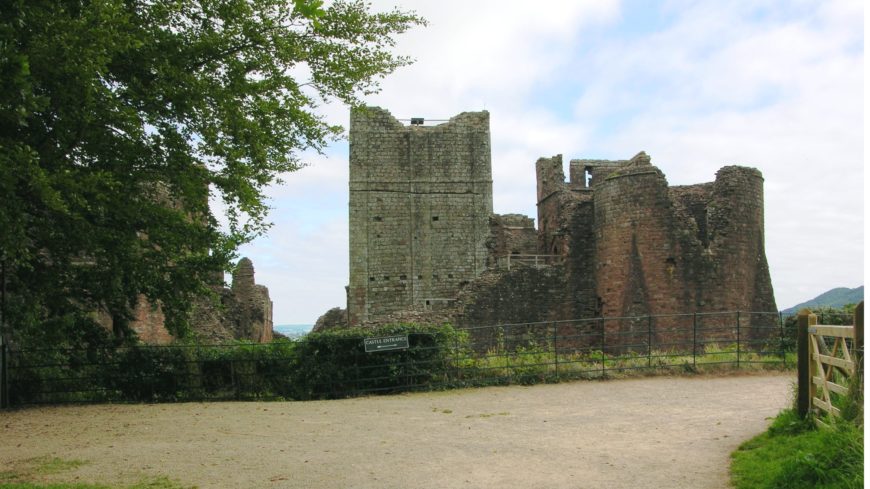
Goodrich: the approach to the castle
As usual there is just one main approach road. The lower orders might do something slightly different, but our knight simply follows the road and is led by the clues it gives. He approaches from the south with his retinue and gains his first view of the castle. In the center he sees a big square building (the keep), obviously older than the rest, which tells him that the castle is ancient—he is visiting a venerable family (in fact the Talbot Earls of Shrewsbury).
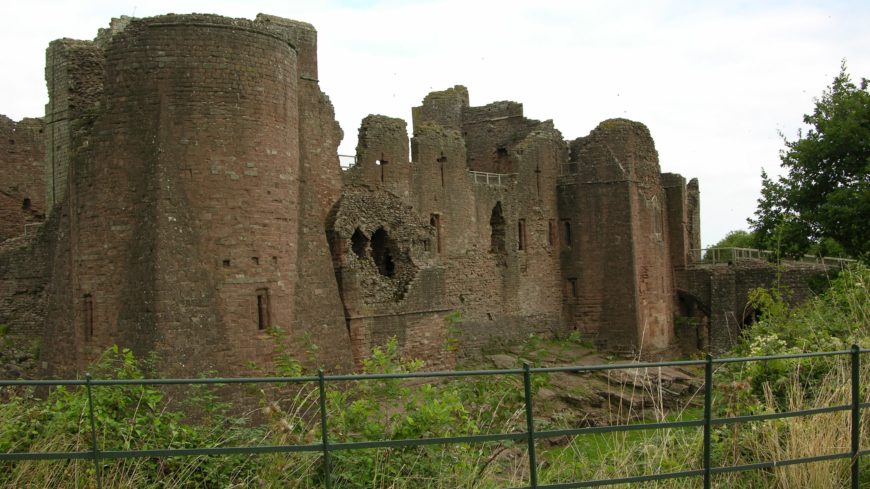
View #2: Goodrich Castle, east side (photo: Ron Baxter, CC BY-NC-SA 4.0) (Google street view)
The knight follows the road to the right, around the south-east tower, and sees the east side of the castle, originally reflected in the water of the moat, doubling its size. It has an impressive curtain wall with battlements and arrow slots. Immediately beyond the round corner tower, he sees a newly installed three-seater garderobe or privy — the last word in late-medieval plumbing. Imagine the sight and the smell as he rounds that corner and sees the human waste staining the walls as it drops into the moat. Matthew Johnson has argued that this was an important part of the castle experience, and that all that shit and food waste would have impressed the visitor with the wealth of the occupants and the lavishness of their table. Throughout the ride along the east side, our knight is separated from the castle by a deep moat, but he is observed by watchers on the battlements who will give warning of his approach. An attacking force would be most vulnerable at this stage.
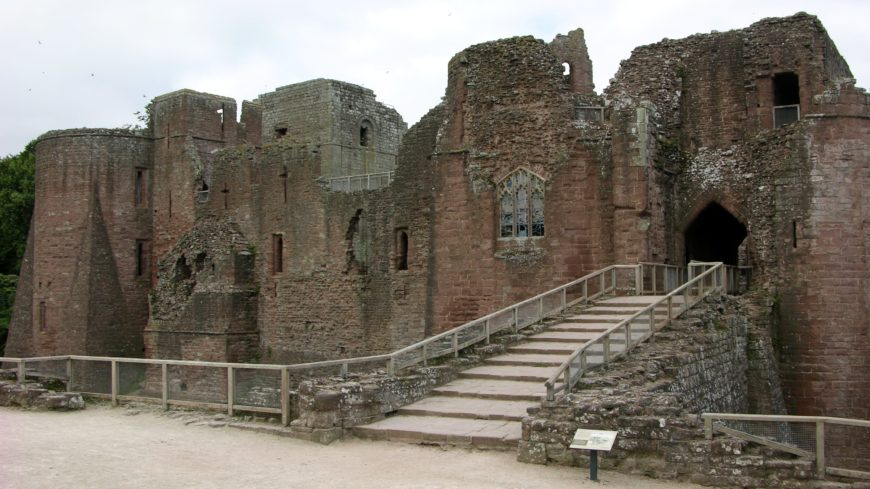
View #3: the approach to Goodrich Castle from the Barbican (photo: Ron Baxter, CC BY-NC-SA 4.0) (Google street view)
The knight rides on and reaches the barbican—a fortified outwork where he sees the gateway ahead and must dismount. No horses were allowed inside the castle. Retainers dressed in the Talbot family livery take his horse to the stables. All the servants wear the badge of the Lord so our knight can never forget whose roof he is under. To the left of the gateway he sees a chapel — recognizable by its traceried window.
He walks under the gateway and sees murder holes overhead. Perhaps he looks upwards and feels nervous as he sees the portcullis and the murder holes, through which molten lead could be poured on invaders.
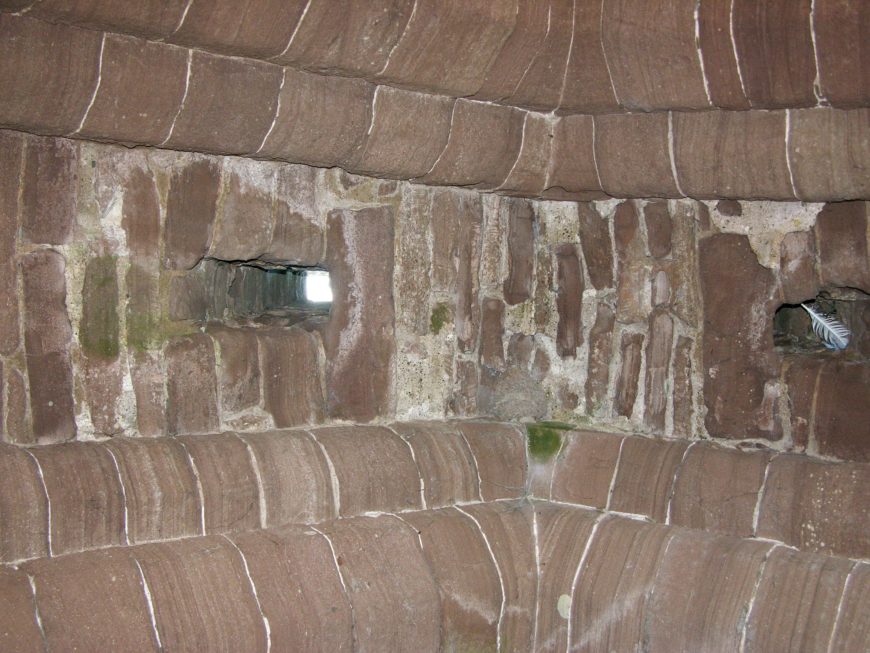
These so-called defensive features were not designed to deter a large force (which would probably bombard the walls rather than using the gatehouse), but to impress a single man or a small group.
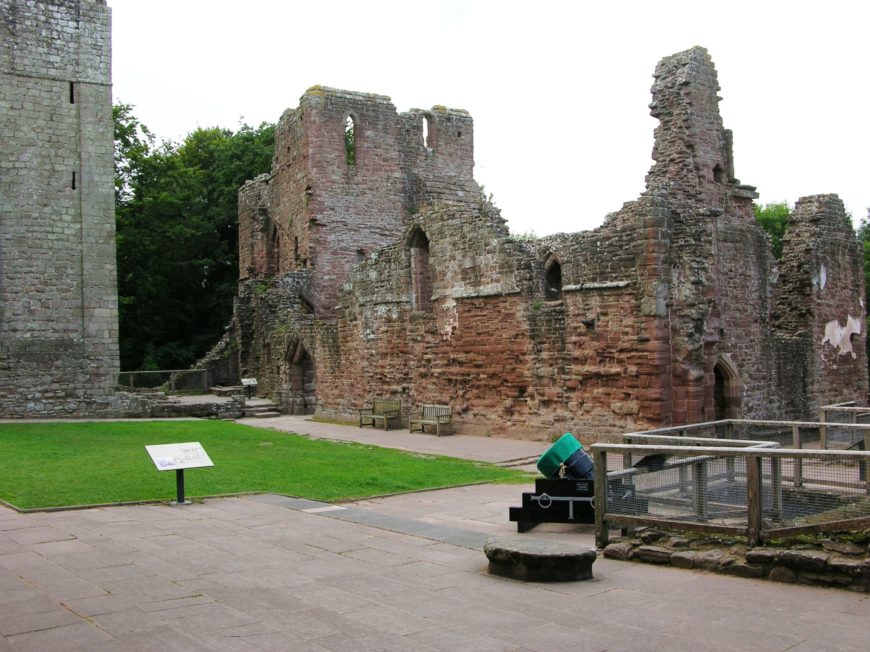
View #4: Goodrich Castle: the courtyard seen from the gatehouse (photo: Ron Baxter, CC BY-NC-SA 4.0) (Google street view)
The knight emerges into the central courtyard and immediately knows where he is — even if he has never been here before— because the elements of a castle were the same everywhere. The building on the right is the Great Hall, with the dining hall in the centre, the Lord’s lodgings at this end, the high end, and the kitchen at the far end.
As a visitor our knight will use the entrance at the low end, between the kitchen and the hall itself, but he cannot simply walk in. There is a lobby area with benches for visitors to wait until the Lord is ready to receive them.
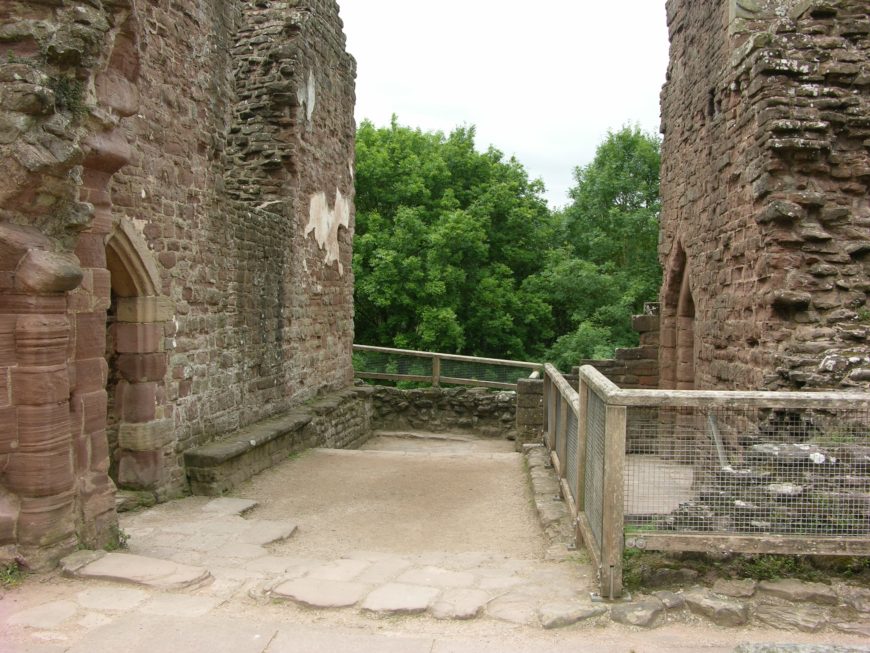
Courtly life was ritualized in this period. The retainers wore their costumes, and the Lord had his part to play like anyone else. A castle was the stage on which social relations were played out, and it was important that all the actors knew their moves and their lines. The similarities between castles were vital to the maintenance of correct social relations, which is why the component parts of a castle were designed to be easily recognizable: the tall window recesses in the Great Hall gave away its function from the exterior, as did the elaboration of the Lord’s private quarters and the traceried windows of the chapel.
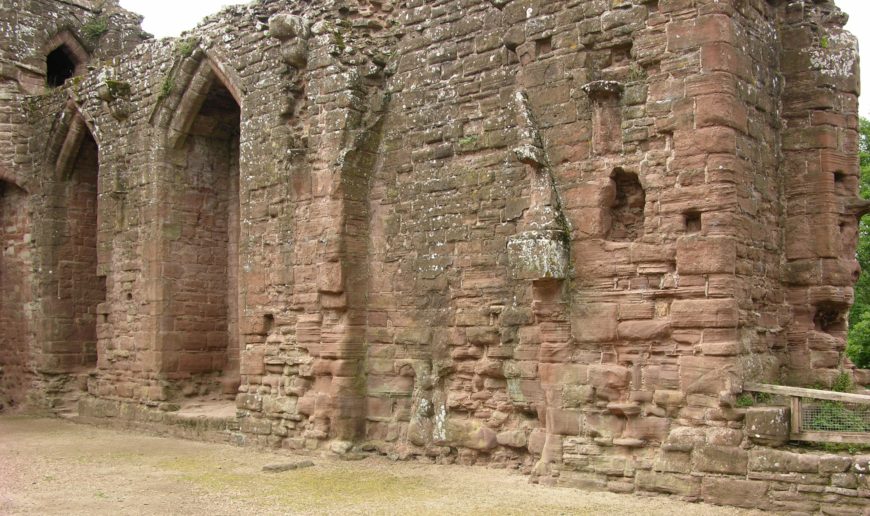
A castle visit can be a haunting experience; the crumbling walls evoking thoughts of medieval warfare and lost grandeur. But also, for historians who can read their messages, castles provide valuable evidence of the way life was lived in the Middle Ages. The problem is how to interpret what we see. Churches and cathedrals still operate today; we know what they do and how the various parts fit together as a setting for the liturgy. Even a ruined monastery is not such a puzzle that we cannot work it out. But castles like those I have looked at here function today as tourist destinations and occasionally as wedding venues. They can be settings for pleasure, ritual, and feasting, but not as they were originally conceived. Their value for the historian is that they provide the physical setting for social life in the Middle Ages, and the effort made to interpret them is generously repaid by the understanding these ruins provide.
Copyright: Dr. Ron Baxter, “The English castle: dominating the landscape,” in Smarthistory, December 5, 2020, accessed May 8, 2024, https://smarthistory.org/english-castle-dominating-landscape/.
Romanesque Architecture
The name gives it away—Romanesque architecture is based on Roman architectural elements. It is the rounded Roman arch that is the literal basis for structures built in this style.
Ancient Roman ruins (with arches)
All through the regions that were part of the ancient Roman Empire are ruins of Roman aqueducts and buildings, most of them exhibiting arches as part of the architecture (you may make the etymological leap that the two words—arch and architecture—are related, but the Oxford English Dictionary shows arch as coming from Latin arcus, which defines the shape, while arch—as in architect, archbishop, and archenemy—comes from Greek arkhos, meaning chief and ekton means builder).
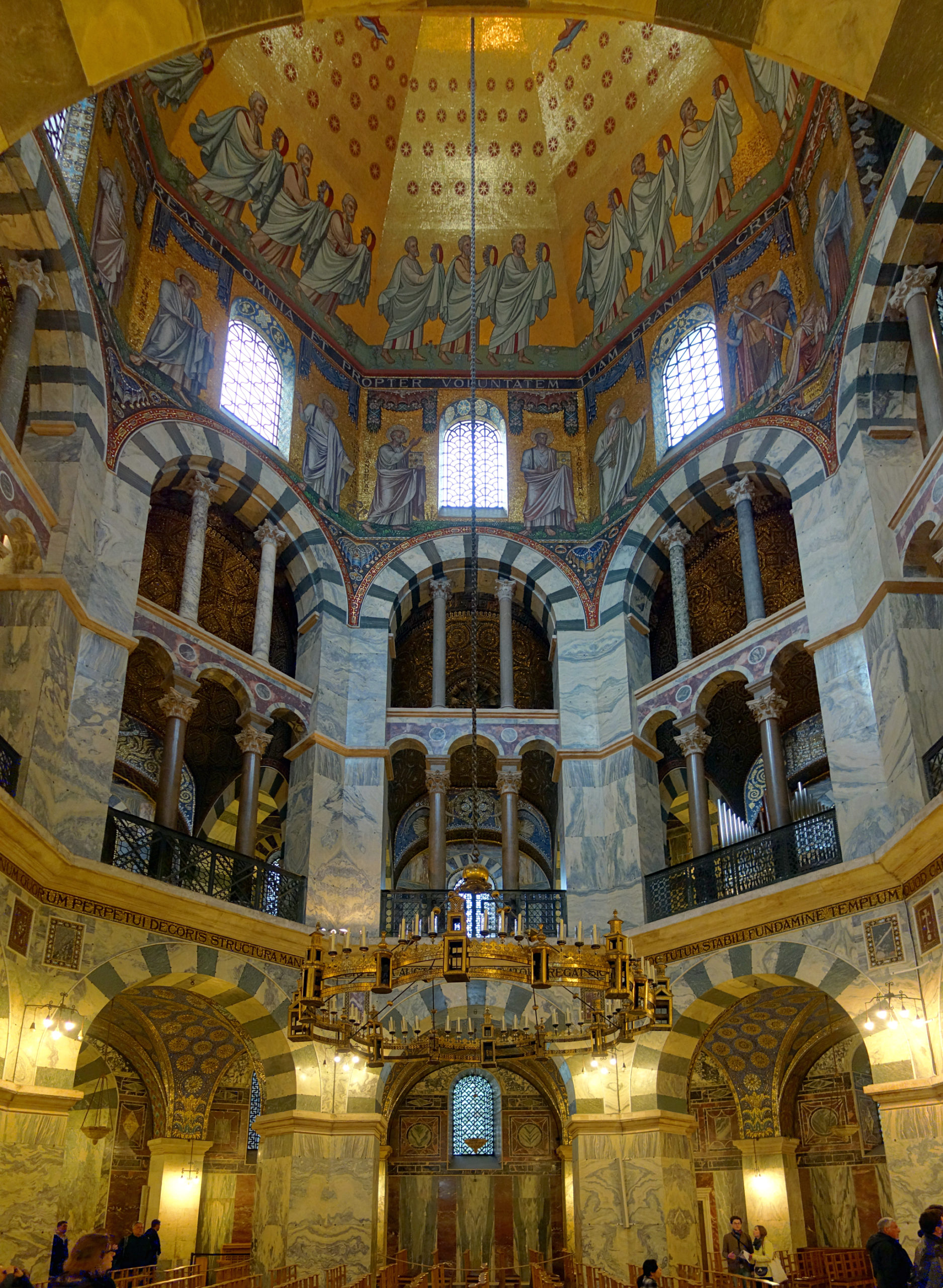
When Charlemagne was crowned Holy Roman Emperor in 800 C.E., the remains of Roman civilization were seen all over the continent, and legends of the great empire would have been passed down through generations after the fall of Rome in the fifth century. So when Charlemagne wanted to unite his empire and validate his reign, he began building churches in the Roman style—particularly the style of Christian Rome in the days of Constantine, the first Christian Roman emperor.
After a gap of around two hundred years with no large building projects, the architects of Charlemagne’s day looked to the arched, or arcaded, system seen in Christian Roman edifices as a model. It is a logical system of stresses and buttressing, which was fairly easily engineered for large structures, and it began to be used in gatehouses, chapels, and churches in Europe.
These early examples may be referred to as pre-Romanesque because, after a brief spurt of growth, the development of architecture again lapsed. As a body of knowledge was eventually re-developed, buildings became larger and more imposing. Examples of Romanesque cathedrals from the early Middle Ages (roughly 1000–1200) are solid, massive, impressive churches that are often still the largest structure in many towns.
In Britain, the Romanesque style became known as “Norman” because the major building scheme in the 11th and 12th centuries was instigated by William the Conqueror, who invaded Britain in 1066 from Normandy in northern France. (The Normans were the descendants of Norse, or north men (“Vikings”) who had invaded this area over a century earlier.) Durham and Gloucester Cathedrals and Southwell Minster are excellent examples of churches in the Norman, or Romanesque style.
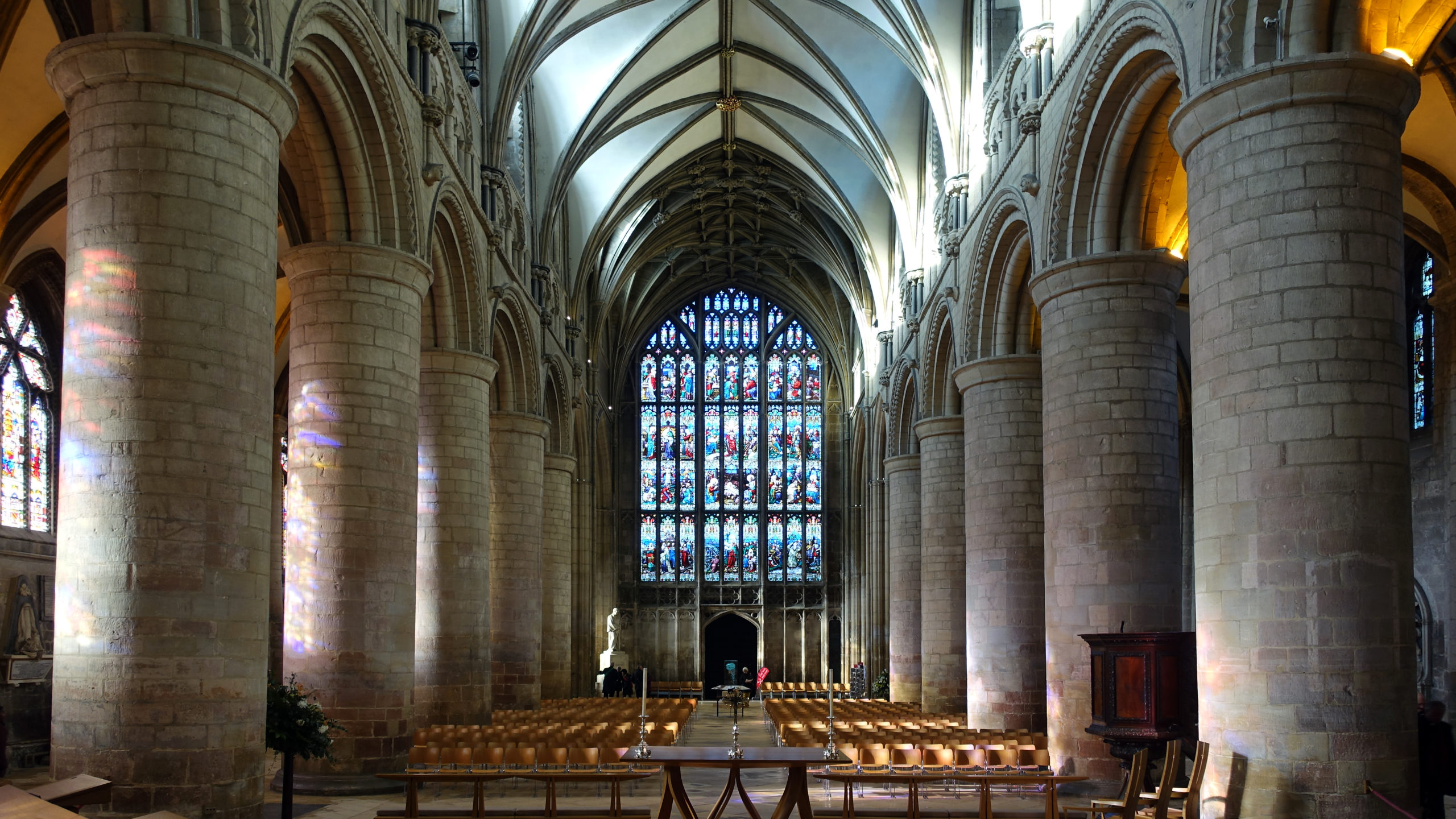
The arches that define the naves of these churches are well modulated and geometrically logical—with one look you can see the repeating shapes, and proportions that make sense for an immense and weighty structure. There is a large arcade on the ground level made up of bulky piers or columns. The piers may have been filled with rubble rather than being solid, carved stone. Above this arcade is a second level of smaller arches, often in pairs with a column between the two. The next higher level was again proportionately smaller, creating a rational diminution of structural elements as the mass of the building is reduced.
The decoration is often quite simple, using geometric shapes rather than floral or curvilinear patterns. Common shapes used include diapers—squares or lozenges—and chevrons, which were zigzag patterns and shapes. Plain circles were also used, which echoed the half-circle shape of the ubiquitous arches.
Early Romanesque ceilings and roofs were often made of wood, as if the architects had not quite understood how to span the two sides of the building using stone, which created outward thrust and stresses on the side walls. This development, of course, didn’t take long to manifest, and led from barrel vaulting (simple, semicircular roof vaults) to cross vaulting, which became ever more adventurous and ornate in the Gothic.

Copyright: Valerie Spanswick, “A beginner’s guide to Romanesque architecture,” in Smarthistory, August 8, 2015, accessed May 2, 2024, https://smarthistory.org/a-beginners-guide-to-romanesque-architecture/.
Gothic Architecture
Video URL: https://youtu.be/G94jFWH8NSM?si=LE5q3UFiS4CDAWYB
Copyright; Dr. Beth Harris and Dr. Steven Zucker, “Gothic architecture explained,” in Smarthistory, January 25, 2023, accessed May 2, 2024, https://smarthistory.org/gothic-architecture-explained/.
Video URL: https://youtu.be/Jk3VsinLgvc?si=uVTp1zbl1mod7R8H
Copyright: Dr. Beth Harris and Dr. Steven Zucker, “Cathedral of Notre Dame de Chartres,” in Smarthistory, December 18, 2015, accessed May 8, 2024, https://smarthistory.org/cathedral-of-notre-dame-de-chartres-part-1-of-3/.
Video URL: https://youtu.be/2EciWH-1ya4?si=5cNUZ1o9hHWwJLLu
Copyright: Dr. Beth Harris and Dr. Steven Zucker, “Birth of the Gothic: Abbot Suger and the ambulatory at St. Denis,” in Smarthistory, December 5, 2015, accessed May 2, 2024, https://smarthistory.org/birth-of-the-gothic-abbot-suger-and-the-ambulatory-at-st-denis/.
Video URL: https://youtu.be/PATkTJhAUhM?si=JB0s1JK-jGHGPd4J
Copyright: Dr. Steven Zucker and Dr. Beth Harris, “Last Judgment, Tympanum, Cathedral of St. Lazare, Autun (France),” in Smarthistory, December 5, 2015, accessed May 8, 2024, https://smarthistory.org/last-judgment-tympanum-cathedral-of-st-lazare-autun-france/.
English medieval architecture
Four styles of English medieval architecture
Ely Cathedral, like nearly all medieval English cathedrals, saw many different phases of construction. Major building projects in the Middle Ages were both expensive and time-consuming, so renovations and additions were made piecemeal rather than all at once. The long period of time means that by looking at Ely, we can get a sense of each of the most important medieval English architectural styles, all in one building: Romanesque (in the nave), Early English (in the presbytery), Decorated (in the tower and Lady Chapel), and Perpendicular (in the eastern chantry chapels). See the plan below.
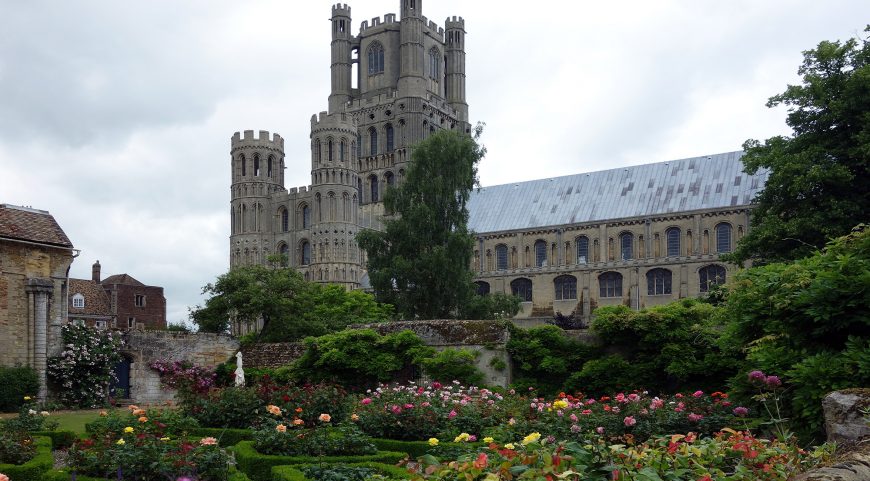
Ely Cathedral, sometimes referred to as “the ship of the Fens,” is a massive building rising up from the flat, marshy fenland of East Anglia. It is visible from many miles away like a lone ship on a calm sea. Ely’s history began in the seventh century, when an Anglo-Saxon princess named Æthelthryth, or Etheldreda, made a holy vow of virginity. When she was married for political reasons, she fled her husband and founded a nunnery on the Isle of Ely. In Etheldreda’s time, Ely was an island surrounded by marshes (drained later, in the seventeenth century), and the place takes its name from the eels that dwelled in these swampy waters.
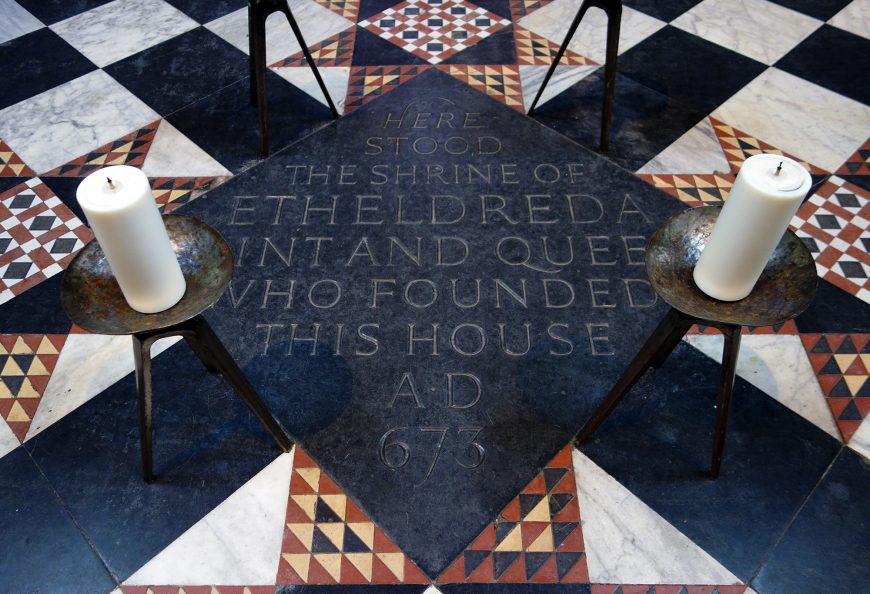
Etheldreda died just seven years after founding her nunnery. When her body was translated (ceremonially moved), from its original location fourteen years later, it was found to be incorrupt and it was put into a “new” sarcophagus—actually a reused one from an old Roman settlement nearby. A cult developed around Etheldreda, who became a saint (the common name for Etheldreda is St. Audrey).
Etheldreda’s nunnery was raided by Danish invaders in 870. Whether the relics of Etheldreda survived the raid is an open question, but the author of the twelfth-century text, the Liber Eliensis (Book of Ely), detailed stories of the continued power of Etheldreda’s relics, possibly intended to suggest that they had not been destroyed. Relics were very important objects in the Middle Ages, lending prestige to the churches where they were held, and drawing pilgrims, who would come seeking miracles. The existence of Etheldreda’s relics was therefore very important for the identity of the church at Ely, where in 970, with royal patronage, the church was refounded as a Benedictine monastery.
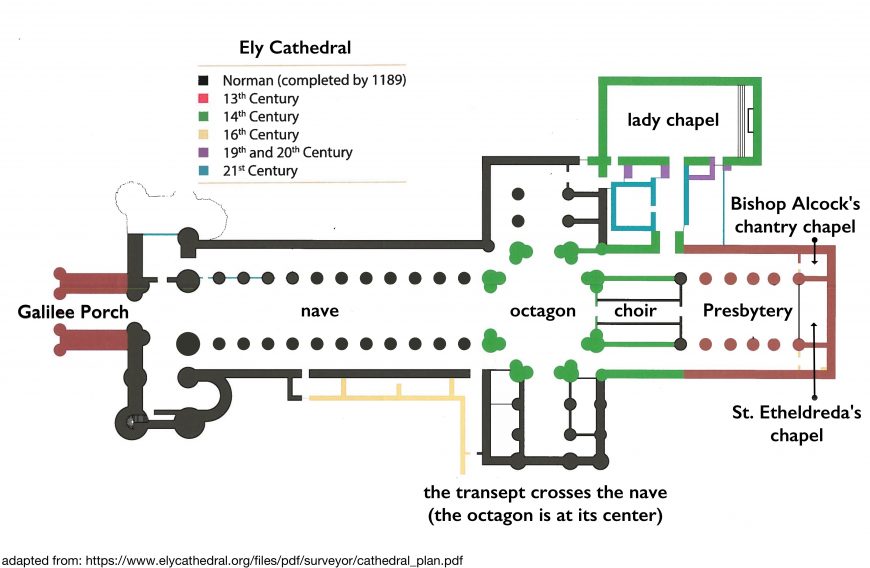
The Romanesque (Norman) building
Though it had been the site of Christian worship for hundreds of years prior to 1082, little is known about the architecture of Ely before this date, when the first Norman abbot of Ely initiated the construction of a new church for the monastery. The foundations were laid out by a man in his 80s named Abbot Simeon who had previously been prior of the important monastic community of Winchester (in the south of England), where his brother, Walchelin, was bishop. Simeon and his brother had orchestrated a building campaign in Winchester that was still underway when Simeon came to Ely, and that in-progress church served as inspiration for much of the Ely building program.
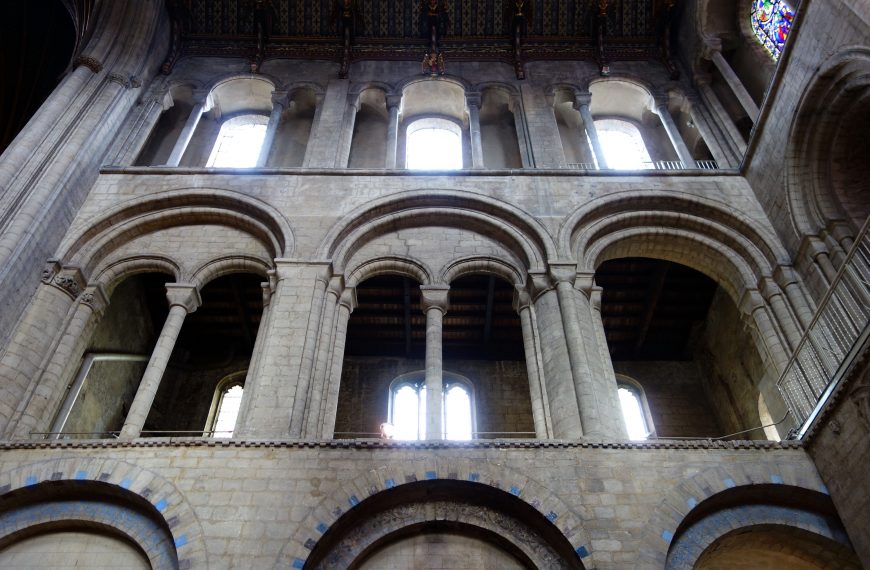
Simeon’s building plans at Ely began in the east end with the choir and transepts. This is typical for churches, since their primary liturgical functions commonly take place in the east end of the church, oriented towards Jerusalem. This part of the church exemplifies the Romanesque style brought from Normandy after the Norman Conquest in 1066. It was completed in two different phases, which we can tell from the new decorative forms that appear on some of the capitals of the columns of the transepts, which were built later than the others.
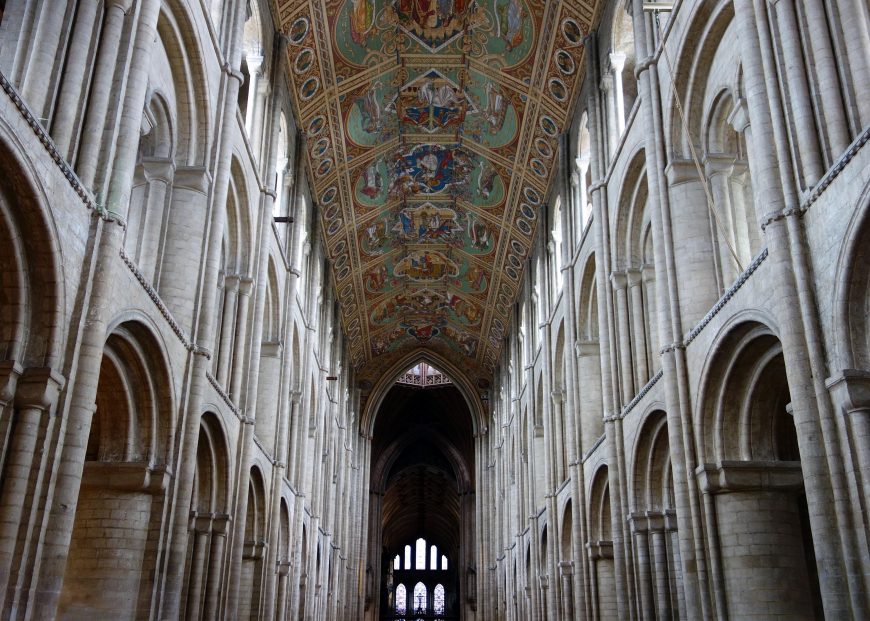
Work on the nave was begun subsequently, and the south side was completed around 1109, when Ely was officially elevated to the status of a cathedral. Ely’s nave and transepts were some of the first spaces in England to display alternating forms of compound piers. This alternation adds visual rhythm, and diffuses the heaviness of these massive stone forms.
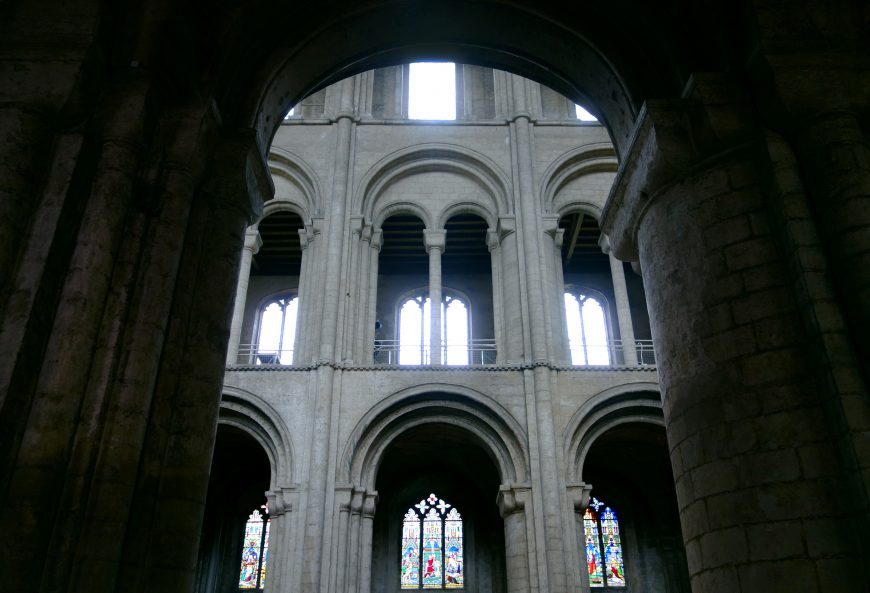
Like most Romanesque and Gothic cathedrals, Ely’s nave elevation has three stories. The nave arcade with its alternating piers is on the ground floor. Above this is a gallery with double-light openings, or double, windowless arches, each pair set within a larger arch that mirrors the corresponding arch on the lower level. The third level is a clerestory with triplet openings. The tremendous thickness of the walls (a distinguishing feature of the Romanesque) is balanced by the proliferation of openings as one’s eyes travel upward. The viewer gets the sense that the building becomes lighter and brighter as it soars heavenward.
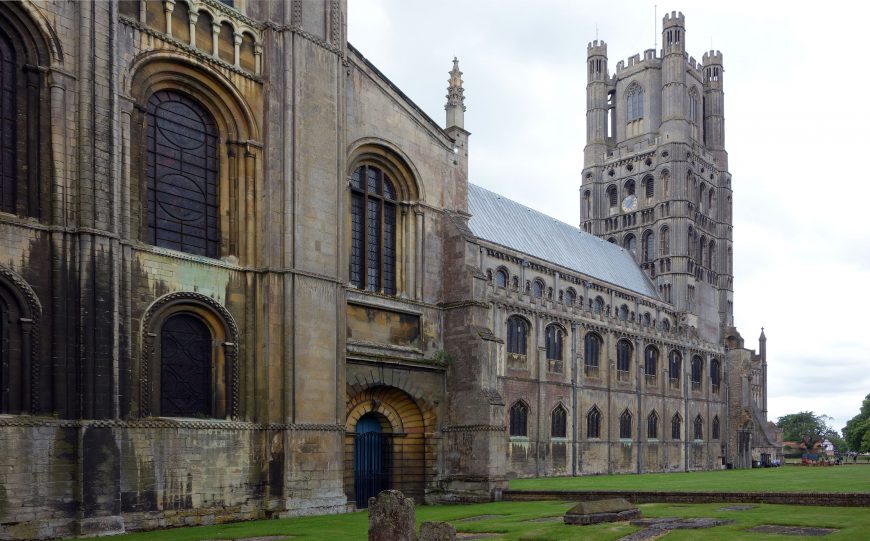
Late Romanesque and Early English Gothic
The west tower that tops the cathedral’s main entrance was built at the end of the twelfth century, towards the end of the Romanesque period in England.
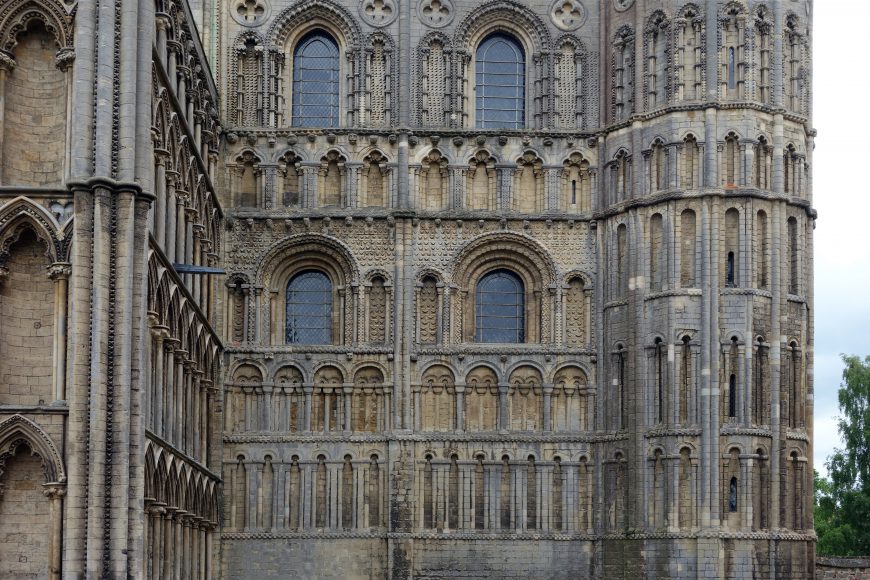
Experiments in the Gothic style brought over from France had already begun to take hold in England—particularly at Canterbury Cathedral and the northern Cistercian monasteries. At Ely, though, the tower still exhibits round Romanesque arches instead of the pointed arches that are a hallmark of Gothic architecture.
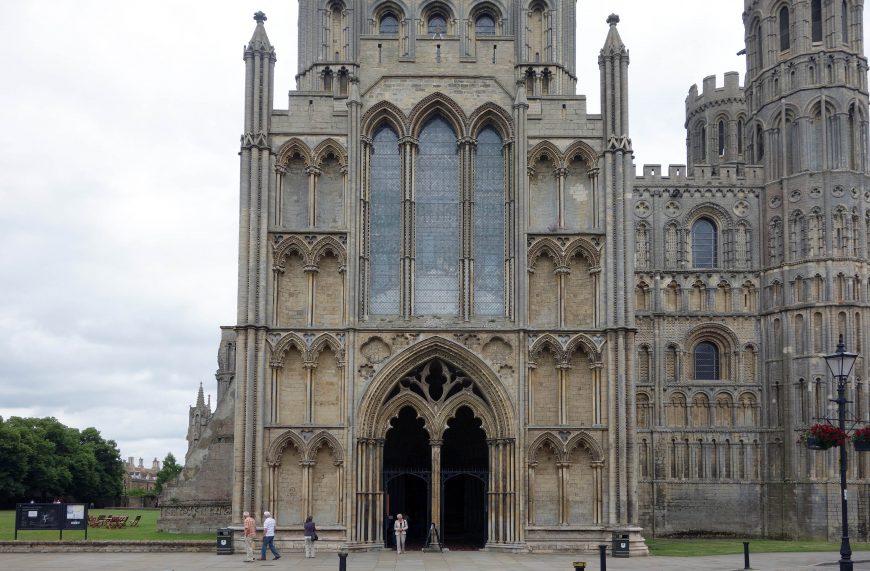
The exterior is covered almost completely in blind arcading, an English speciality that stands in stark contrast to French medieval architecture, which prefers little extra surface decoration. Below the tower, we see a monumental entrance with blind pointed arches, which was added a bit later in the Early English Gothic style, showing how this new style was rapidly spreading across England during this time.
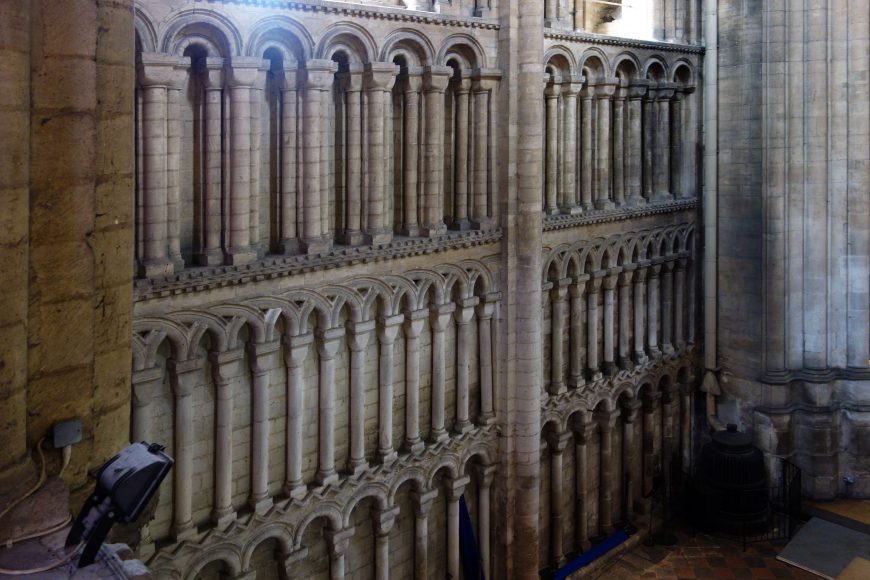
At the other end of the building, the presbytery was extended eastward in the 1230s and 1240s. In style, it draws from the nave of Lincoln Cathedral, completed just a decade or so earlier. With engaged colonnettes of Purbeck marble and white limestone, as well as complex rib vaults, it reflected the most fashionable architecture of the time. Then, as now, architectural styles came and went quickly, and the wealthiest and most powerful—such as the Bishop and diplomat Hugh of Northwold, who financed the new presbytery—had the means to stay current.
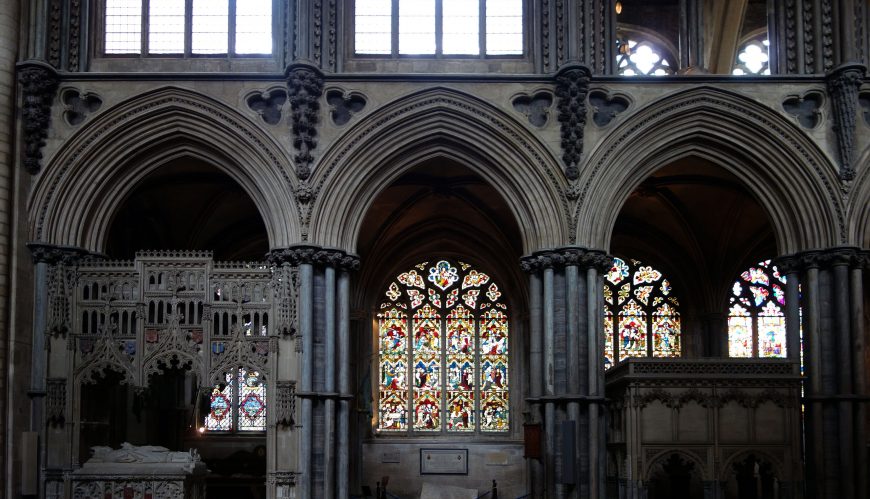
Eastern extensions were popular at this time to provide more room for the shrines of saints, like Thomas Becket at Canterbury Cathedral, or, at Ely, the shrine of Etheldreda. The presbytery was large enough to accommodate the many pilgrims who came to Ely to venerate the saint (and brought important income to the church and surrounding area). Having a highly-decorated space made this holy destination even more desirable.
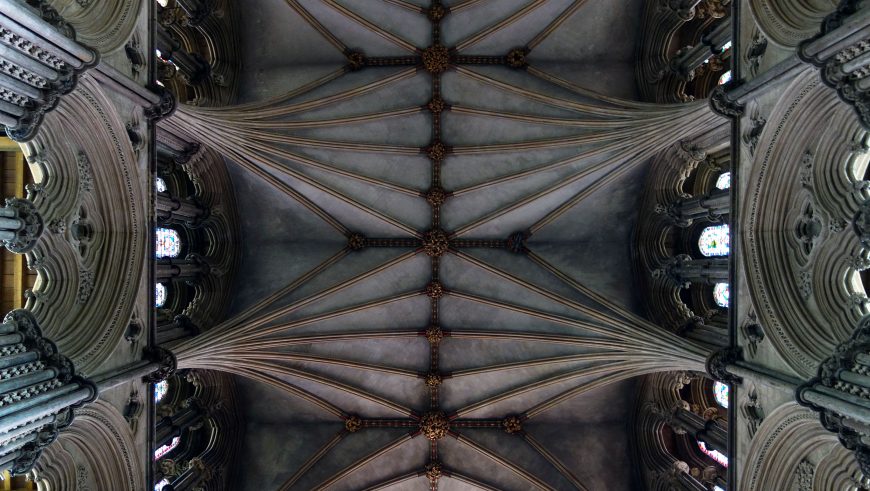
Ely Cathedral in the Decorated Style
In 1321, a new chapel was begun north of the presbytery, which would eventually become one of the most beautiful and artistically innovative of the English Gothic period. But in the early morning hours of February 13, 1322, just as the monks were finishing their morning prayers, disaster struck. The crossing tower of the cathedral collapsed, crushing parts of the choir, and construction on the chapel had to stop.
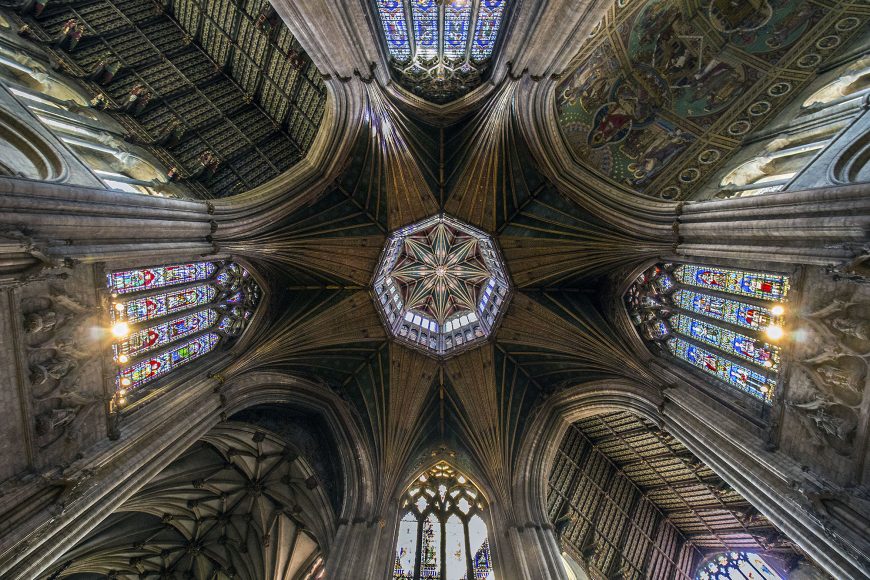
Though this collapse was devastating, it made room for one of the most remarkable structures of the English Middle Ages. Alan of Walsingham, sub-prior and sacrist of Ely, quickly initiated the building of a new tower—a tall, octagonal structure (often referred to as “the Octagon”) surmounted by a tower made of timber clad with lead. This type of tower is called a lantern because it is pierced to allow light in. Vaults with tiercerons spring from the base of the Octagon, creating a star-like effect when one looks up.
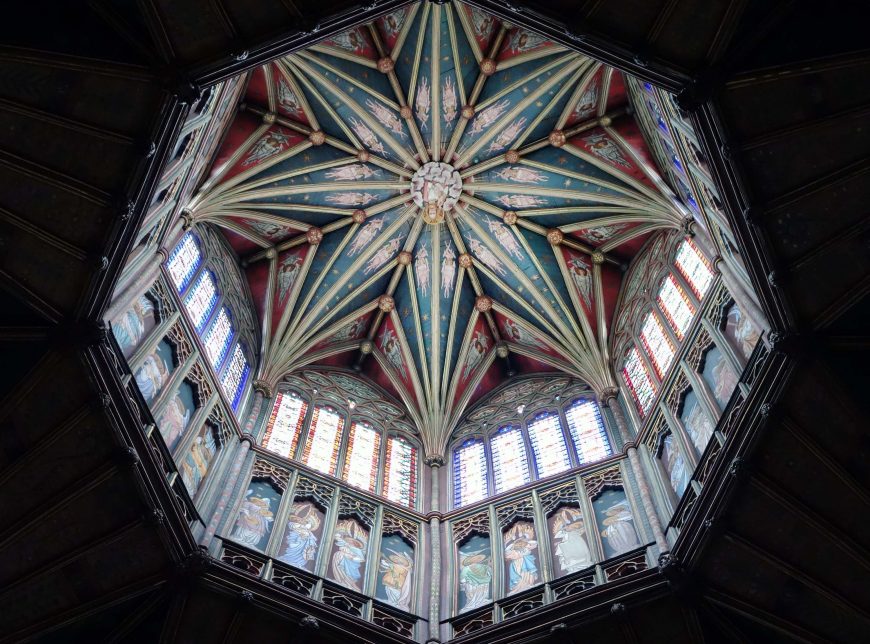
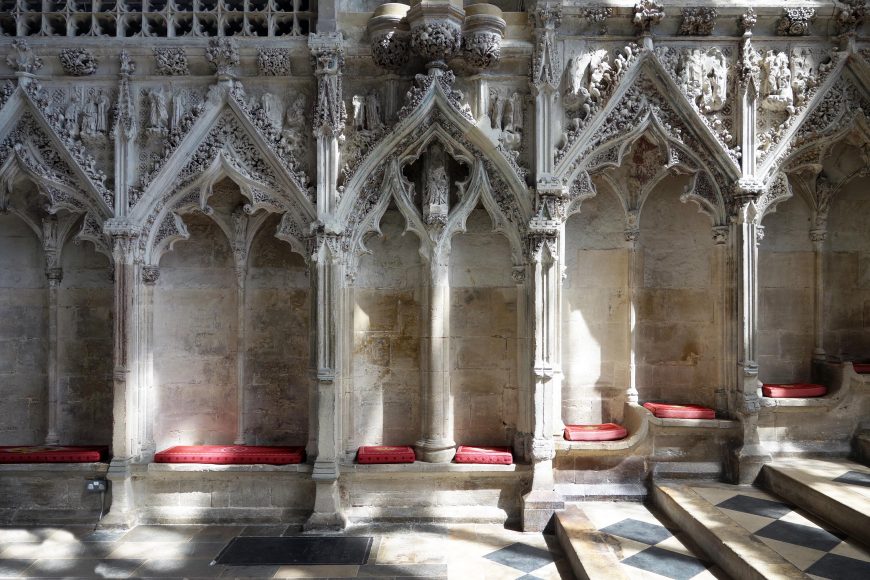
Each niche is protected with a nodding ogee canopy and ornamented with relief sculpture relating to the Virgin. It has been observed that the sculptural niches of the dado have a vulvular shape, perhaps not coincidental given that the chapel celebrates the Virgin Mary, whose chief contribution to Christian history was giving birth to Jesus.
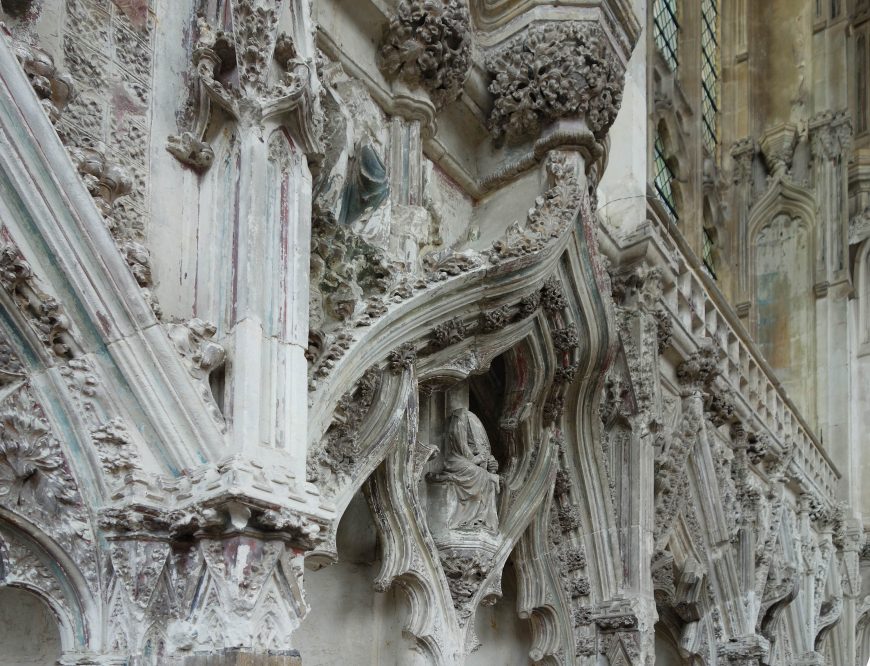
The Lady Chapel was interrupted by the collapse of the central tower, and its progress may have been troubled again by the Black Death, which struck England in 1348. On the western side of the chapel, the nodding ogees of the dado flatten, and the diaper-work is halted. The vault fits uneasily on the chapel. Scholars suspect that some of the sculptors and masons at Ely may have fallen victim to the plague, leaving the lavish project to be completed by their less adept colleagues.
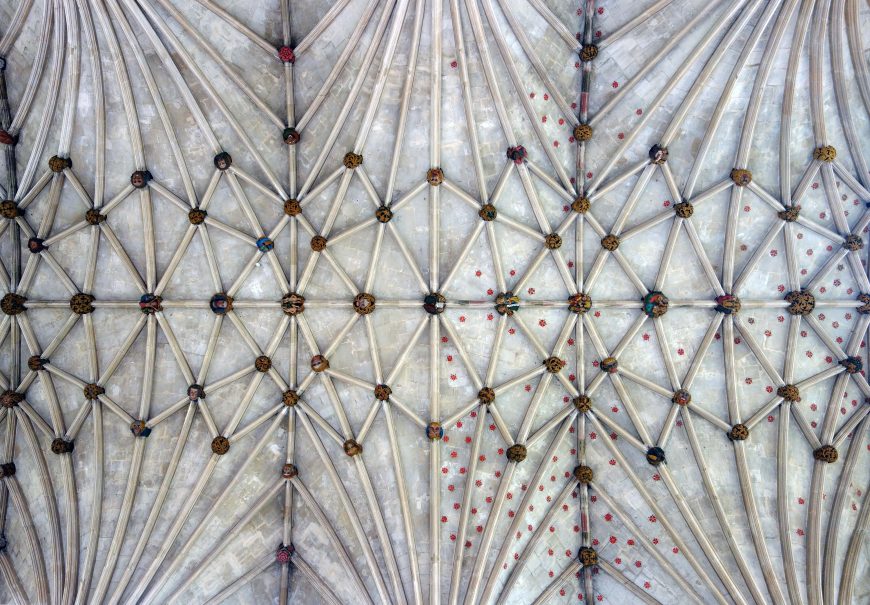
Iconoclasm in the Ely Lady Chapel
Although the Ely Lady Chapel is one of the most beautiful interiors of English medieval art, it’s also one of the most heavily destroyed. During the English Reformation, the sculptures were mutilated because religious imagery was thought to be idolatrous. The images were taken from their niches, and the colorful stained glass that would have filled the windows was destroyed. Some sculpture remains in the life of the Virgin series on the dado, but many have been stripped of their heads or more. Traces of polychromy remain, but are but a pale shadow of the formerly brilliant space.
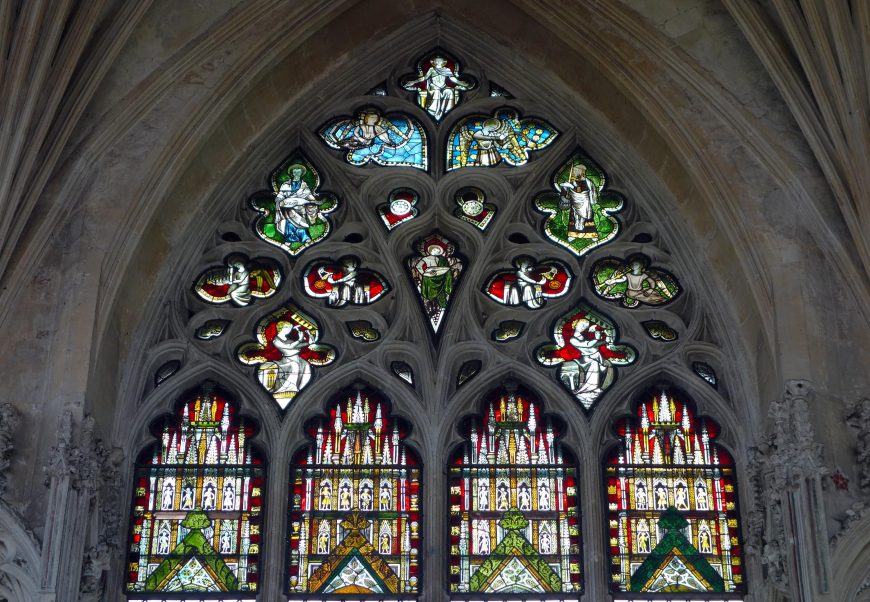
The end of the Middle Ages
After the Black Death, a final style of the English Middle Ages emerges as the primary mode of building. This is called the Perpendicular Style because, unlike the flowing, undulating curves of the Decorated Style that preceded it, it emphasizes straight lines and vertical projections. The Perpendicular Style took hold in the second half of the fourteenth century, and continued through the remainder of the Middle Ages—almost two hundred years!
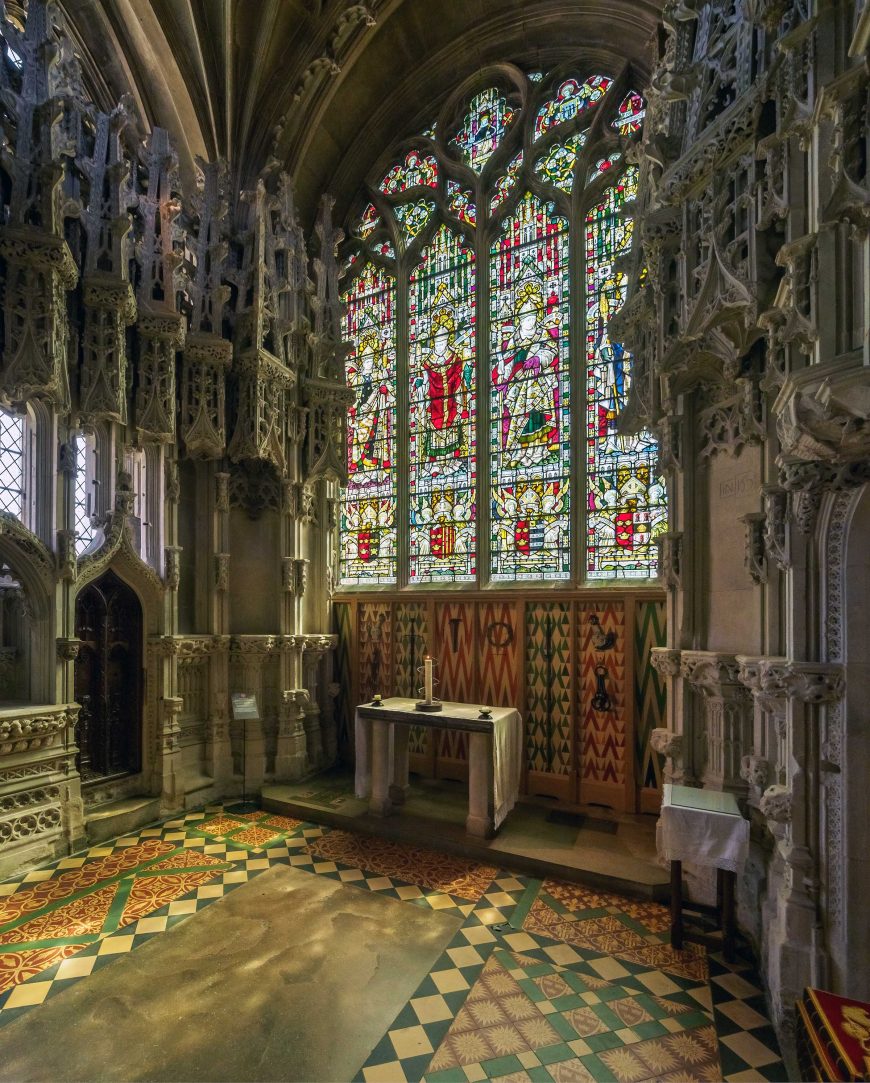
Bishop Alcock’s chantry chapel was built in the Perpendicular Style between 1488 and 1500. A chantry chapel is a space devoted to praying for an individual or a family in order to shorten their time in purgatory. Purgatory was understood to be a fiery place where souls went after death, but unlike hell, one could eventually leave purgatory after serving the required amount of time necessary for sins committed during life. A reduction of one’s sentence in purgatory could be achieved, either during life from the acquisition of indulgences, or in death if one’s loved ones or the executors of their wills prayed for them and ensured that masses were said in their honor.
Alcock is likely to have planned the chapel himself—he had been the Controller of the Royal Works and Buildings under King Henry VII. The chapel is cordoned off from the north aisle with a microarchitectural screen with statue niches that are now empty. Though this screen is extremely intricate and beautifully carved, it doesn’t quite fit in the space allotted for it. Prior to becoming bishop of Ely, Alcock had held the same post at Worcester Cathedral. It is thought that the chapel may have been planned for a large space there, but was instead jammed into tighter accommodations at Ely. Within the chapel is Alcock’s tomb, in a niche, and an altar so that Masses could be said for his soul. Alcock’s memory was also made explicit with the use of his rebus with a cock (rooster) atop a globe, and his coat of arms, three cocks.
A ship of four styles
The “ship of the Fens” is a wonderful example of the evolution of English architectural style in the Middle Ages: from Romanesque to Early English Gothic, Decorated, and Perpendicular. The people who built churches in the Middle Ages wouldn’t have thought of themselves as building in these styles, however—these are names given by historians in the nineteenth century to describe them retrospectively. The builders themselves would have thought of what they were building simply as “current.” Although Etheldreda sought refuge her marriage in the quiet, eel-filled marshes of Ely, the Middle Ages saw this site develop into a far more elaborate space than she could possibly have imagined.
Copyright: Meg Bernstein, “Four styles of English medieval architecture at Ely Cathedral,” in Smarthistory, October 26, 2018, accessed May 2, 2024, https://smarthistory.org/ely-cathedral/.
Viking Architecture
Video URL: https://youtu.be/87YxCJoJqfw?si=uTZaayRgpiGarBeU
Copyright: UNESCO, “Urnes Stave Church,” in Smarthistory, May 27, 2021, accessed May 8, 2024, https://smarthistory.org/urnes-stave-church/.
PERFORMING ARTS
Music for Medieval Christian Worship
The earliest music of Catholic Christianity was chant, that is, monophonic a cappella music, most often sung in worship. As you learned in the first chapter of this book, monophony refers to music with one melodic line that may be performed by one or many individuals at the same time. Largely due to the belief of some Catholics that instruments were too closely associated with secular music, instruments were rarely used in medieval worship; therefore most chant was sung a cappella, or without instruments. As musical notation for rhythm had not yet developed, the exact development of rhythm in chant is uncertain. However, based on church tradition (some of which still exist), we believe that the rhythms of medieval chants were guided by the natural rhythms provided by the words.
Medieval Catholic worship included services throughout the day. The most important of these services was the Mass, at which the Eucharist, also known as communion, was celebrated (this celebration includes the consumption of bread and wine representing the flesh and blood of Jesus Christ). Five chants of the mass (the Kyrie, Gloria, Credo, Sanctus, and Agnus Dei) were typically included in every mass, no matter what date in the church calendar. Catholics, as well as some Protestants, still use this Liturgy in worship today.
In the evening, one might attend a Vespers service, at which chants called hymns were sung. Hymns, like most of the rest of the Catholic liturgy, were sung in Latin. Hymns most often featured four-line strophes in which the lines were generally the same length and often rhymed. Each strophe of a given hymn was sung to the same music, and for that reason, we say that hymns are in strophic form. Hymns like most chants generally had a range of about an octave, which made them easy to sing.
Throughout the Middle Ages, Mary the mother of Jesus, referred to as the Virgin Mary, was a central figure in Catholic devotion and worship. Under Catholic belief, she is upheld as the perfect woman, having been chosen by God to miraculously give birth to the Christ while still a virgin. She was given the role of intercessor, a mediator for the Christian believer with a petition for God, and as such appeared in many medieval chants.
Many composers of the Middle Ages will forever remain anonymous. Hildegard of Bingen (1098-1179) from the German Rhineland is a notable exception. At the age of fourteen, Hildegard’s family gave her to the Catholic Church where she studied Latin and theology at the local monastery. Known for her religious visions, Hildegard eventually became an influential religious leader, artist, poet, scientist, and musician. She would go on to found three convents and become an abbess, the chief administrator of an abbey.
Writing poetry and music for her fellow nuns to use in worship was one of many of Hildegard’s activities, and the hymn “Ave Generosa” is just one of her many compositions. This hymn has multiple strophes in Latin that praise Mary and her role as the bearer of the Son of God. The manuscript contains one melodic line that is sung for each of the strophes, making it a strophic monophonic chant. Although some leaps occur, the melody is conjunct. The range of the melody line, although still approachable for the amateur singer, is a bit wider than other church chant of the Middle Ages. The melody also contains melismas at several places. A melisma is the singing of multiple pitches on one syllable of text. Overall, the rhythm of the chant follows the rhythm of the syllables of the text.
Chant is by definition monophonic, but scholars suspect that medieval performers sometimes added musical lines to the texture, probably starting with drones (a pitch or group of pitches that were sustained while most of the ensemble sang together the melodic line). Performances of chant music today often add embellishments such as occasionally having a fiddle or small organ play the drone instead of being vocally incorporated. Performers of the Middle Ages possibly did likewise, even if prevailing practices called for entirely a cappella worship.
The Emergence of Polyphonic Music for the Medieval Church
Initial embellishments such as the addition of a musical drone to a monophonic chant were probably improvised during the Middle Ages. With the advent of musical notation that could indicate polyphony, composers began writing polyphonic compositions for worship, initially intended for select parts of the liturgy to be sung by the most trained and accomplished of the priests or monks leading the Mass. Originally, these polyphonic compositions featured two musical lines at the same time; eventually, third and fourth lines were added. Polyphonic liturgical music, originally called organum, emerged in Paris around the late twelfth and thirteenth centuries. In this case, growing musical complexity seems to parallel growing architectural complexity.
Composers wrote polyphony so that the cadences, or ends of musical phrases and sections, resolved to simultaneously sounding perfect intervals. Perfect intervals are the intervals of fourths, fifths, and octaves. Such intervals are called perfect because they are the first intervals derived from the overtone series. As hollow and even disturbing as perfect intervals can sound to our modern ears, the Middle Ages used them in church partly because they believed that what was perfect was more appropriate for the worship of God than the imperfect.
In Paris, composers also developed an early type of rhythmic notation, which was important considering that individual singers would now be singing different musical lines that needed to stay in sync. By the end of the fourteenth century, this rhythmic notation began looking a little bit like the rhythmic notation recognizable today. Beginning a music composition, a symbol fell indicating something like our modern meter symbols. This symbol told the performer whether the composition was in two or in three and laid out the note value that provided the basic beat. Initially almost all metered church music used triple time, because the number three was associated with perfection and theological concepts such as the trinity.

Elsewhere in what is now France, Guillaume de Machaut (ca. 1300–1377) emerged as the most important poet and composer of his century and is credited with composing the earliest polyphonic setting of the Mass. He is the first composer about which we have much biographical information, due in part to the fact that Machaut himself, near the end of his life, collected his poetry into volumes of manuscripts, which include a miniature image of the composer. We know that he traveled widely as a cleric and secretary for John, the King of Bohemia. Around 1340, he moved to Reims (now in France), where he served as a church official at the cathedral. There he had more time to write poetry and music, which he seems to have continued doing for some time.
Focus Composition: Agnus Dei from the Nostre Dame Mass (ca. 1364 CE)
We think that Machaut wrote his Messe de Nostre Dame (Mass of Our Lady) around 1364. This composition is famous because it was one of the first compositions to set all five movements of the Mass ordinary as a complete whole: these movements are the pieces of the Catholic liturgy comprising every Mass, no matter what time of the year. Movement in music refers to a musical section that sounds complete but that is part of a larger musical composition. Musical connections between each movement of this Mass cycle—the Kyrie, Gloria, Credo, Sanctus, and Agnus Dei—suggest that Machaut intended them to be performed together rather than being traded in and out of a Mass based on the preferences of the priest leading the service. Agnus Dei was composed after Machaut’s brother’s death in 1372; this Mass was likely performed every week in a side chapel of the Reims Cathedral. Medieval Catholics commonly paid for Masses to be performed in honor of their deceased loved ones.
As you listen to the “Agnus Dei” movement from the Messe de Nostre Dame, try imagining that you are sitting in that side chapel of the cathedral at Reims, a cathedral that looks not unlike the Cathedral of Notre Dame in Paris. Its slow tempo might remind us that this was music that memorialized Machaut’s dead brother, and its triple meter allegorized perfection. Remember that although its perfect intervals may sound disturbing to our ears, for those in the Middle Ages, they symbolized that which was most appropriate and musically innovative.
Listening Guide
Listen on YouTube to Oxford Camerata performing “Agnus Dei” from La Messe de Nostre Dame, directed by Jeremy Summerly; composer, Guillaume de Machaut, date: ca. 1364 CE.
Video 5.2
Video URL: https://youtu.be/mvIEA2dBKGA?si=6oXCSJlJWGciqrPJ
- Genre: Movement from the Ordinary of the Mass
- Form: A–B–A
- Nature of text: Latin words from the Mass Ordinary: Agnus Dei, qui tollis peccata mundi, Miserere nobis (Lamb of God, who takes away the sins of the world, have mercy on us)
- Performing forces: Small ensemble of vocalists
- Things to remember about this composition:
- It is part of the Latin mass.
- It uses four-part polyphony.
- It has a slow tempo.
- Other things to listen for:
- Its melody lines have a lot of melismas.
- It is in triple meter, symbolizing perfection.
- It uses simultaneous intervals of fourths, fifths, and octaves, also symbolizing perfection.
- Its overall form is A–B–A.
Medieval Secular Music
The popular music of the time was sung not in Latin but in the vernacular (everyday language) of that country. The most common secular vocal music performed then was sung by poet-musicians called minnesingers, trouveres, and troubadours. They were mainly singers from the upper classes who performed for private functions. The traveling street musicians who sang this type of music were called minstrels.
The music was usually about courtly love and included a refrain (distinctive melody with recurring words), with many of the songs being strophic (each verse of text sung to the same melody). A famous woman troubadour of the 12th century was Beatriz of Dia. She was a well-educated countess who had an arranged marriage. She took a lover, wrote poetry about her love, and then it was put to music as a troubadour song. Although she wrote many songs, this is the one song to have survived. It’s called “A Chantar” (“It Is Mine to Sing”).
Video URL: https://youtu.be/4NACeUqS2D4?si=nUPWz6zsRyNaCdVg
Music in Medieval Courts
From Understanding Music: Past and Present,
By N. Alan Clark, Thomas Heflin, and Elizabeth Kramer
Like the Catholic Church, medieval kings, dukes, lords, and other members of the nobility had resources to sponsor musicians to provide them with music for worship and entertainment. Individuals roughly comparable to today’s singer-songwriters served courts throughout Europe. Like most singer-songwriters, love was a favored topic. These poet-composers also sang of devotion to the Virgin Mary and of the current events of the day.

Many songs that merge these two focus points appear in a late thirteenth-century manuscript called the Cantigas de Santa Maria (Songs for the Virgin Mary), a collection sponsored by King Alfonso the Wise, who ruled the northwestern corner of the Iberian Peninsula. Cantigas de Santa Maria also includes many illustrations of individuals playing instruments. The musician on the left in Figure 5.4 is playing a rebec, and the one to the right a lute. Elsewhere in the manuscript, these drummers and fifers appear (see Figure 5.5). These depictions suggest to us that, outside of worship services, much vocal music was accompanied by instruments. We believe such songs as these were also sung by groups and used as dance music, especially as early forms of rhythmic notation indicate simple and catchy patterns that were danceable. Other manuscripts also show individuals dancing to the songs of composers such as Machaut.

Focus Composition: Song of Mary, No. 181:
“The Virgin will aid those who most love her” is one of over four hundred songs praising the Virgin Mary in the Cantigas de Santa Maria described above. The song praises Mary for her help during the Crusades in defeating a Moroccan king in the city of Marrakesh. It uses a verse and refrain structure similar to those discussed in chapter 1. Its two-lined chorus (here called a refrain) is sung at the beginning of each of the eight four-lined strophes that serve as verses. The two-line melody for the refrain is repeated for the first two lines of the verse; a new melody then is used for the last two lines of the verse. In the recent recording done by Jordi Savall and his ensemble, a relatively large group of men and women sing the refrains, and soloists and smaller groups of singers perform the verses. The ensemble also includes a hand drum that articulates the repeating rhythmic motives, a medieval fiddle, and a lute, as well as medieval flutes and shawms near the end of the excerpt below. These parts are not notated in the manuscript, but it is likely that similar instruments would have been used to accompany this monophonic song in the middle ages.
Listening Guide
Watch Cantigas De Santa Maria, no. 181, “The Virgin will aid those who most love her” (Pero que seja a gente d’outra lei [e]descreuda) on YouTube, performed by Jordi Savall and Ensemble; anonymous composer; date: ca. 1275 Listen from 0:13 through 3:29.
Video 5.4: Cantigas de Santa Maria
Video URL: https://youtu.be/770O53MCpQo?si=D-kr8PHyo1sKI2aT
- Genre: Song
- Form: Refrain [A] & verses [ab] = A-ab
- Nature of text: Refrain and strophes in an earlier form of Portuguese, praising the Virgin Mary
- Performing forces: Small ensemble of vocalists, men and women singing together and separately
- What we want you to remember about this composition:
- It is music for entertainment, even though it has a sacred subject.
- It is monophonic.
- Its narrow-ranged melody and repetitive rhythms make it easy for non-professionals to sing.
- In this recording, the monophonic melody is sung by men and women and is played by a medieval fiddle and lute; a drum plays the beat; near the end of the excerpt, you can also hear flutes and shawms.
- Its musical form is A-ab, meaning that the refrain is always sung to the same music.
Medieval poet composers also wrote a lot of music about more secular love, a topic that continues to be popular for songs to the present day. Medieval musicians and composers, as well as much of European nobility in the Middle Ages, were particularly invested in what we call courtly love. Courtly love is love for a beloved without any concern for whether or not the love will be returned. The speakers within these poems recounted the virtues of their beloved, acknowledging the impossibility of ever consummating their love and pledging to continue loving their beloved to the end of their days.
Copyright: Music Appreciation Copyright © 2022 by LOUIS: The Louisiana Library Network is licensed under a Creative Commons Attribution 4.0 International License, except where otherwise noted.
Troubadours
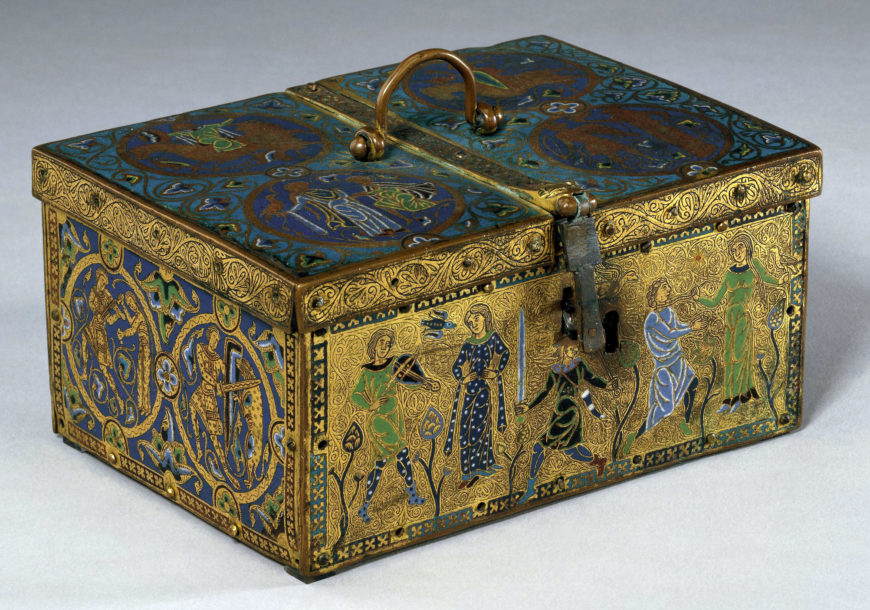
This is one of the earliest Limoges caskets made for secular use (that is, not related to the church). It is decorated with lively scenes of combat, music, dance and love.
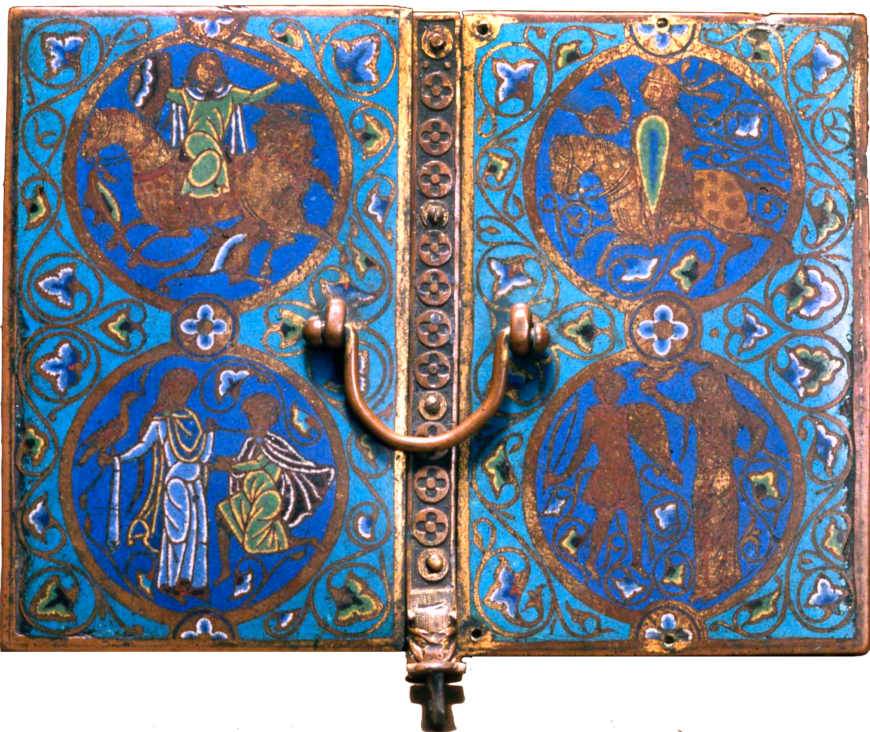
On the lid, these themes are contained within four roundels—a man on horseback is attacked by a lion (top left); a lover kneels before his lady (bottom left); a knight on horseback rides into battle (top right); a minstrel plays to a lady who holds a bird (bottom right). These images are developed on three of the four sides of the body of the casket.
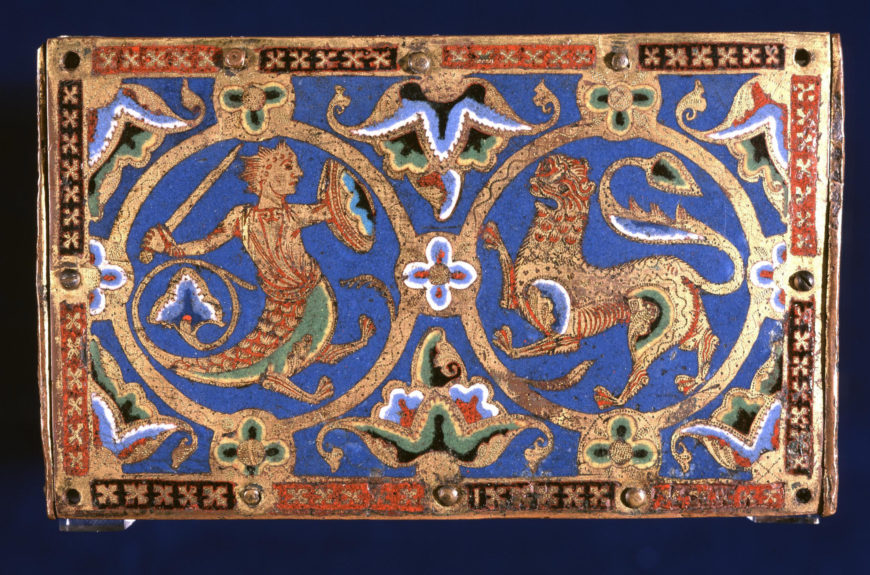
On the left side a dancer and a musician are placed alongside a combatant with a lion, while on the right side a lion and a mythical beast resembling a siren are set in opposition. The back panel is decorated with geometric and floral designs.
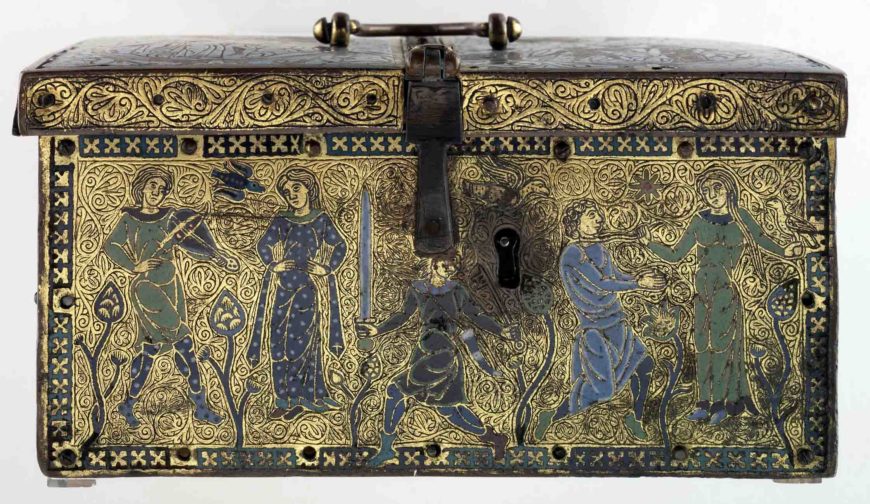
On the front of the casket two pairs of lovers display different aspects of the medieval rite of love. Birds fly around them as a minstrel plays a stringed instrument and his lady dances; a lover bends to kneel before his lady. She holds him with a halter around his neck with one hand, while with the other she holds a bird. The lover pays homage to his lady as he adopts the pose traditionally taken by a vassal before his lord. Much of the significance of these scenes is lost to a modern-day observer. The pairs of lovers are separated by a centrally placed figure, poised beneath the lock, holding a sword in one hand and a key in the other. What does this figure represent? Is he defending the contents of the casket? Or does he represent the principal theme of strength in combat versus strength in love?
Copyright: The British Museum, “Casket with troubadours,” in Smarthistory, March 2, 2021, accessed May 2, 2024, https://smarthistory.org/casket-with-troubadours/.
VISUAL ARTS
Pilgrimage Art
The pilgrimage to Santiago de Compostela
For the average European in the 12th Century, a pilgrimage to the Holy Land of Jerusalem was out of the question—travel to the Middle East was too far, too dangerous and too expensive. Santiago de Compostela in Spain offered a much more convenient option.

To this day, hundreds of thousands of faithful travel the “Way of Saint James” to the Spanish city of Santiago de Compostela. They go on foot across Europe to a holy shrine where bones, believed to belong to Saint James, were unearthed. The Cathedral of Santiago de Compostela now stands on this site.
The pious of the Middle Ages wanted to pay homage to holy relics, and pilgrimage churches sprang up along the route to Spain. Pilgrims commonly walked barefoot and wore a scalloped shell, the symbol of Saint James (the shell’s grooves symbolize the many roads of the pilgrimage).
In France alone there were four main routes toward Spain. Le Puy, Arles, Paris and Vézelay are the cities on these roads and each contains a church that was an important pilgrimage site in its own right.
Why make a pilgrimage?
A pilgrimage to Santiago de Compostela was an expression of Christian devotion and it was believed that it could purify the soul and perhaps even produce miraculous healing benefits. A criminal could travel the “Way of Saint James” as an act penance. For the everyday person, a pilgrimage was also one of the only opportunities to travel and see some of the world. It was a chance to meet people, perhaps even those outside one’s own class. The purpose of pilgrimage may not have been entirely devotional.
The cult of the relic
Pilgrimage churches can be seen in part as popular desinations, a spiritual tourism of sorts for medieval travelers. Guidebooks, badges and various souvenirs were sold. Pilgrims, though traveling light, would spend money in the towns that possessed important sacred relics.
The cult of relic was at its peak during the Romanesque period (c. 1000 – 1200). Relics are religious objects generally connected to a saint, or some other venerated person. A relic might be a body part, a saint’s finger, a cloth worn by the Virgin Mary, or a piece of the True Cross.
Relics are often housed in a protective container called a reliquary. Reliquarys are often quite opulent and can be encrusted with precious metals and gemstones given by the faithful. An example is the Reliquary of Saint Foy, located at Conques abbey on the pilgrimage route. It is said to hold a piece of the child martyr’s skull. A large pilgrimage church might be home to one major relic, and dozens of lesser-known relics. Because of their sacred and economic value, every church wanted an important relic and a black market boomed with fake and stolen goods.

Accommodating crowds
Pilgrimage churches were constructed with some special features to make them particularly accessible to visitors. The goal was to get large numbers of people to the relics and out again without disturbing the Mass in the center of the church. A large portal that could accommodate the pious throngs was a prerequisite. Generally, these portals would also have an elaborate sculptural program, often portraying the Second Coming—a good way to remind the weary pilgrim why they made the trip!
A pilgrimage church generally consisted of a double aisle on either side of the nave (the wide hall that runs down the center of a church). In this way, the visitor could move easily around the outer edges of the church until reaching the smaller apsidioles or radiating chapels. These are small rooms generally located off the back of the church behind the altar where relics were often displayed. The faithful would move from chapel to chapel venerating each relic in turn.
Copyright: Christine M. Bolli, “Pilgrimage routes and the cult of the relic,” in Smarthistory, August 8, 2015, accessed May 2, 2024, https://smarthistory.org/pilgrimage-routes-and-the-cult-of-the-relic/.
Stained Glass
Video URL: https://youtu.be/vigjJih8Pn4?si=v60RgPKrlFl1bcs8
Copyright: Dr. Beth Harris and Dr. Steven Zucker, “Sainte-Chapelle, Paris,” in Smarthistory, May 24, 2017, accessed May 2, 2024, https://smarthistory.org/sainte-chapelle-paris/.
Maestas- Virgin Mary and Jesus
CImabue, Maesta (Santa Trinita Madonna and Child Enthroned), 1280-1290
Video URL: https://youtu.be/ZAY4mF1mNlc?si=DZ8Xg-7e5fZwwkeb
Copyright: Dr. Holly Flora, “Cimabue, Virgin and Child Enthroned, and Prophets (Santa Trinita Maestà),” in Smarthistory, November 4, 2020, accessed May 8, 2024, https://smarthistory.org/cimabue-maesta/.
Giotto, The Ognissanti Madonna (Virgin and Child Enthroned), 1308-1310
Video URL: https://youtu.be/0CWpG3GVtA8?si=dHnW9Kgh4NVOXnSb
Coypright: Khan Academy
Duccio, Maesta, 1308-1311
Video URL: https://youtu.be/kMVg53FDx-g?si=GsMysFv4sP4AwIo9
Copyright: Dr. Beth Harris and Dr. Steven Zucker, “Duccio, Maestà,” in Smarthistory, June 18, 2022, accessed May 8, 2024, https://smarthistory.org/duccio-maesta/.
Simone Marini, Maesta, 1315-1321
Video URL: https://youtu.be/JJ_UzZ3txf0?si=S_DyMPDXsQgdEJ8_
Copyright: Dr. Beth Harris and Dr. Steven Zucker, “Simone Martini, Maestà,” in Smarthistory, December 3, 2021, accessed May 8, 2024, https://smarthistory.org/simone-martini-maesta/.
Comparing Cimabue and Giotto
Video URL: https://youtu.be/DKnFvXmUlOI?si=EfSKDrH0-DtXhztT
Copyright: Dr. Steven Zucker and Dr. Beth Harris, “Cimabue and Giotto compared,” in Smarthistory, December 11, 2015, accessed May 8, 2024, https://smarthistory.org/cimabue-santa-trinita-madonna-and-giotto-ognissanti-madonna/.
Government Art
Video URL: https://youtu.be/jk3wNadYA7k?si=eStl0EuE3AaaK3wc
Copyright: Khan Academy Creative Commons Attribution/Non-Commercial/Share-Alike
Bayeux Tapestry
Measuring twenty inches high and almost 230 feet in length, the Bayeux Tapestry commemorates a struggle for the throne of England between William, the Duke of Normandy, and Harold, the Earl of Wessex. The year was 1066—William invaded and successfully conquered England, becoming the first Norman King of England (he was also known as William the Conqueror).
The Bayeux Tapestry consists of seventy-five scenes with Latin inscriptions (tituli) depicting the events leading up to the Norman conquest and culminating in the Battle of Hastings in 1066. The textile’s end is now missing, but it most probably showed the coronation of William as King of England.
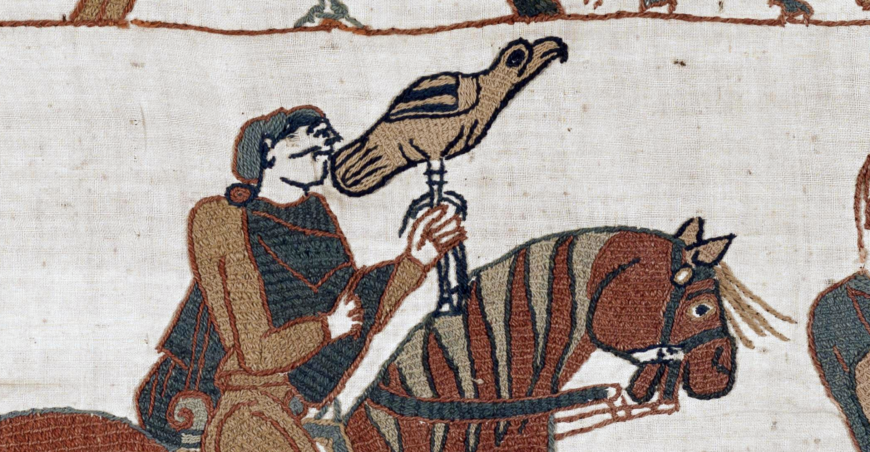
Although it is called the Bayeux Tapestry, this commemorative work is not a true tapestry as the images are not woven into the cloth; instead, the imagery and inscriptions are embroidered using wool yarn sewed onto linen cloth.
The tapestry is sometimes viewed as a type of chronicle. However, the inclusion of episodes that do not relate to the historic events of the Norman Conquest complicate this categorization. Nevertheless, it presents a rich representation of a particular historic moment as well as providing an important visual source for eleventh-century textiles that have not survived into the twenty-first century.
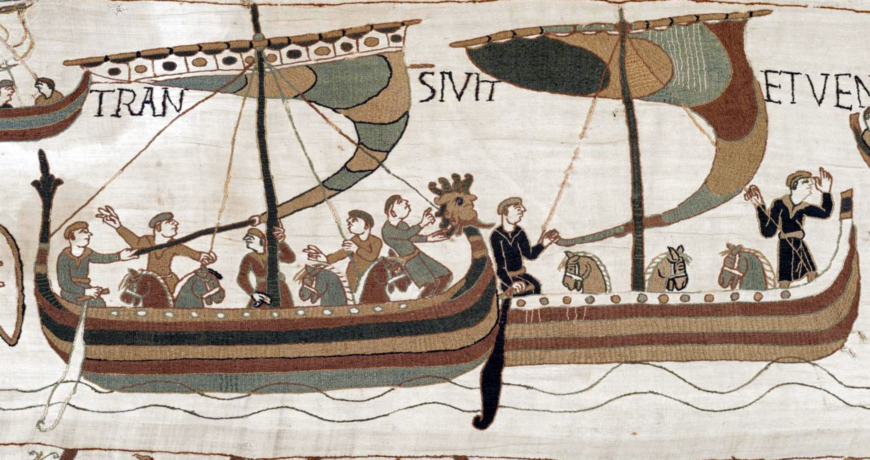
The Bayeux Tapestry was probably made in Canterbury around 1070. Because the tapestry was made within a generation of the Norman defeat of the Anglo-Saxons, it is considered to be a somewhat accurate representation of events. Based on a few key pieces of evidence, art historians believe the patron was Odo, Bishop of Bayeux. Odo was the half-brother of William, Duke of Normandy. Furthermore, the tapestry favorably depicts the Normans in the events leading up to the battle of Hastings, thus presenting a Norman point of view.
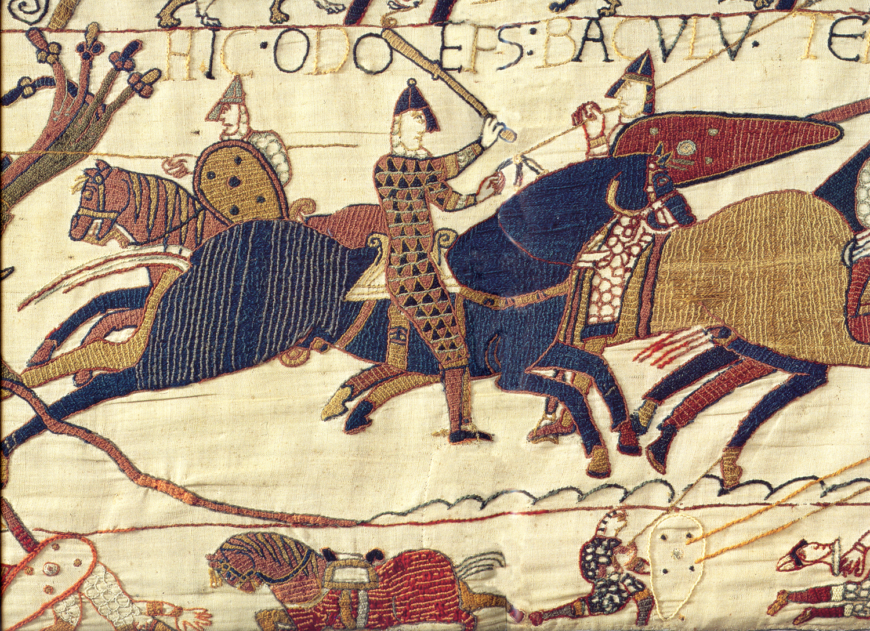
Most importantly, Odo appears in several scenes in the tapestry with the inscription ODO EPISCOPUS (abbreviated “EPS” in the image above), although he is only mentioned briefly in textual sources. By the late Middle Ages, the tapestry was displayed at Bayeux Cathedral, which was built by Odo and dedicated in 1077, but its size and secular subject matter suggest that it may have been intended to be a secular hanging, perhaps in Odo’s hall.
We do not know the identity of the artists who produced the tapestry. The high quality of the needlework suggests that Anglo-Saxon embroiderers produced the tapestry. At the time, Anglo-Saxon needlework was prized throughout Europe. This theory is supported by stylistic analysis of the depicted scenes, which draw from Anglo-Saxon drawing techniques. Many of the scenes are believed to have been adapted from images in manuscripts illuminated at Canterbury.
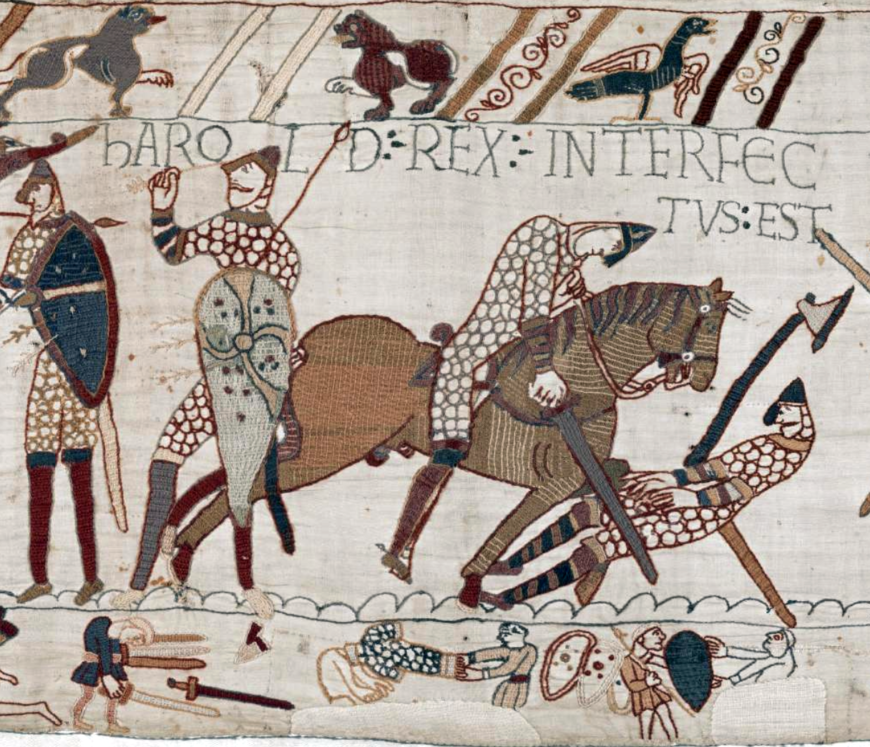
The artists skillfully organized the composition of the tapestry to lead the viewer’s eye from one scene to the next and divided the compositional space into three horizontal zones. The main events of the story are contained within the larger middle zone. The upper and lower zones contain images of animals and people, scenes from Aesop’s Fables, and scenes of husbandry and hunting. At times the images in the borders interact with and draw attention to key moments in the narrative (as in the image above of the battle).
The seventy-five episodes depicted present a continuous narrative of the events leading up to the Battle of Hastings and the battle itself. A continuous narrative presents multiple scenes of a narrative within a single frame and draws from manuscript traditions such as the scroll form. The subject matter of the tapestry, however, has more in common with ancient monumental decoration such as Trajan’s Column, which typically focused on mythic and historical references.
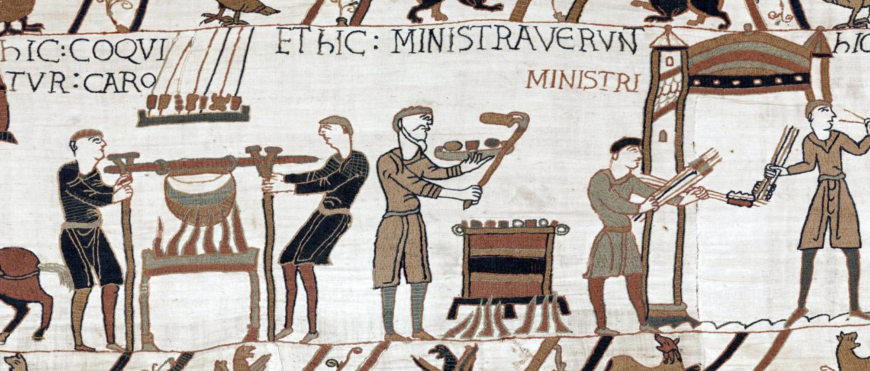
The embroiderers’ attention to specific details provides important sources for scenes of eleventh-century life as well as objects that no longer survive. In one scene of the Normans’ first meal after reaching the shores of England, we see dining practices. We also see examples of armor used in the period and battle preparations. To the left of the dining scene, servants prepare food over a fire and bake bread in an outdoor oven (above). Servants serve the food as the tapestry’s assumed patron, Bishop Odo, blesses the meal (below).
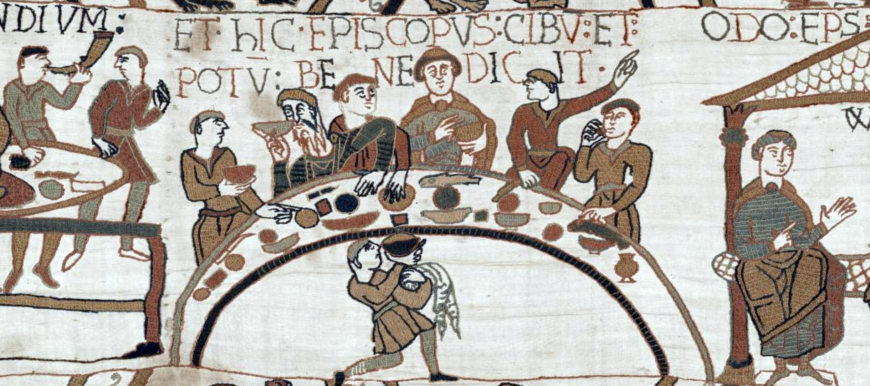
Immediately after dining, William and his half-brothers Odo and Robert meet for a war council. Preparations for battle flank both sides of the first meal episode (below).
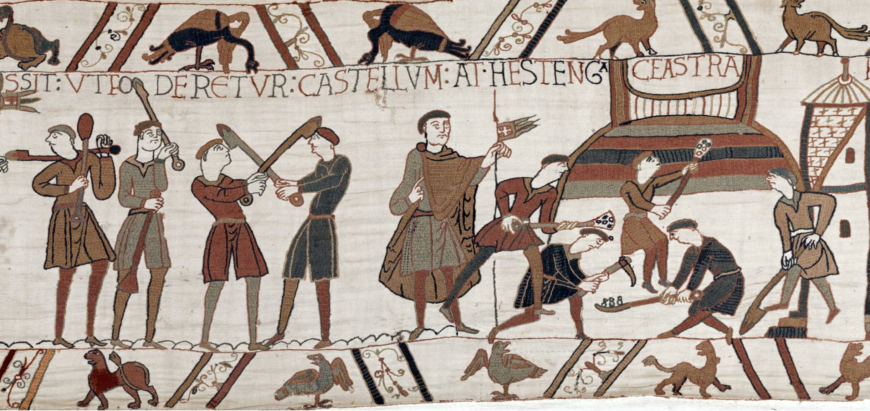
Here we see visual evidence of eleventh-century battle gear and the construction of a motte-and-bailey to protect the Normans’ position. A motte-and-bailey is a fortification with a keep (tower) situated on a raised earthwork (motte), surrounded by an enclosed courtyard (bailey). Images of battle horns, shields, and arrows as crucial ammunition shed light on military provisions and tactics for the time period.
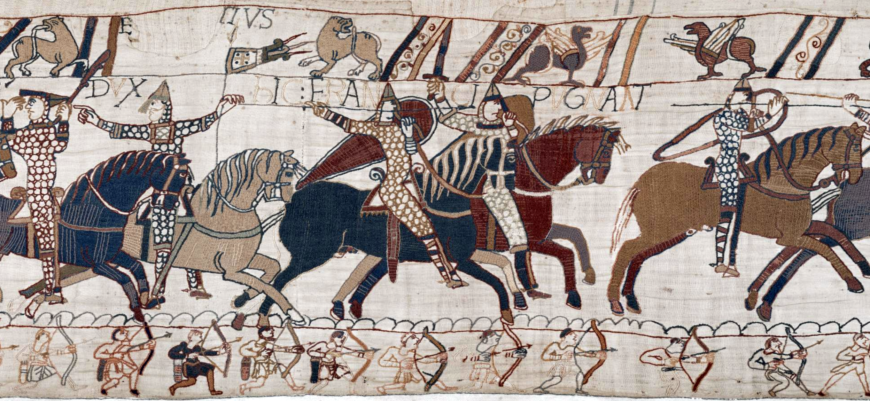
William’s tactical use of cavalry is displayed in the “Cavalry” scene. The cavalry could advance quickly and easily retreat, which would scatter an opponent’s defenses allowing the infantry to invade. It was a strong tactic that was flexible and intimidating. Although foot soldiers are included in the tapestry, the cavalry commands the scene, thus presenting the impression that the Normans were a cavalry-dominant army.
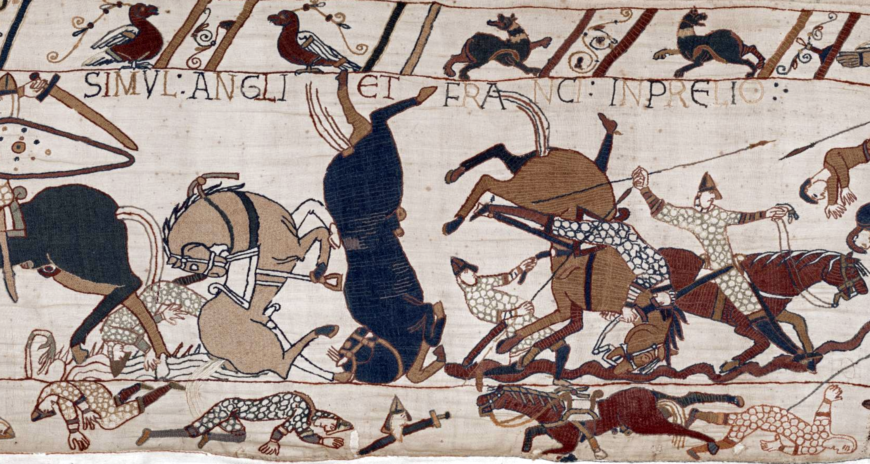
In addition to depicting military tactics used in the Norman Conquest, the scene also provides visual evidence for eleventh-century battle gear. Cavalrymen are shown wearing conical steel helmets with a protective nose plate, mail shirts, and carrying shields and spears whereas the foot soldiers are seen carrying spears and axes. Representations of the cavalry show that the soldiers were armored but the horses were not. The brutality of war is evident in the battle scenes. Figures of mortally wounded men and horses are strewn along the tapestry’s lower zone as well as within the main central zone.
The Bayeux Tapestry provides an excellent example of Anglo-Norman art. It serves as a medieval artifact that operates as art, chronicle, political propaganda, and visual evidence of eleventh-century mundane objects, all at a monumental scale. This astounding work continues to fascinate.
Copyright: Dr. Kristine Tanton, “The Bayeux Tapestry,” in Smarthistory, August 8, 2015, accessed May 2, 2024, https://smarthistory.org/the-bayeux-tapestry/.

